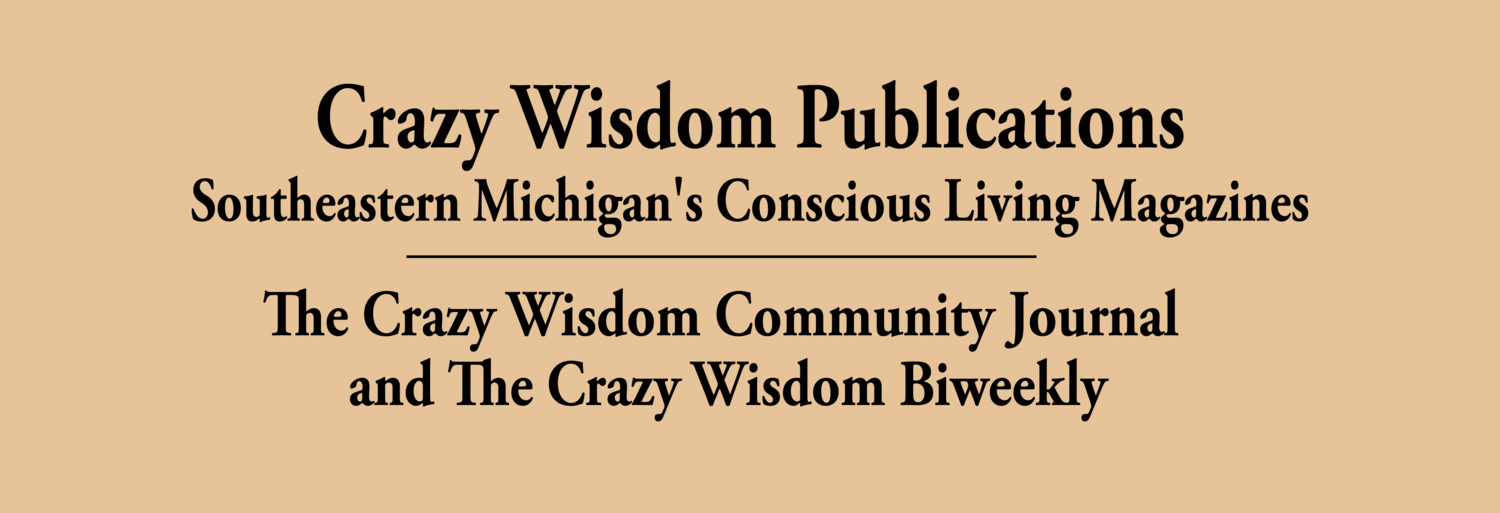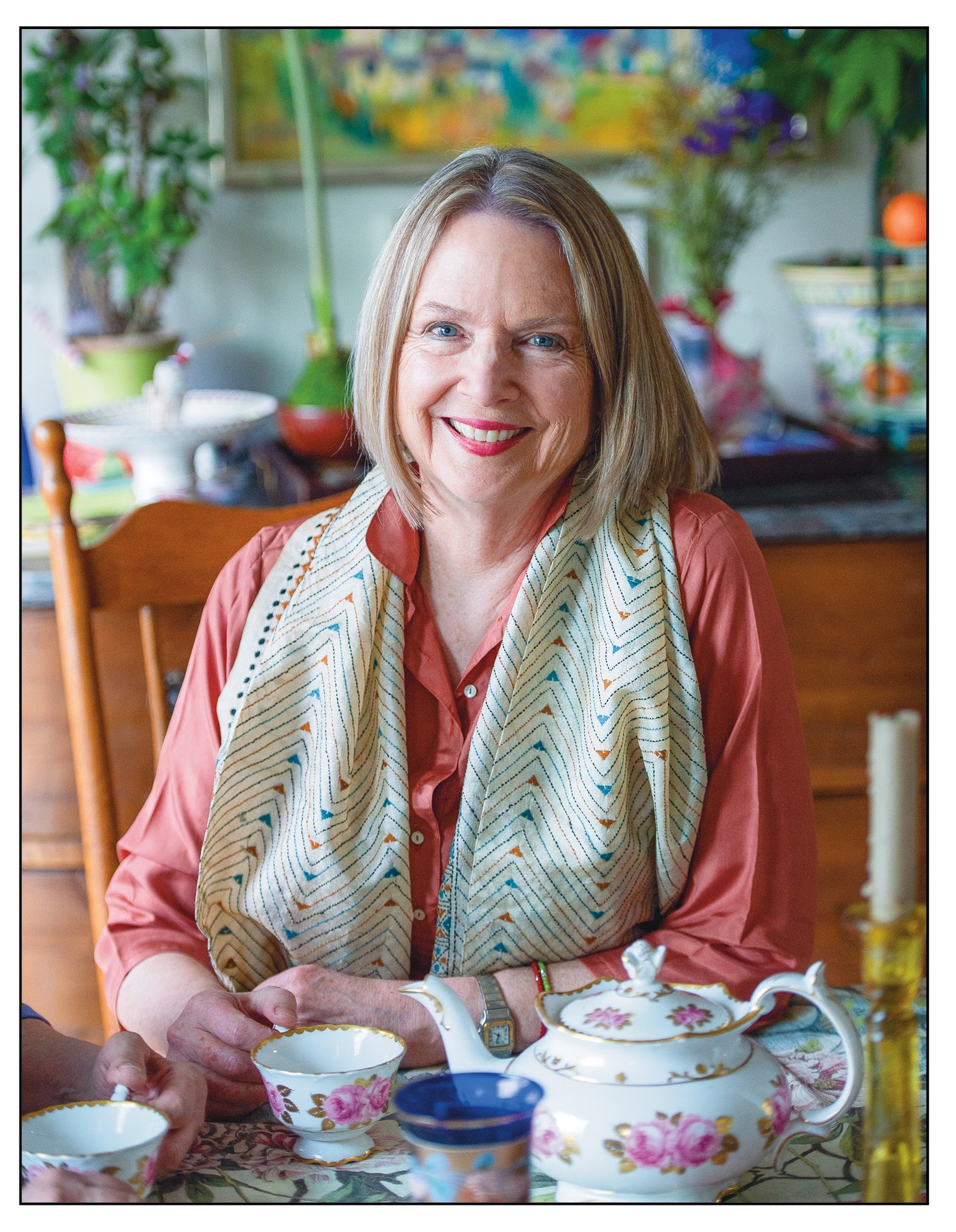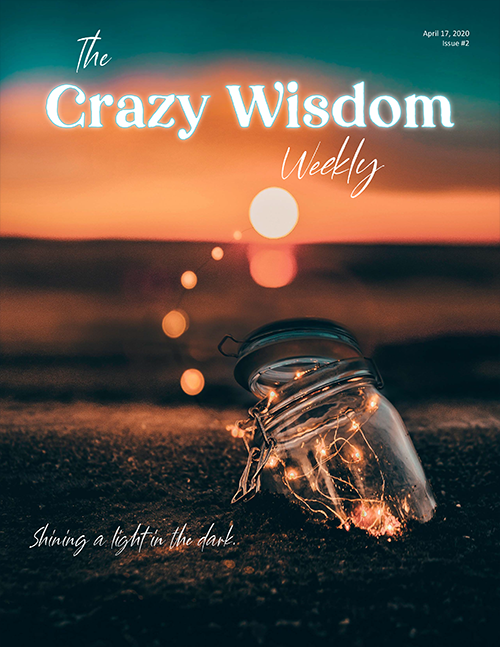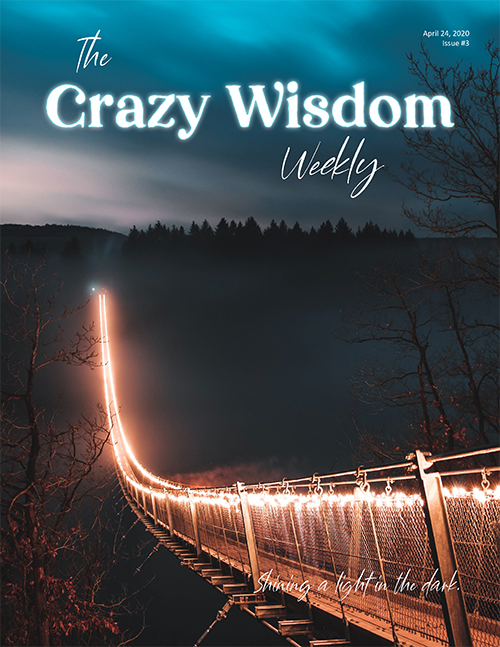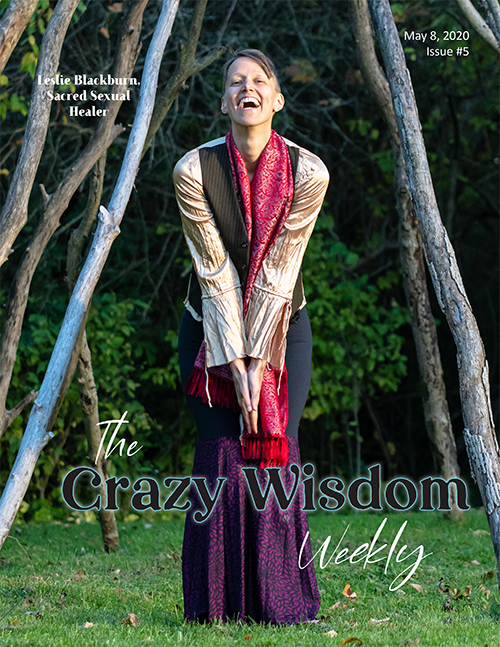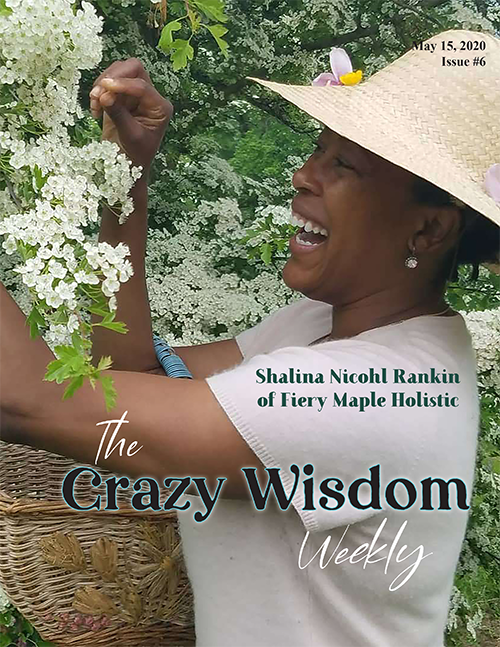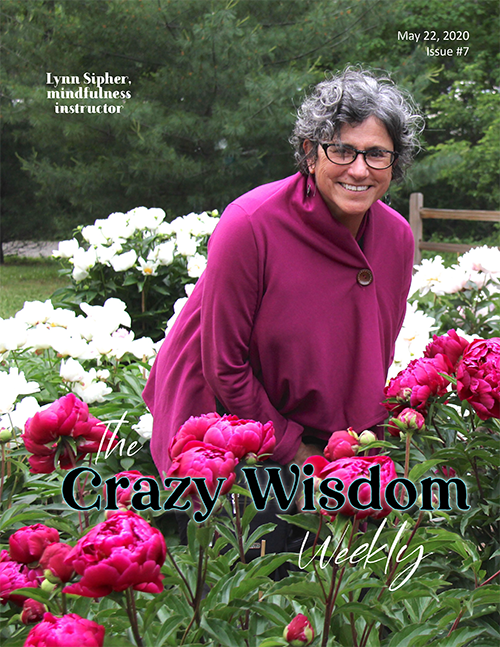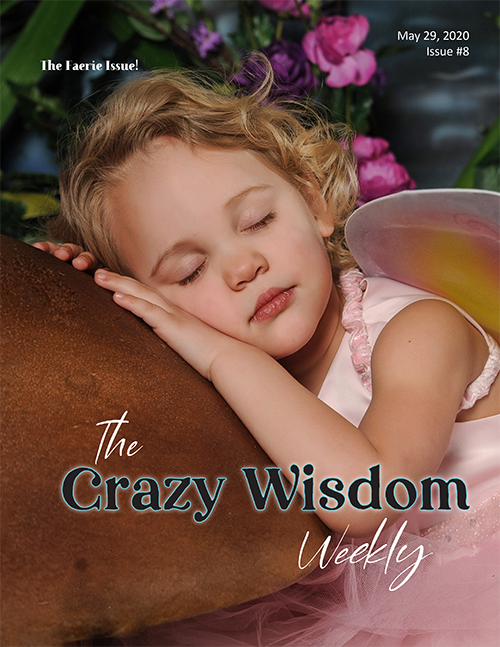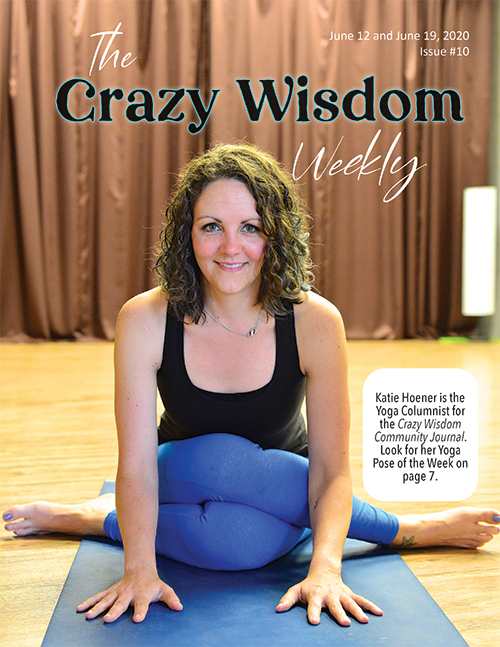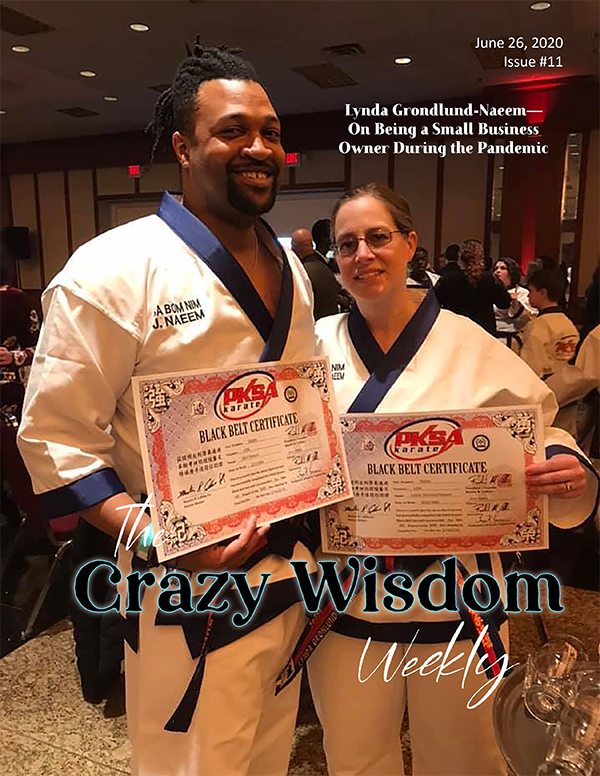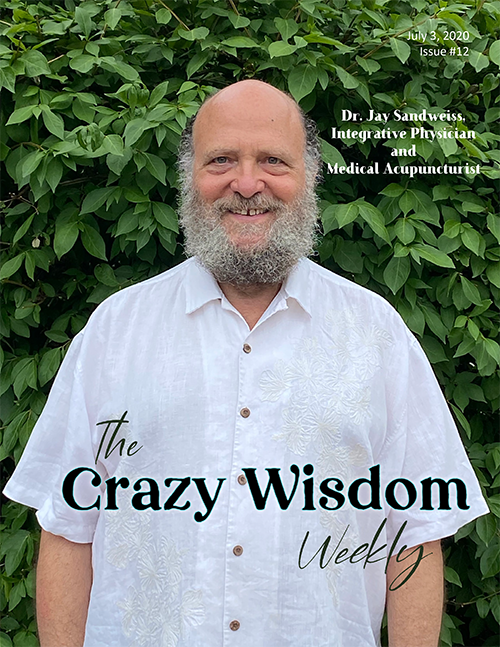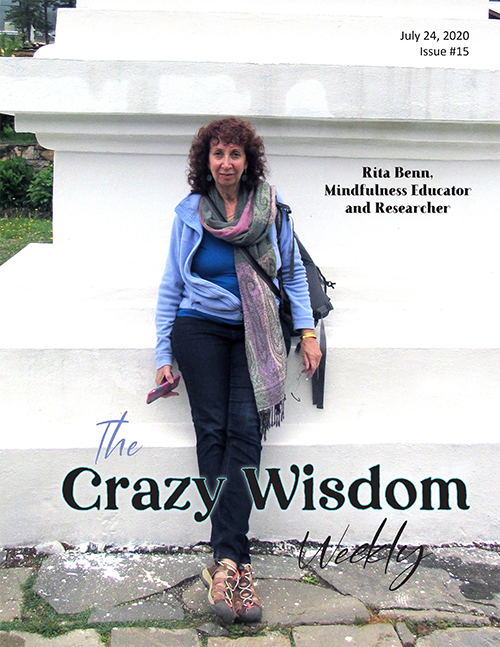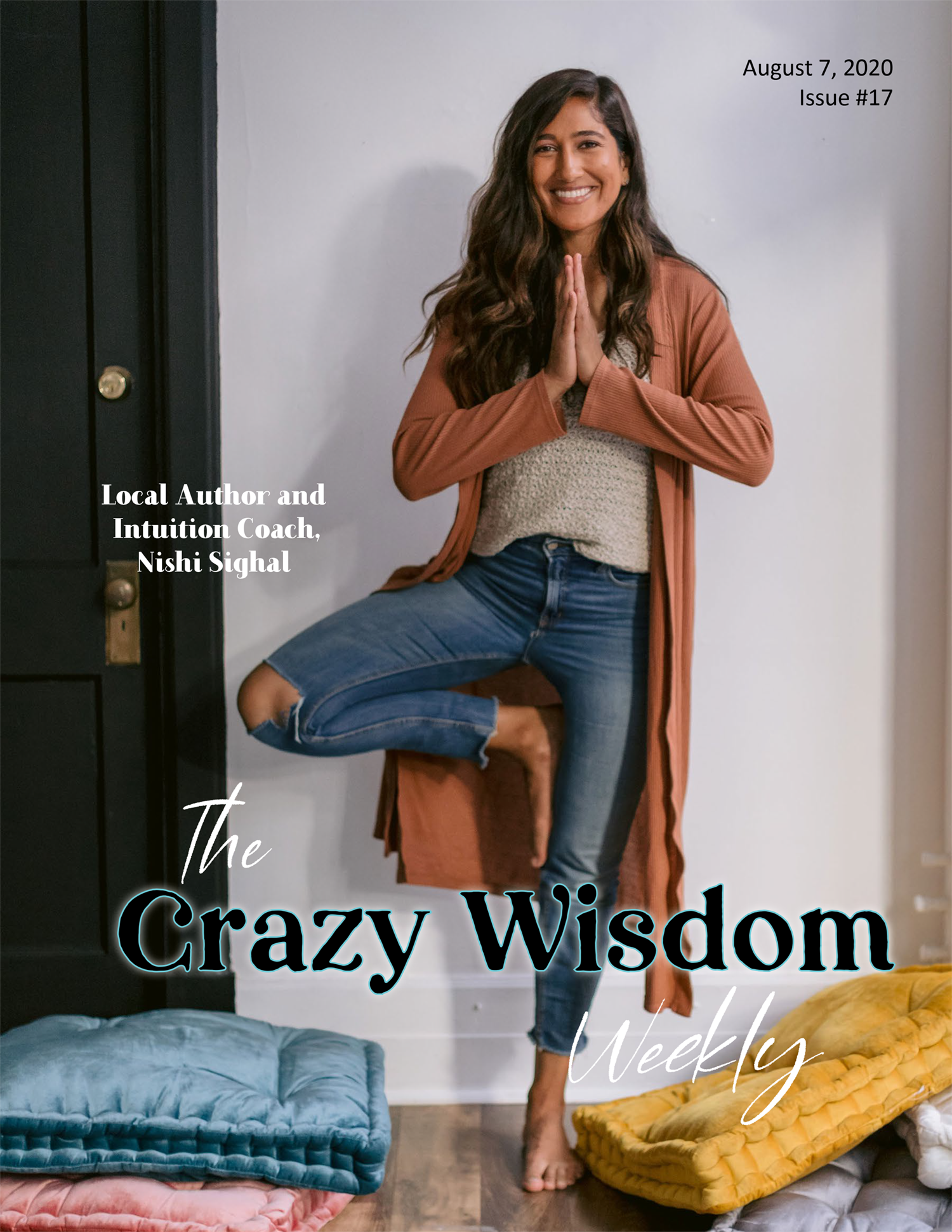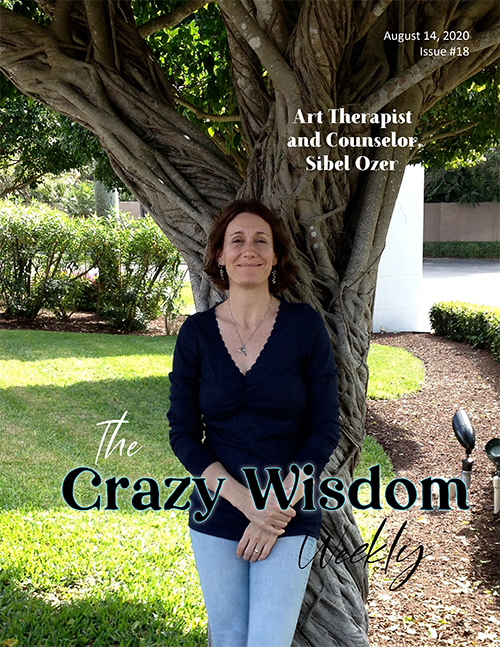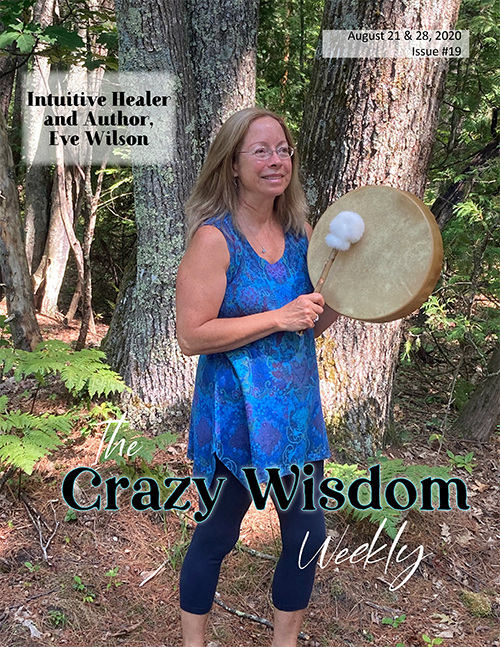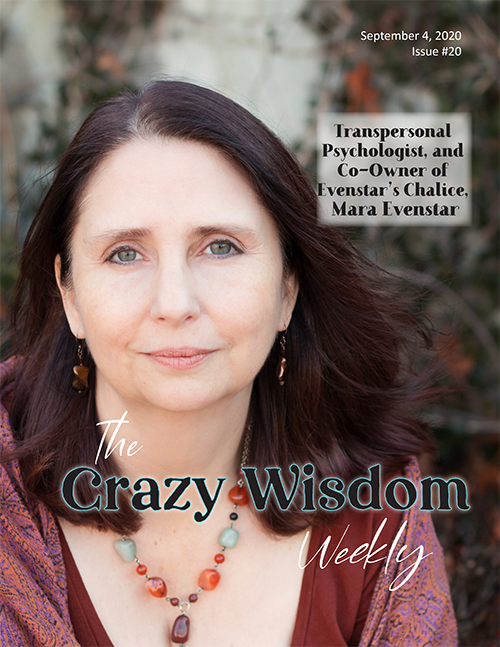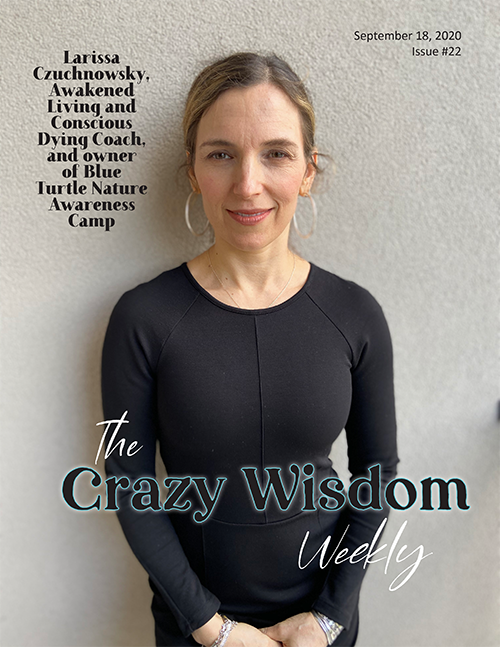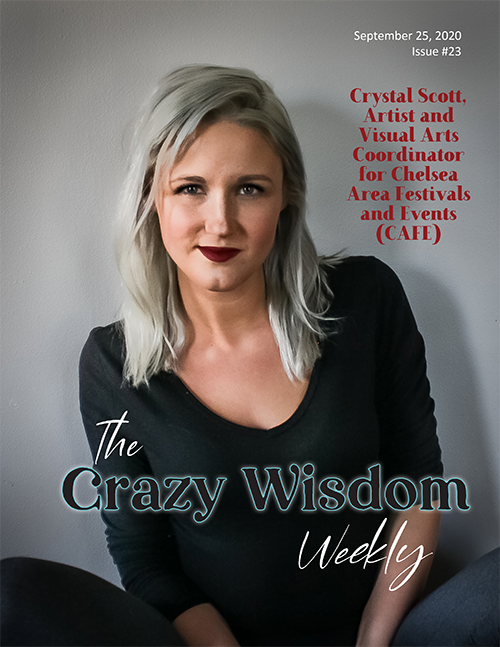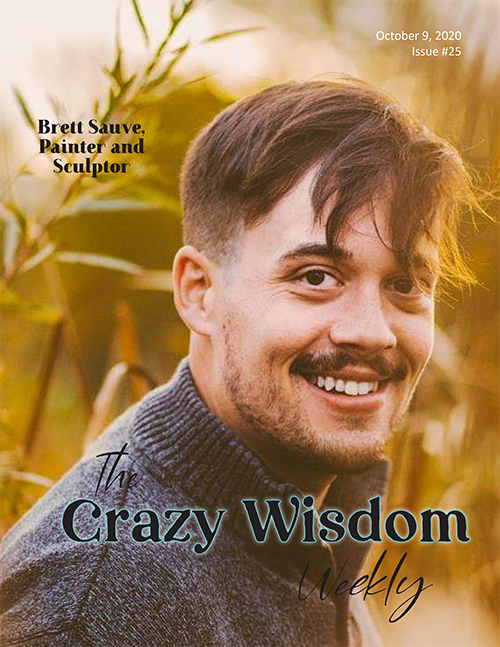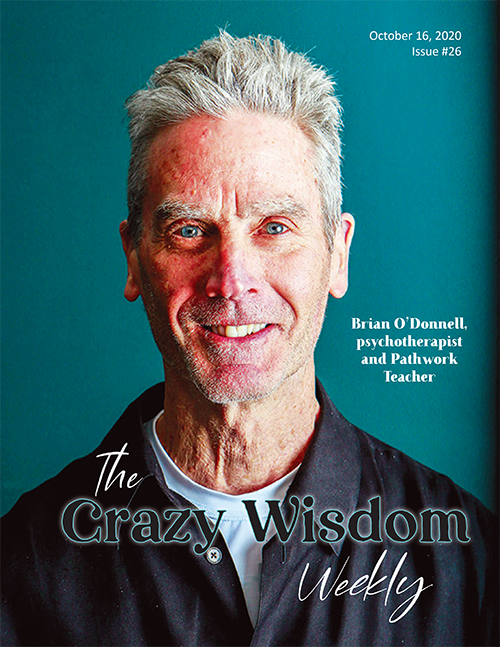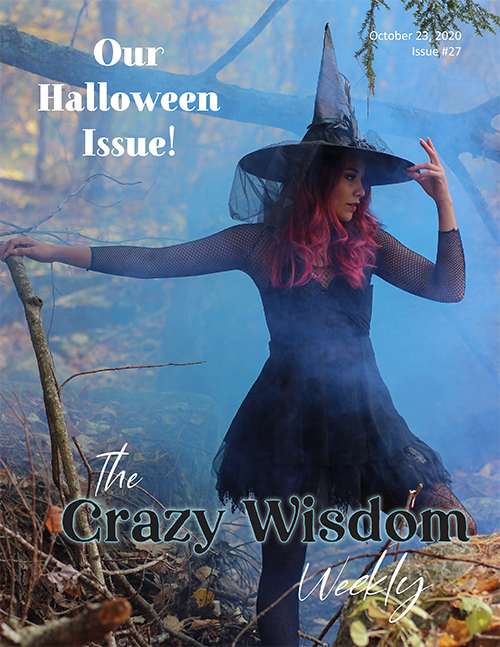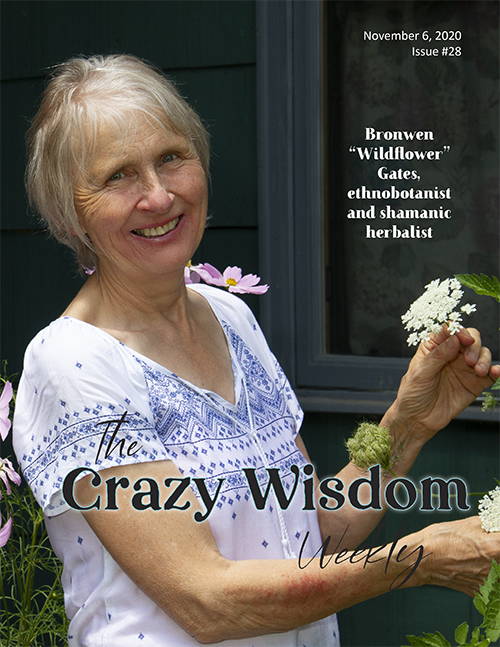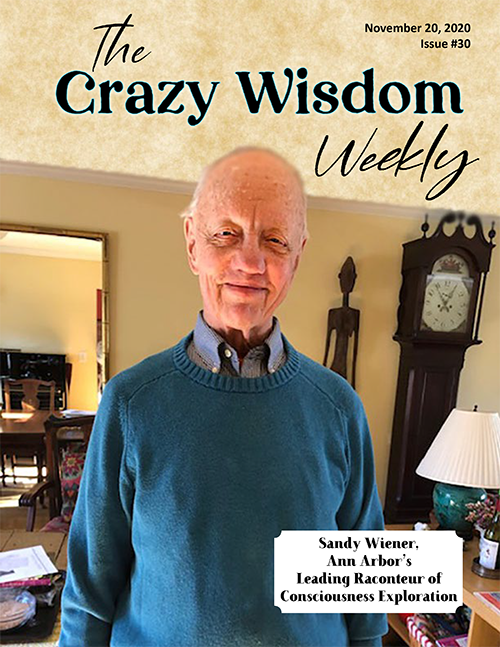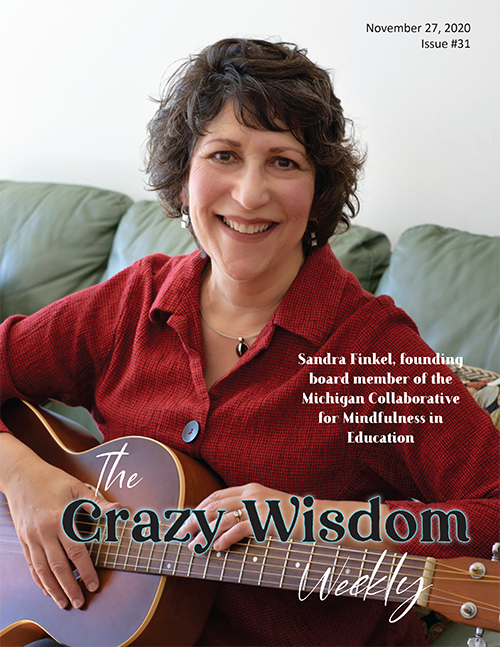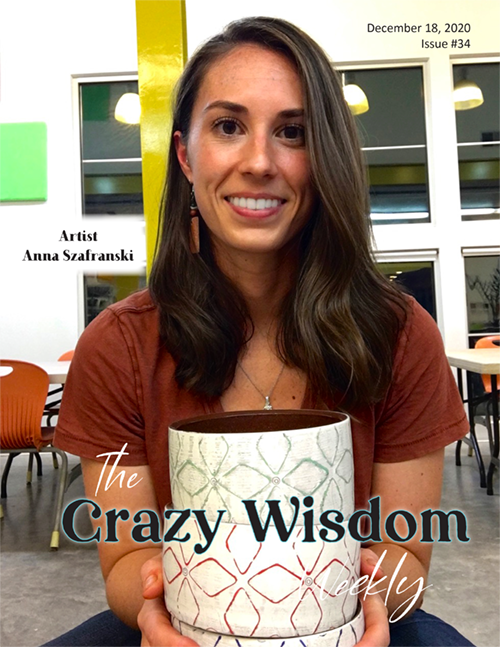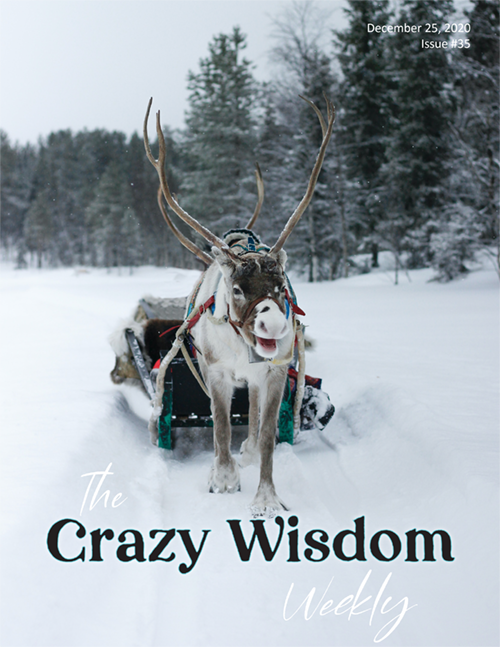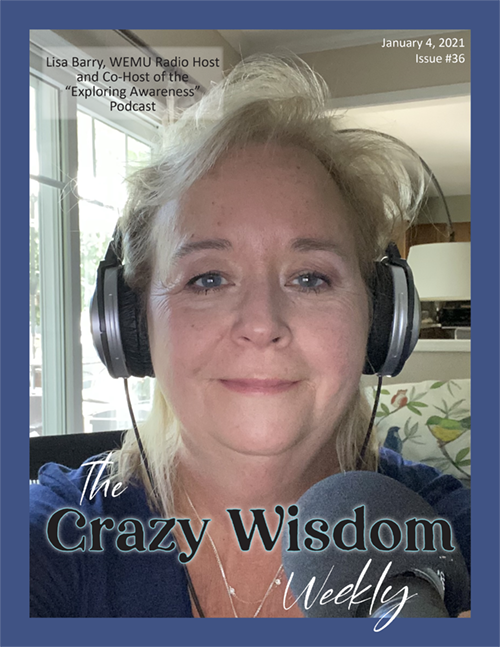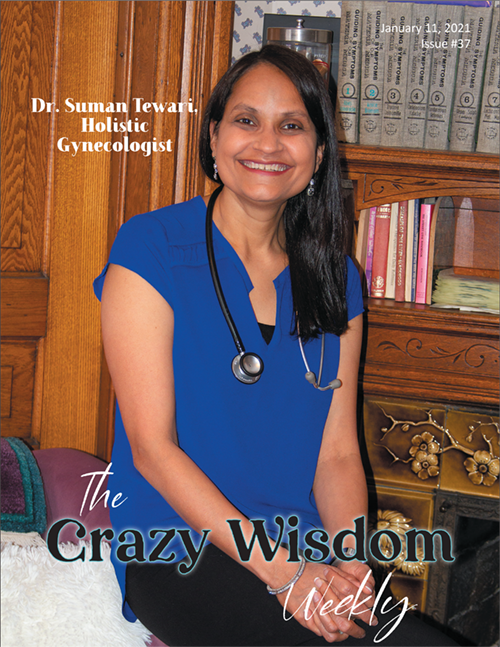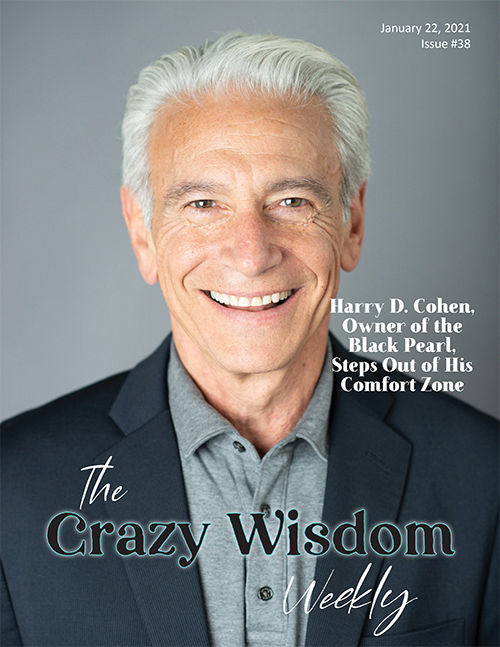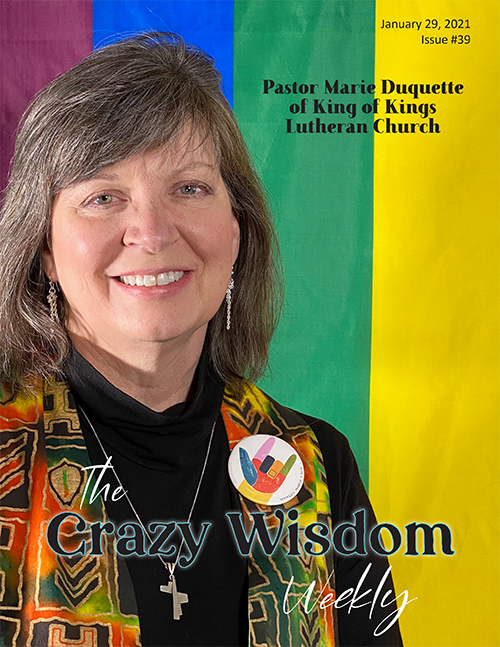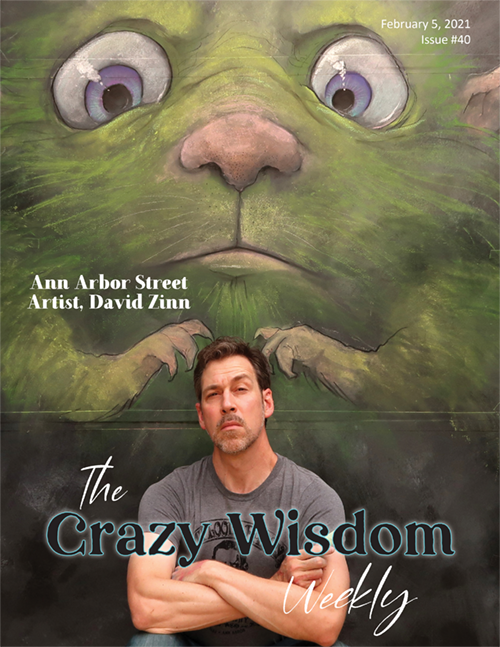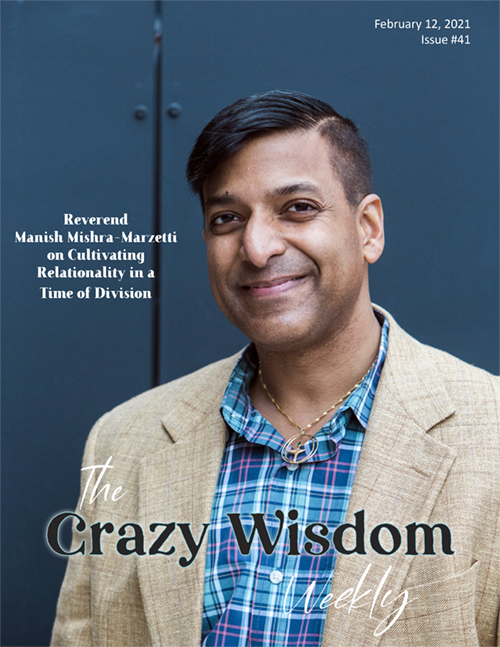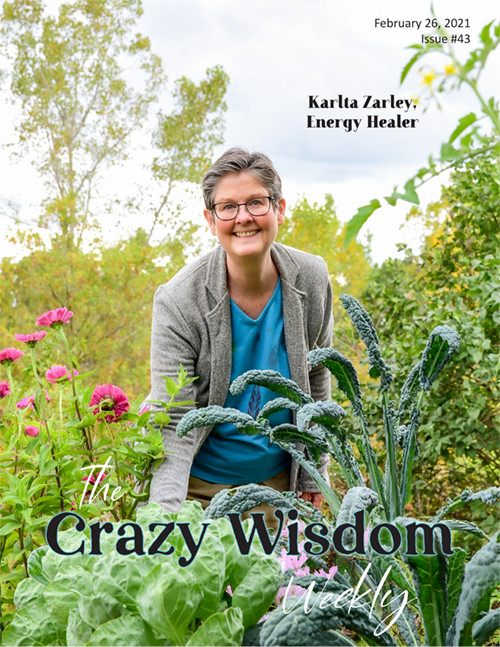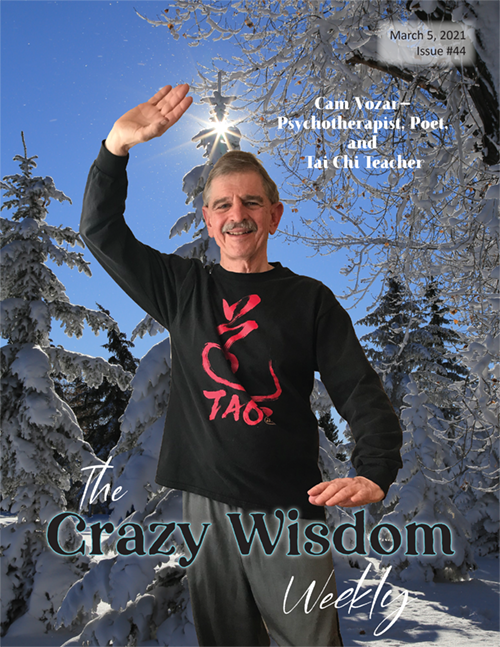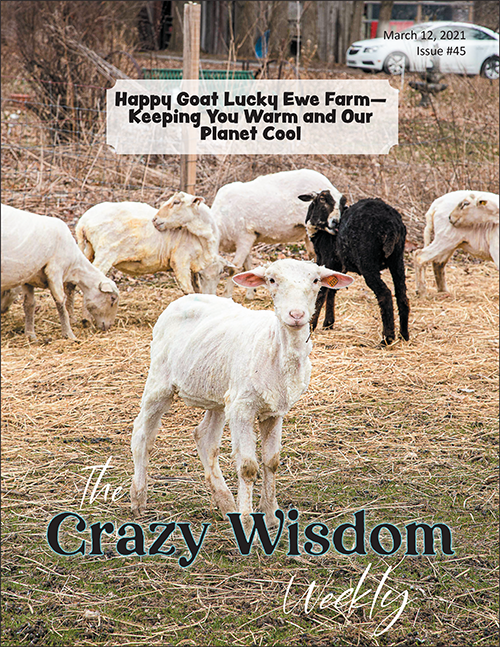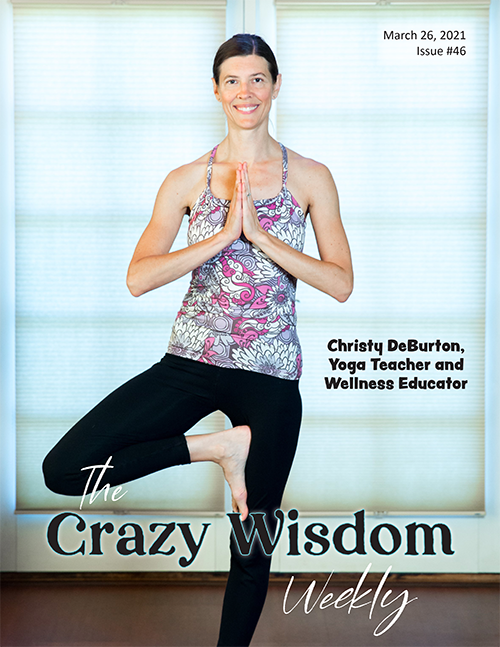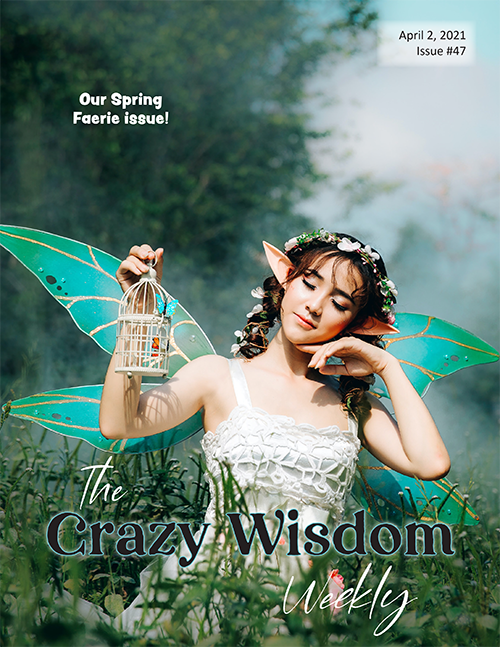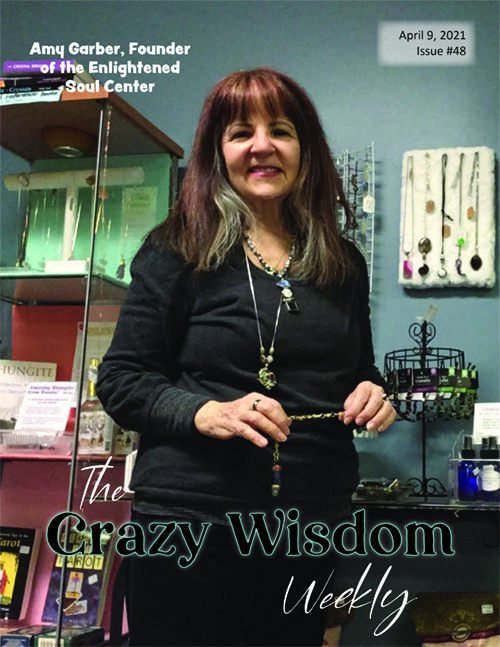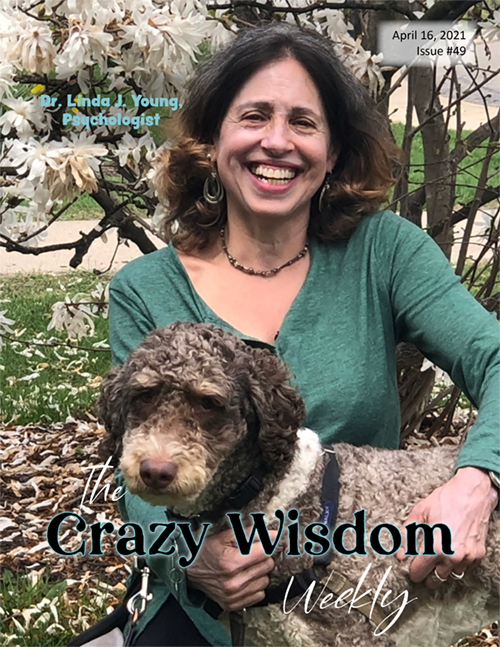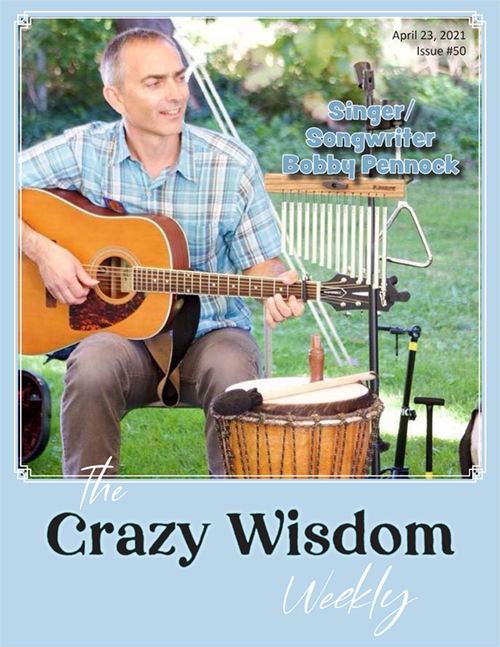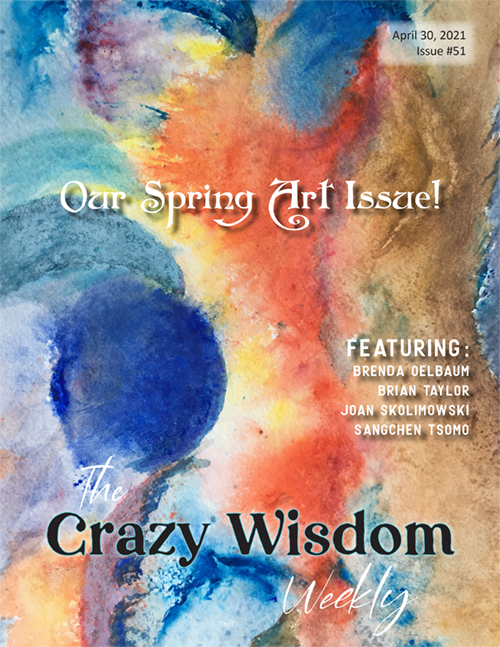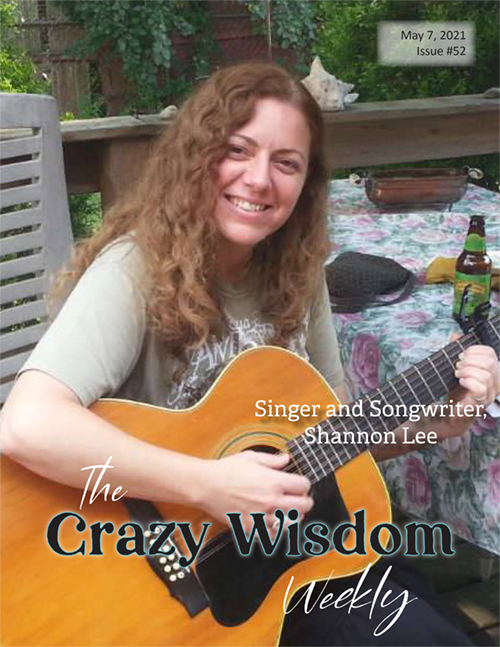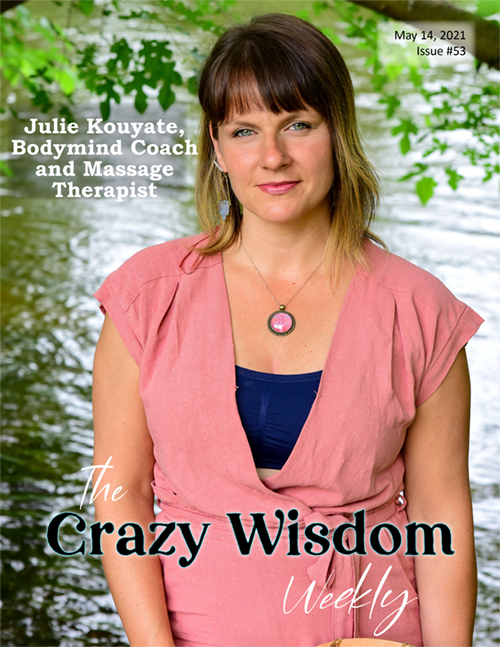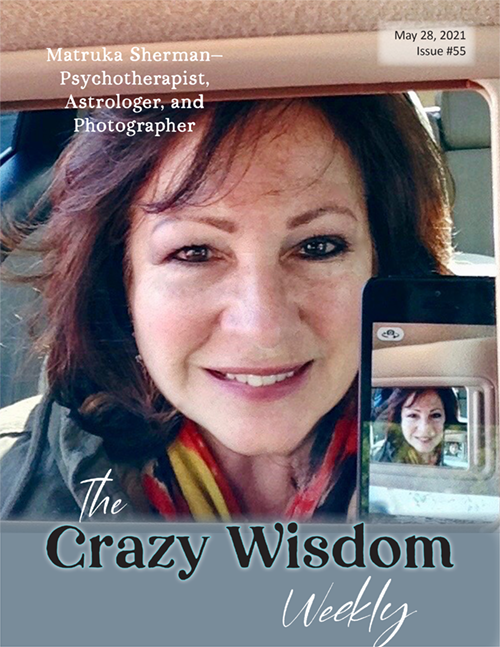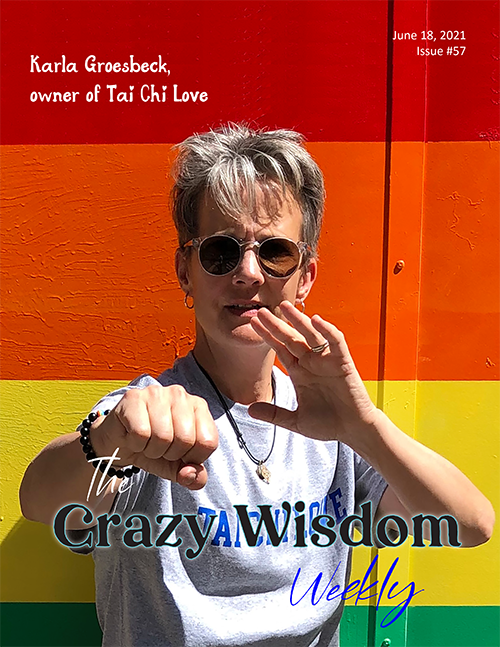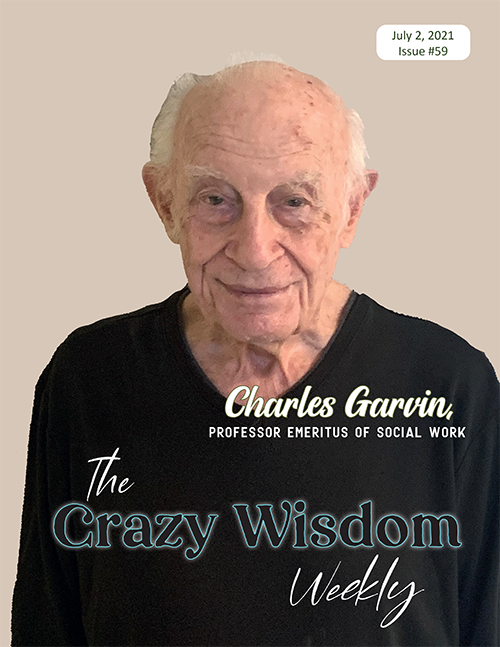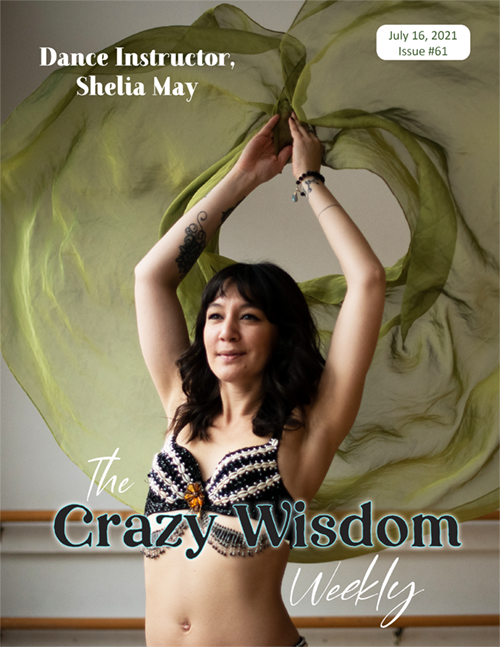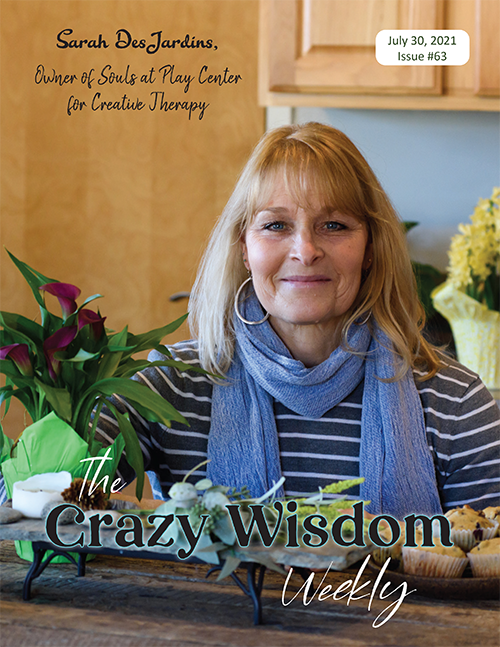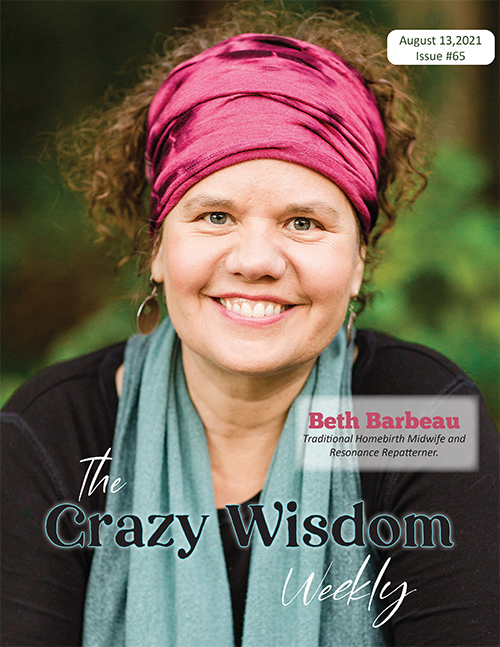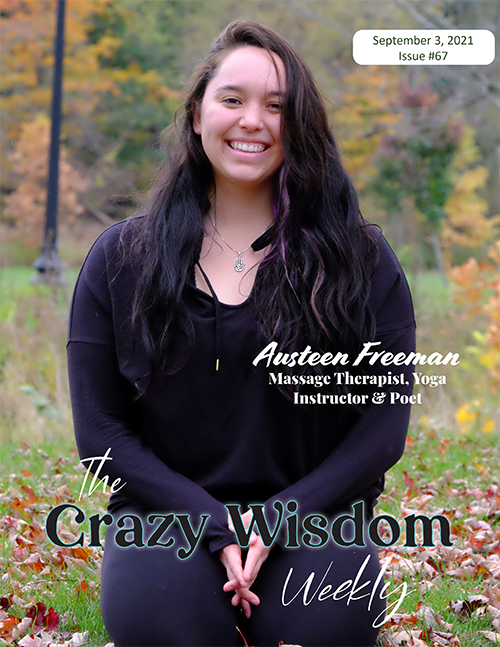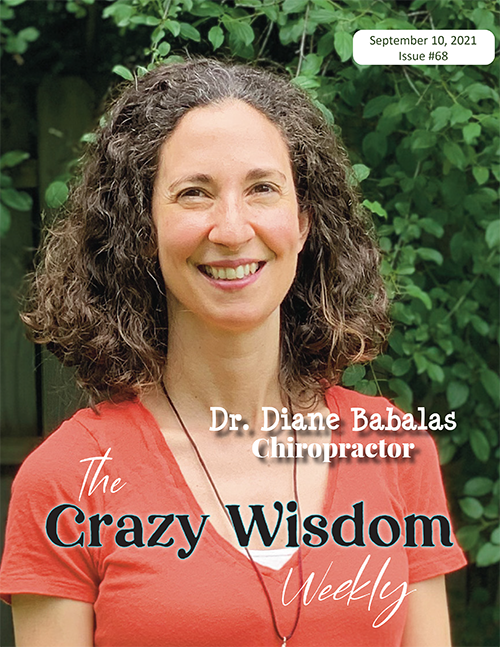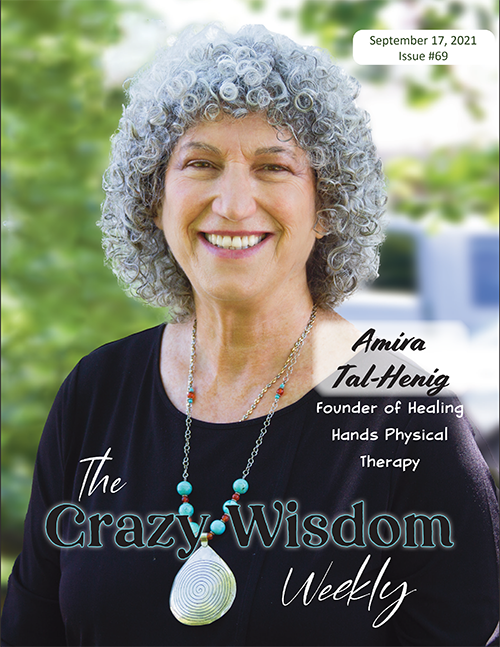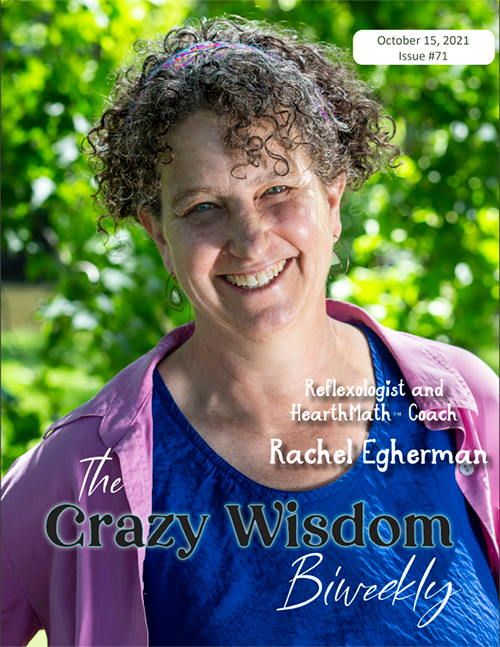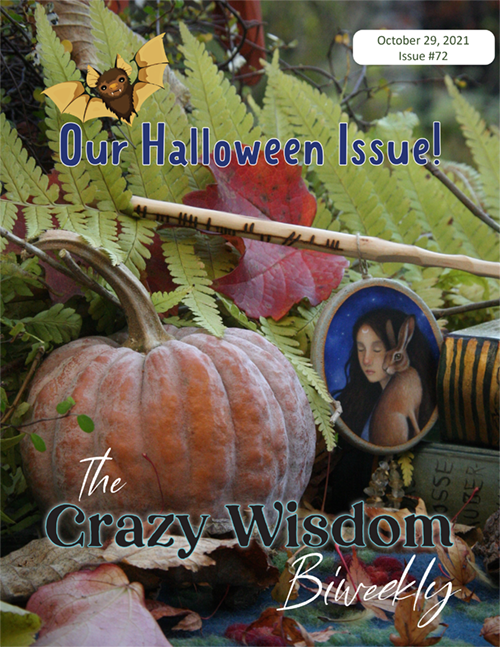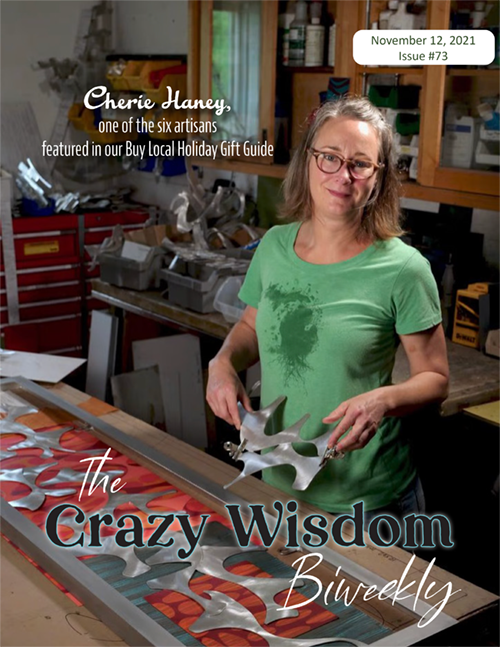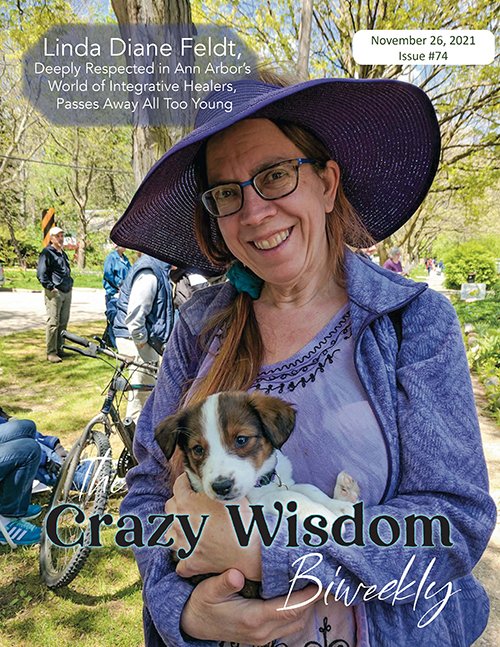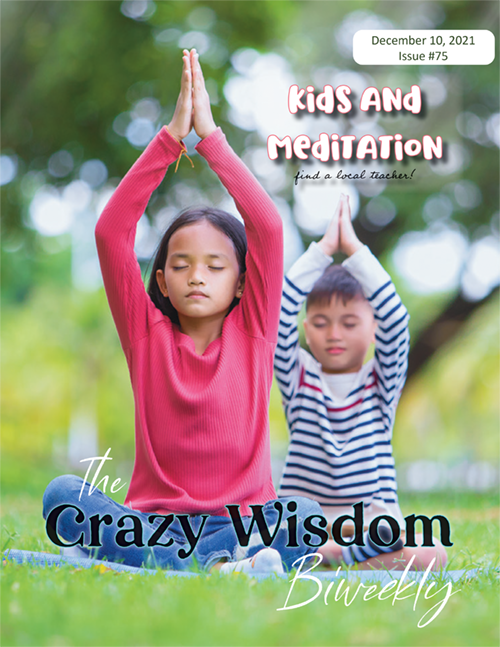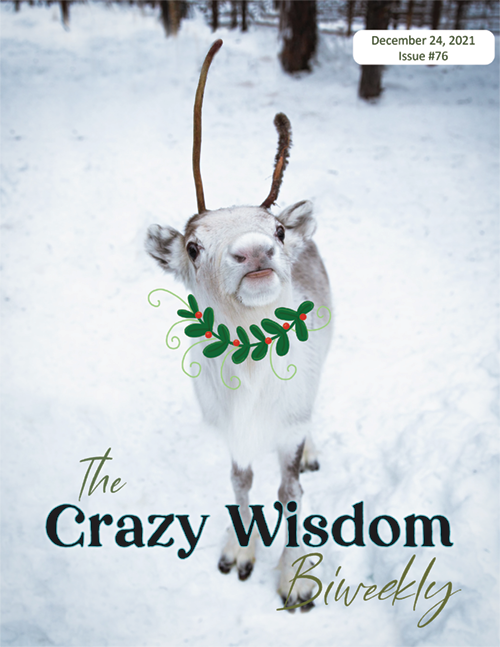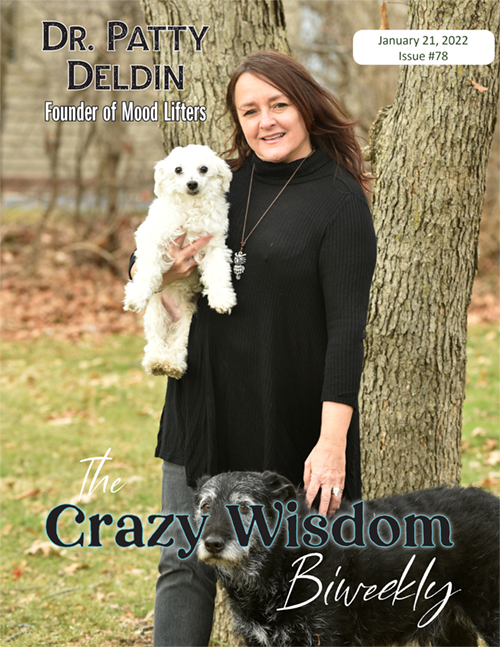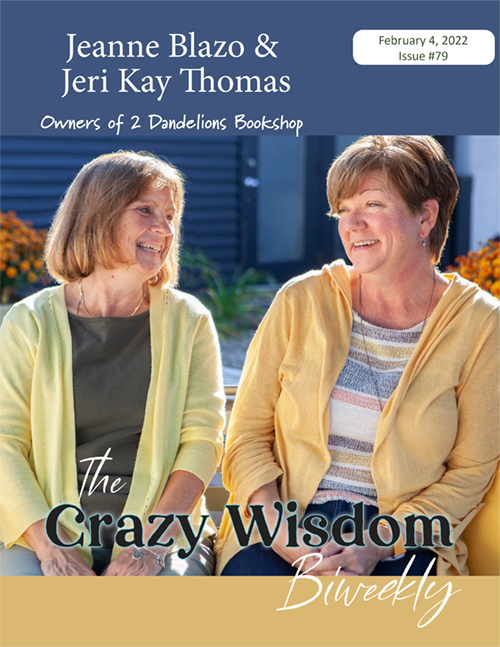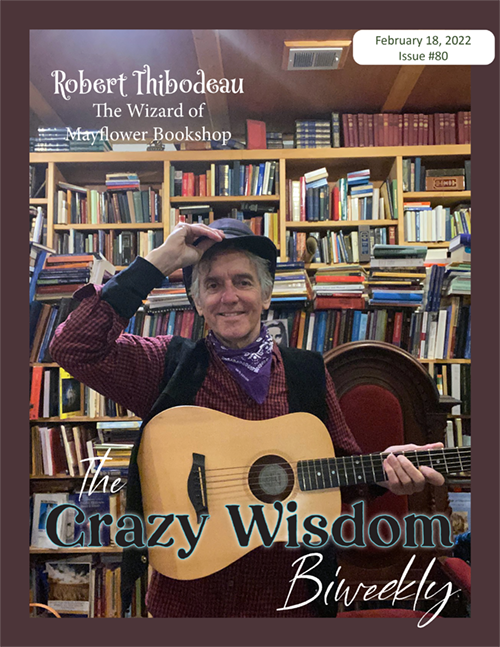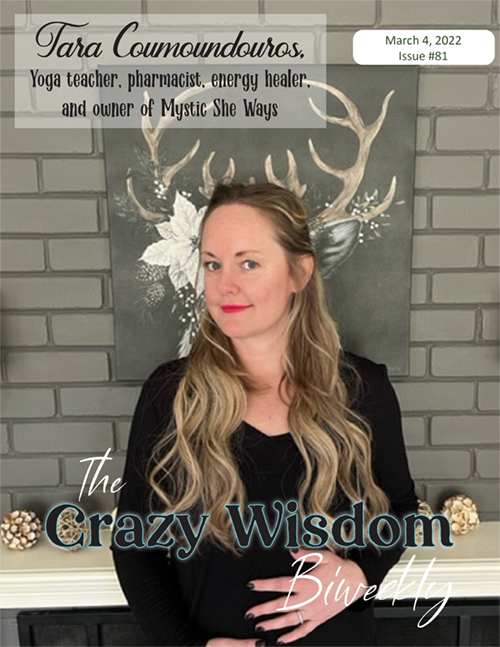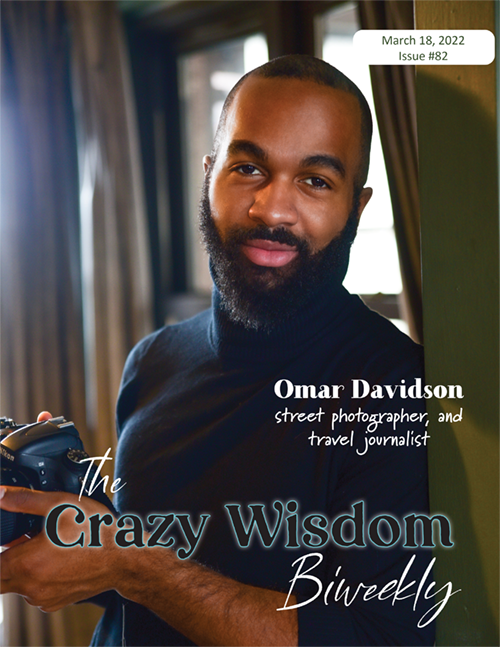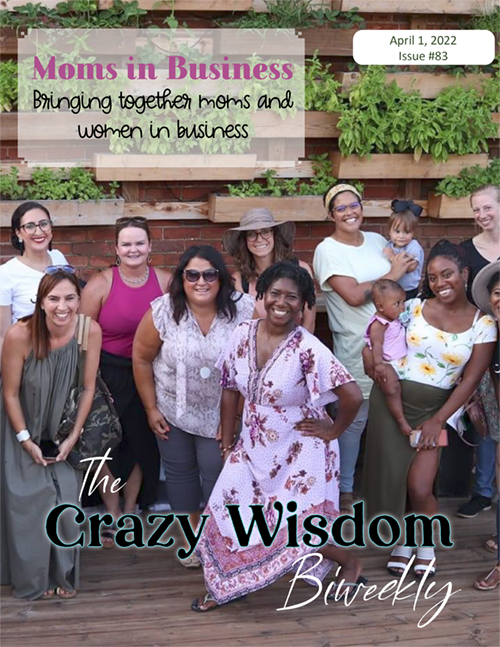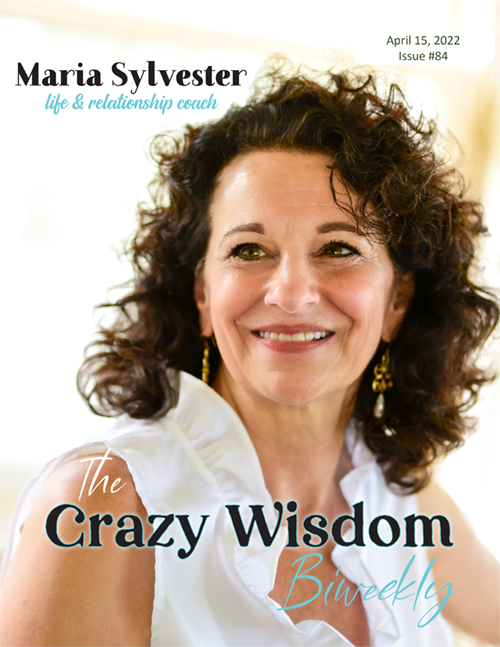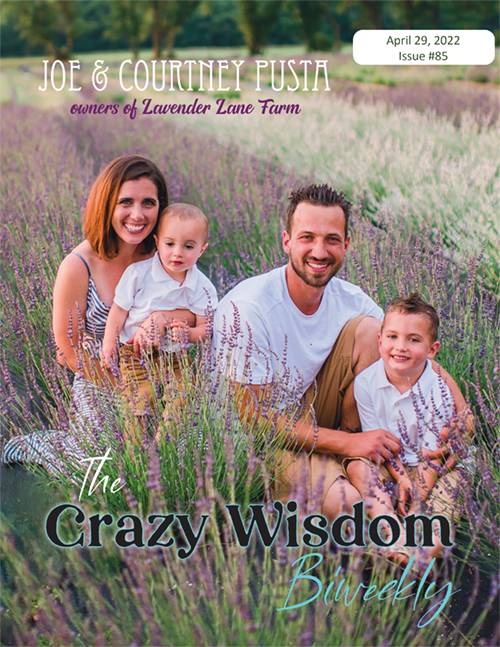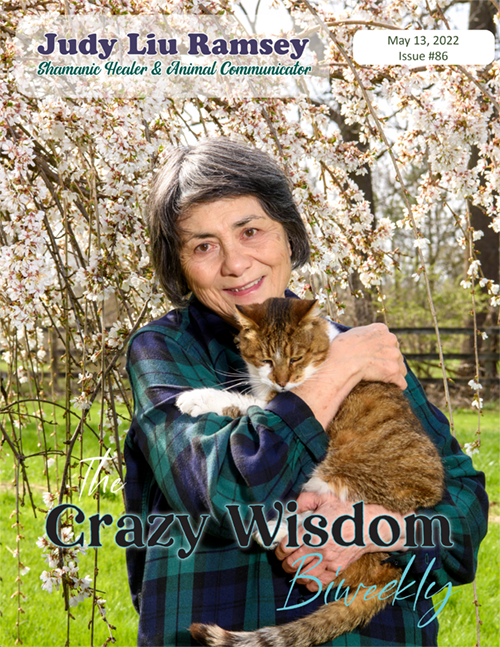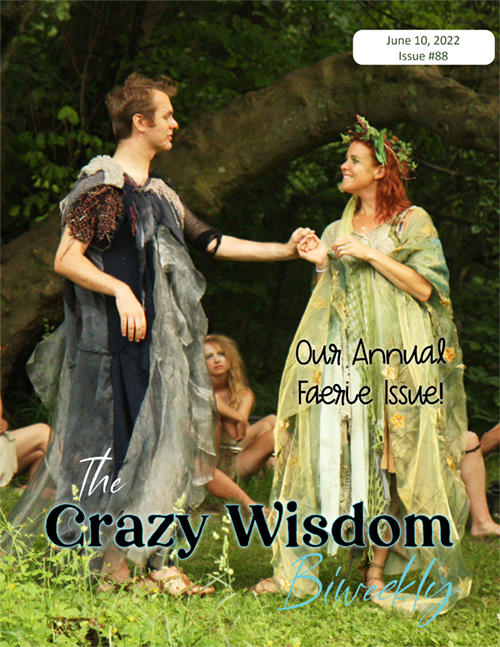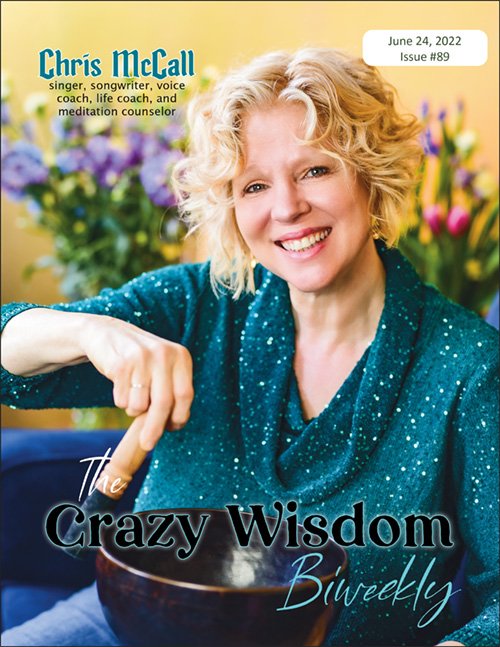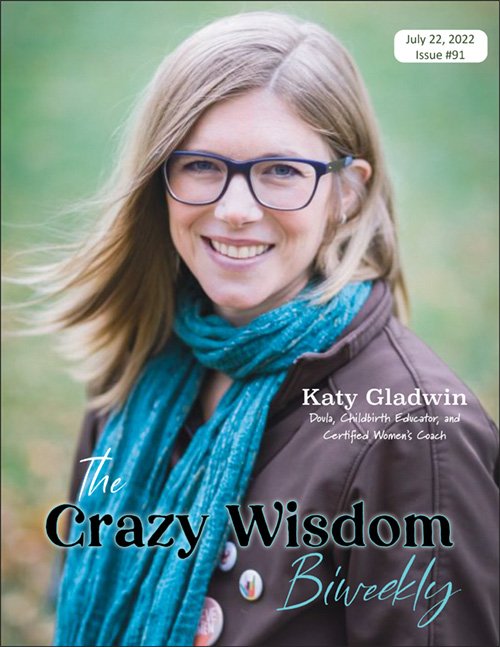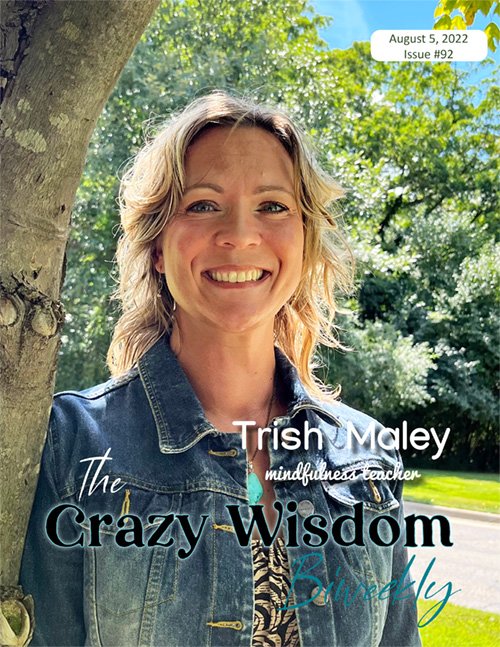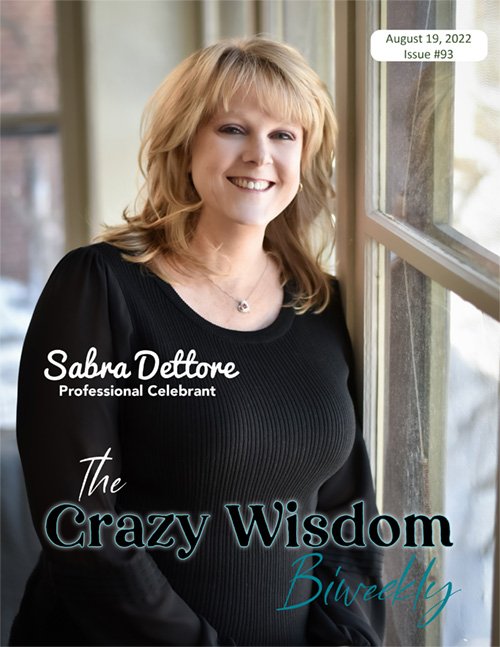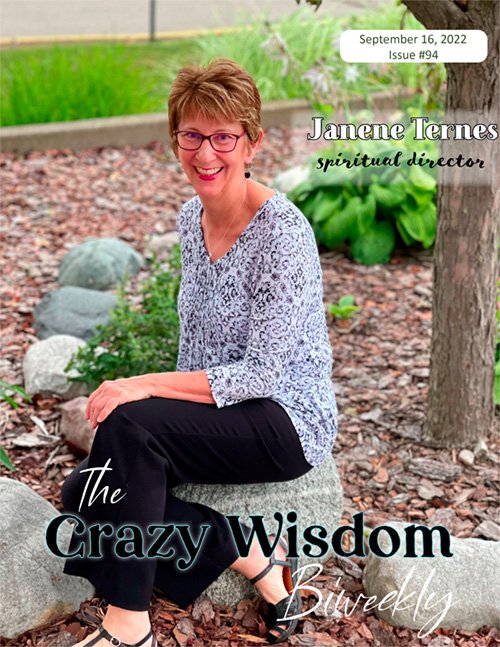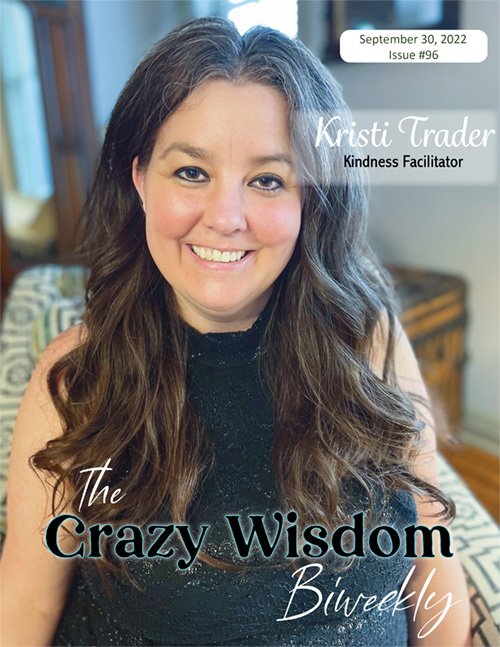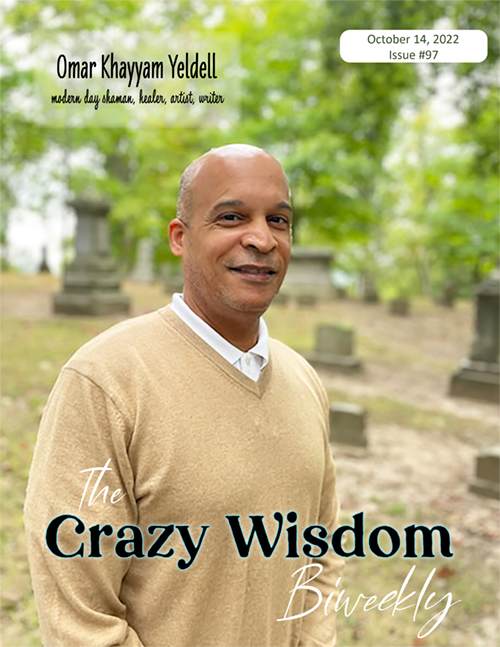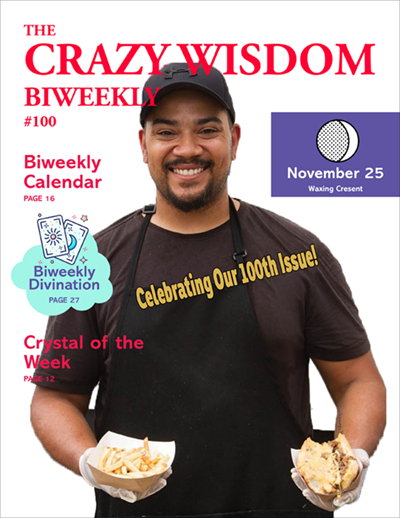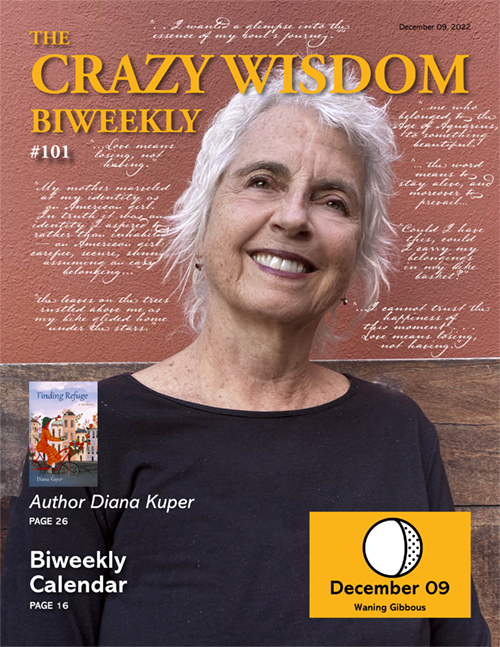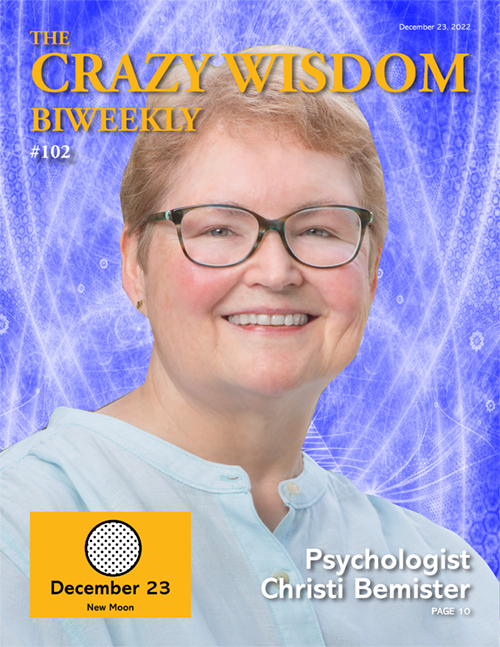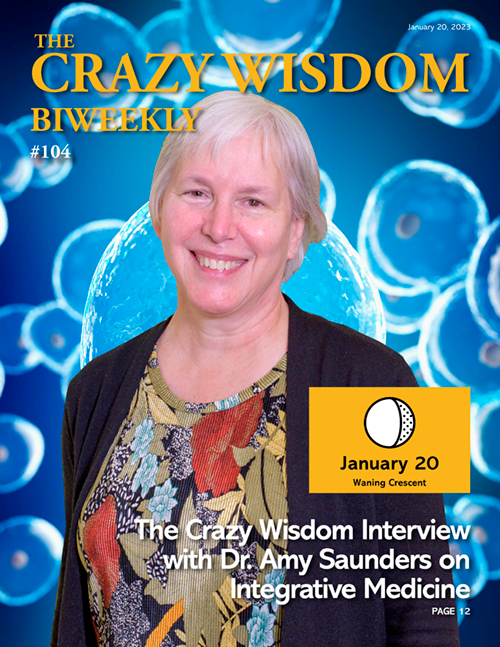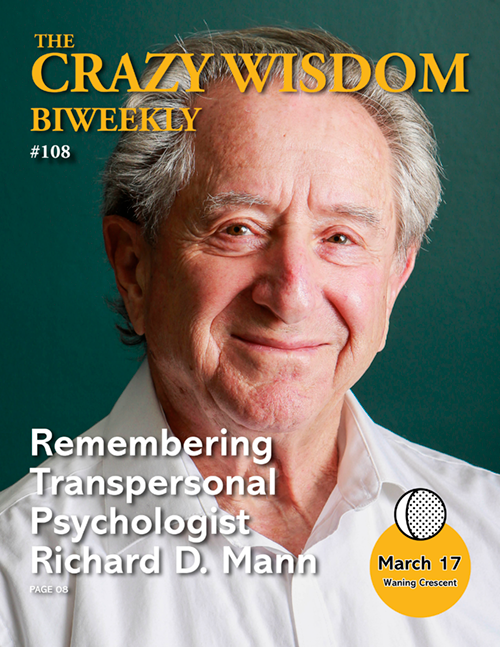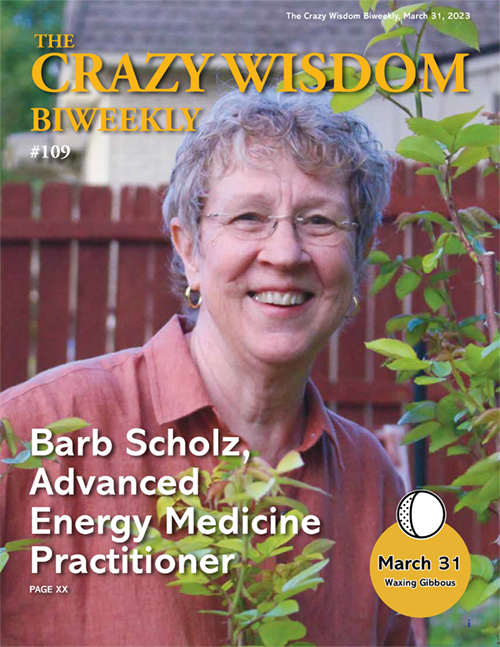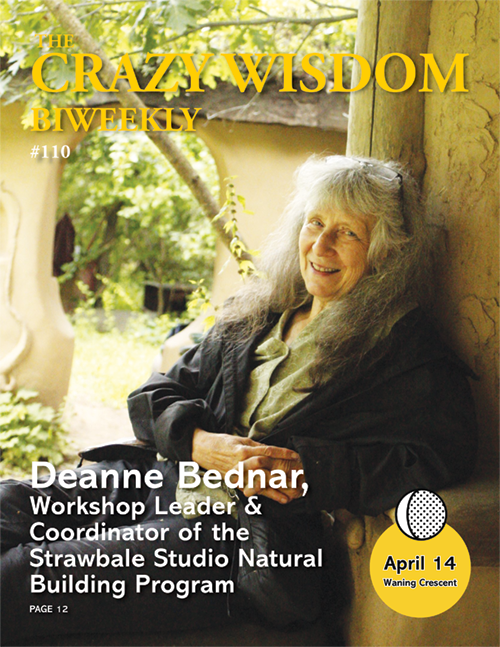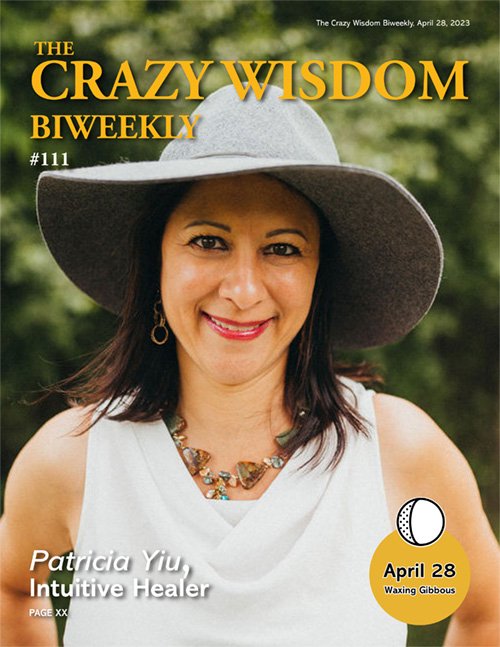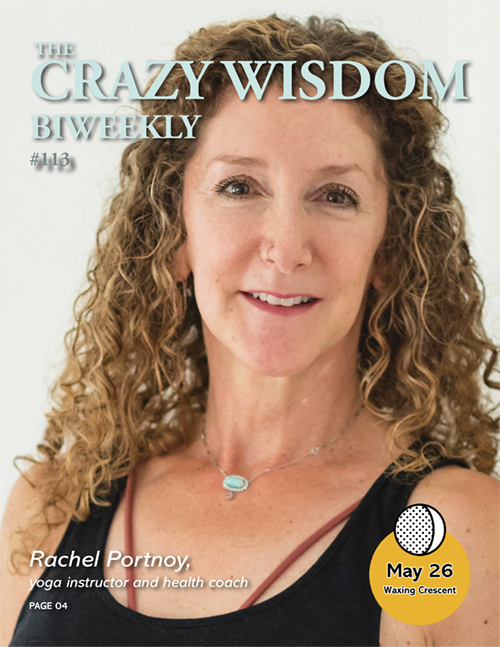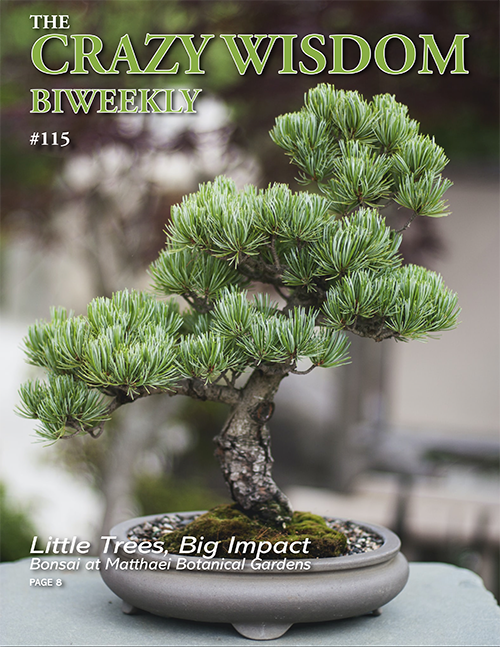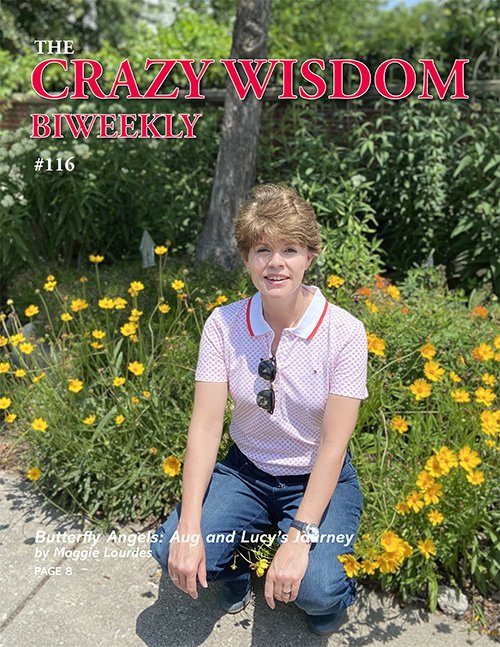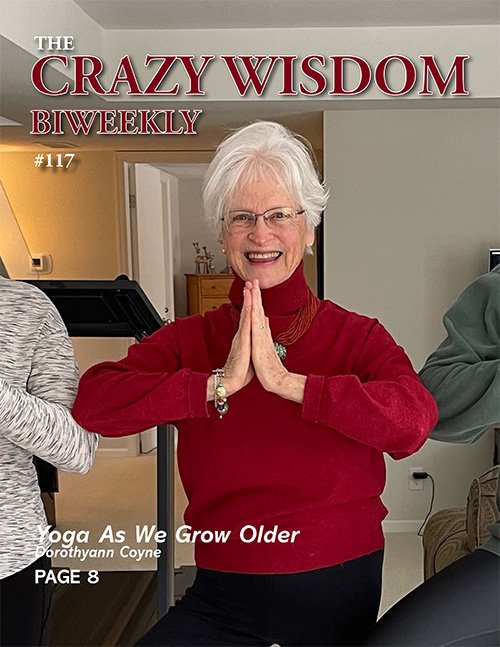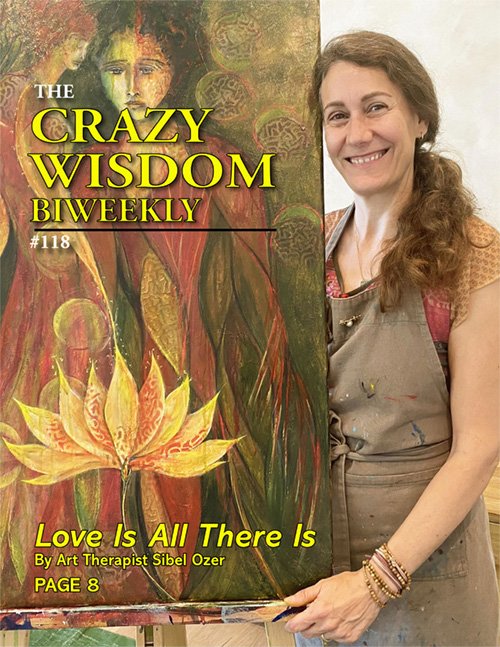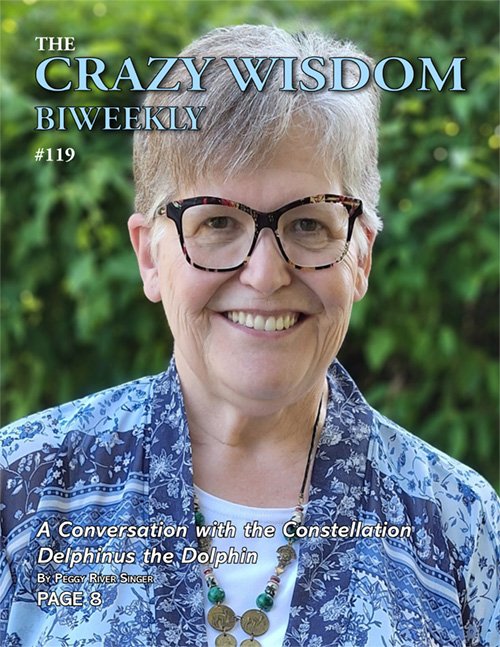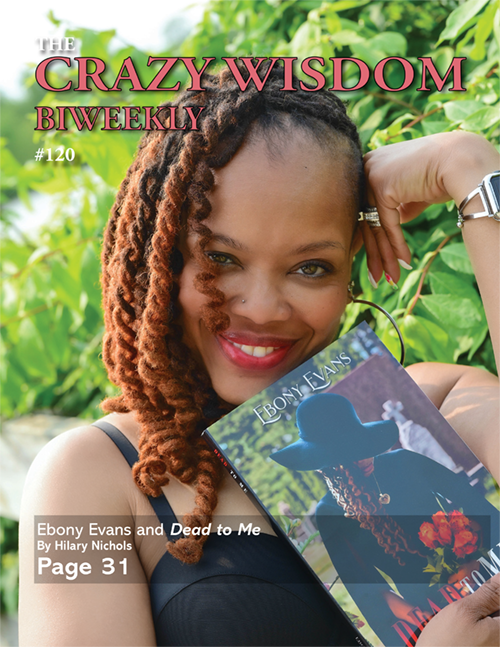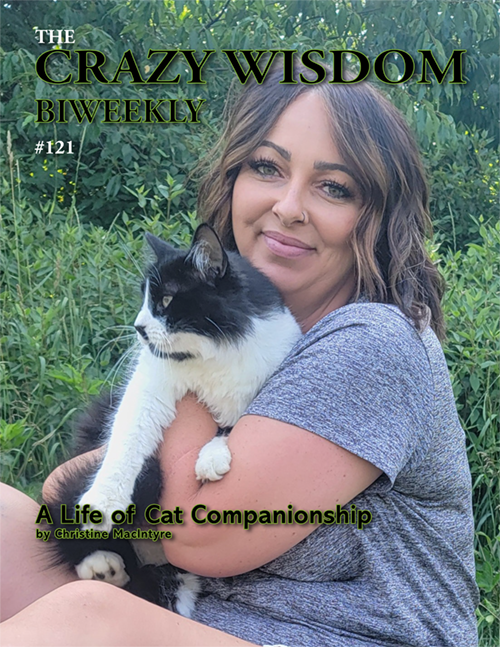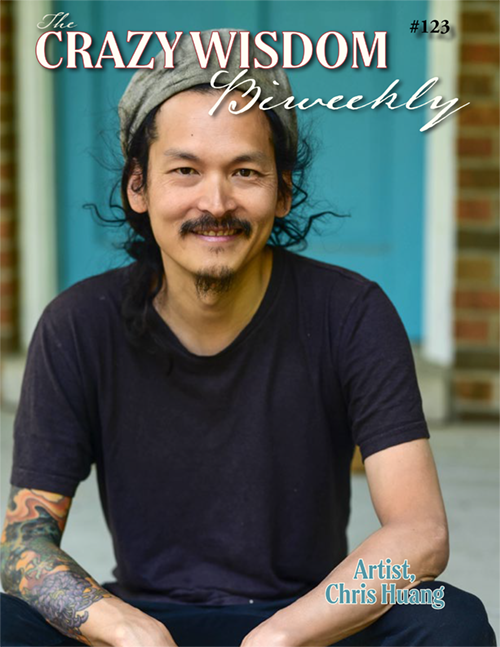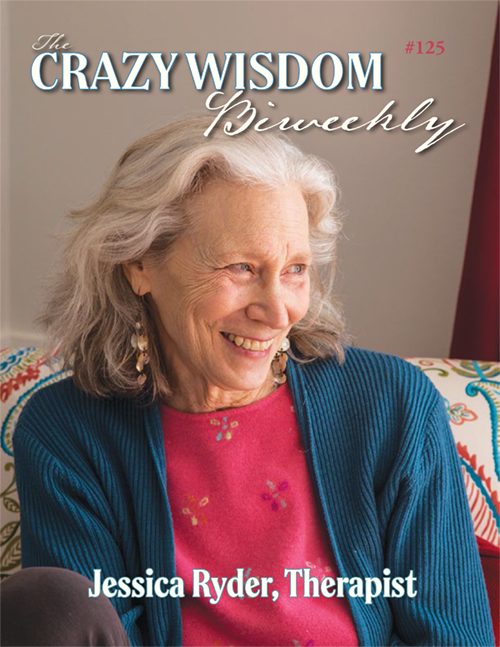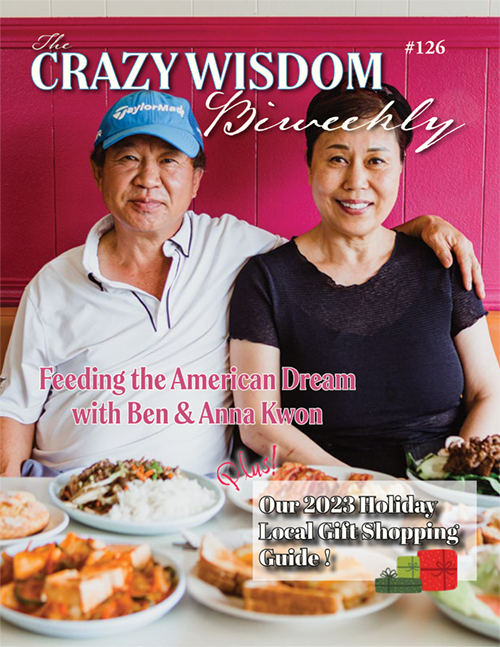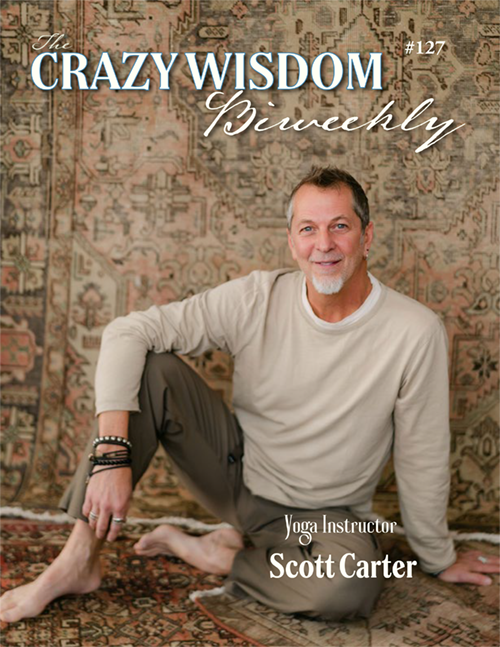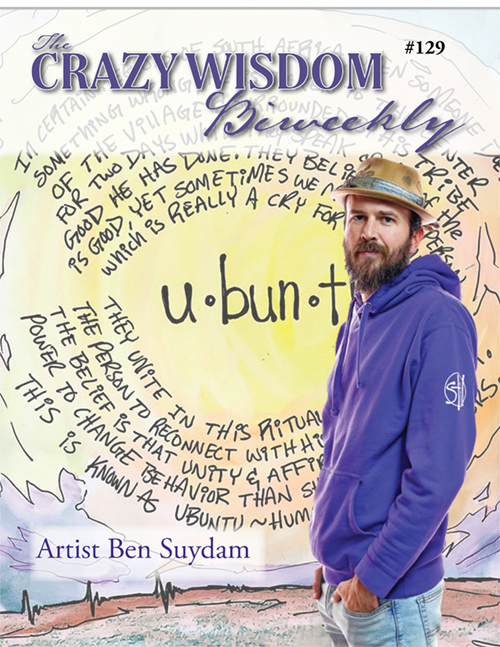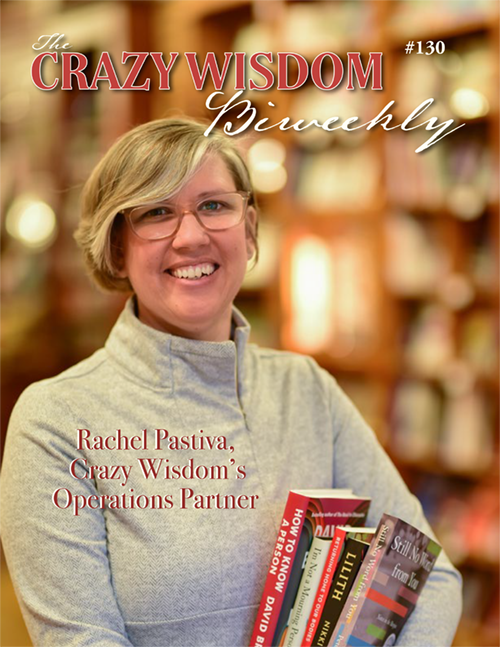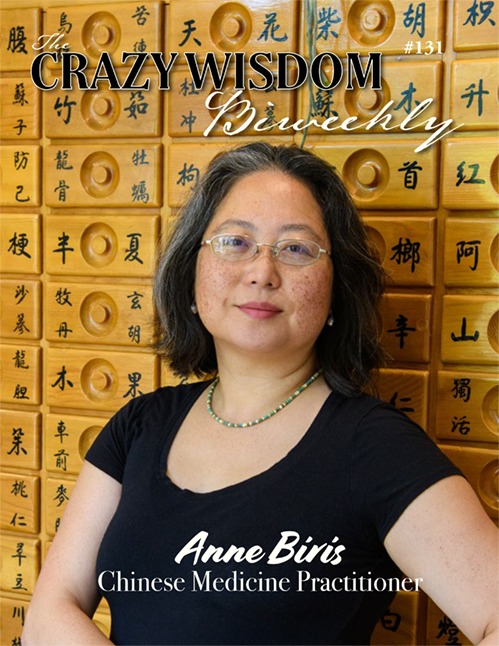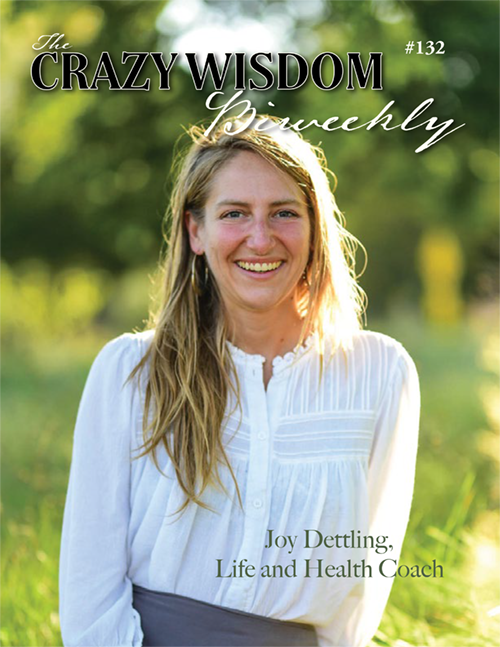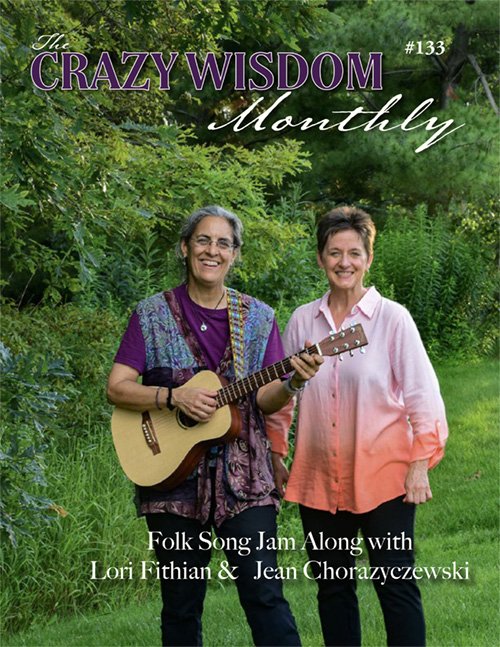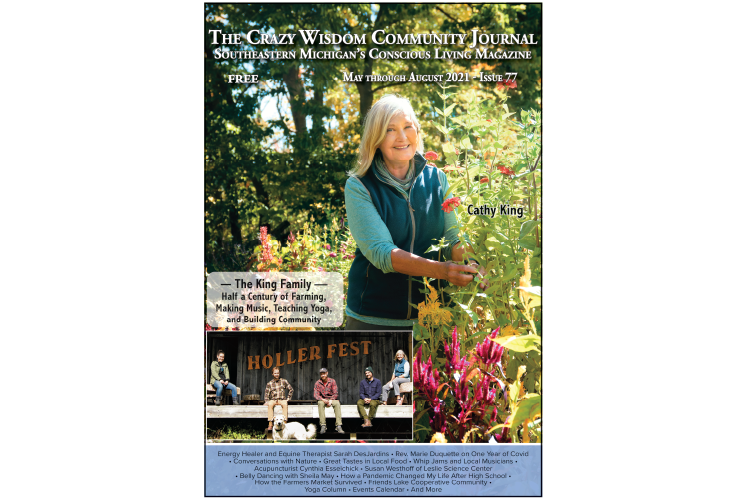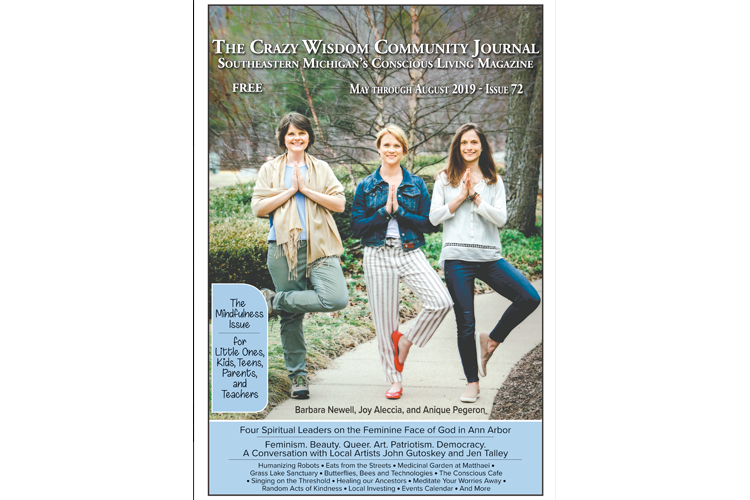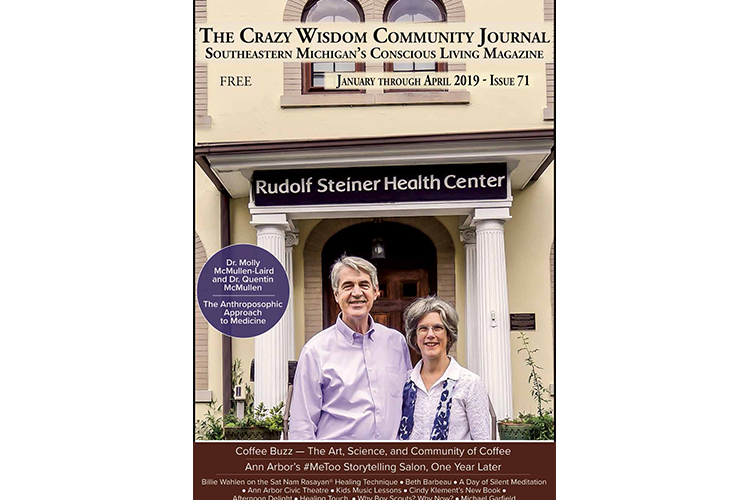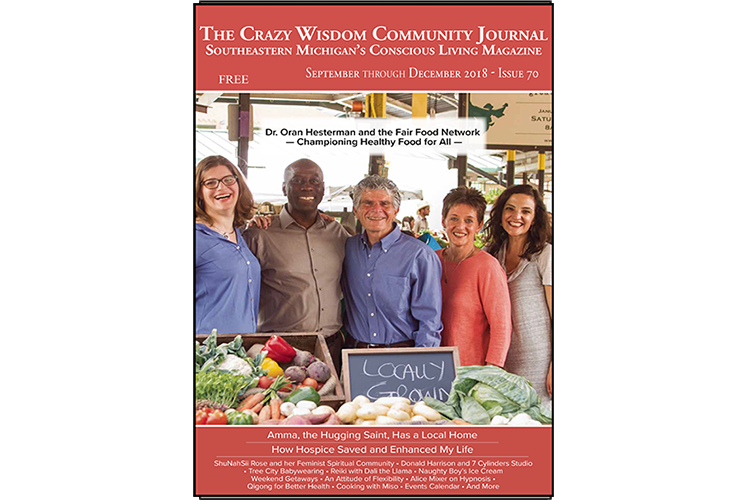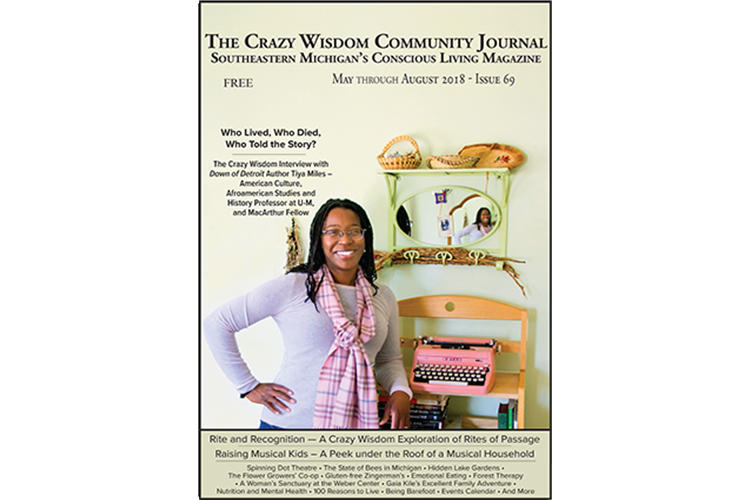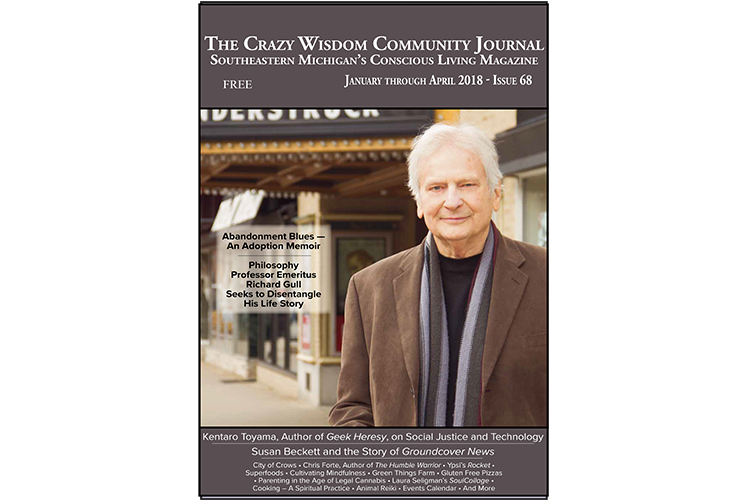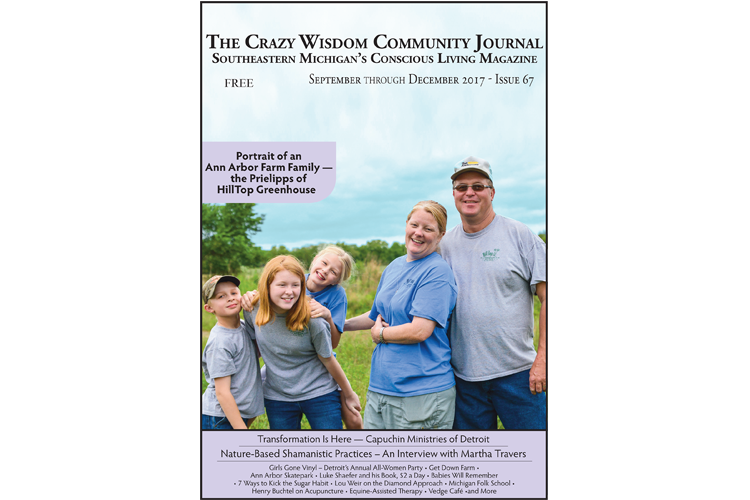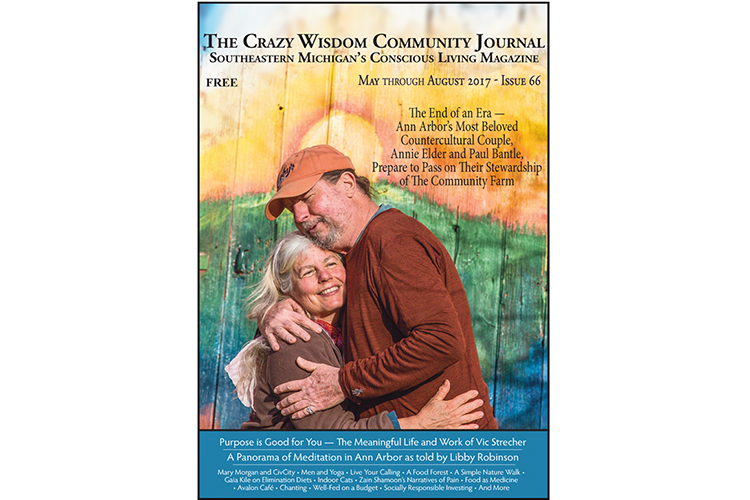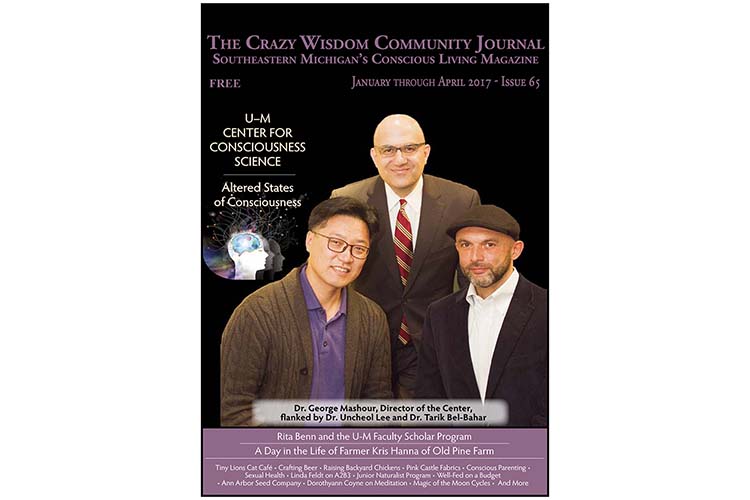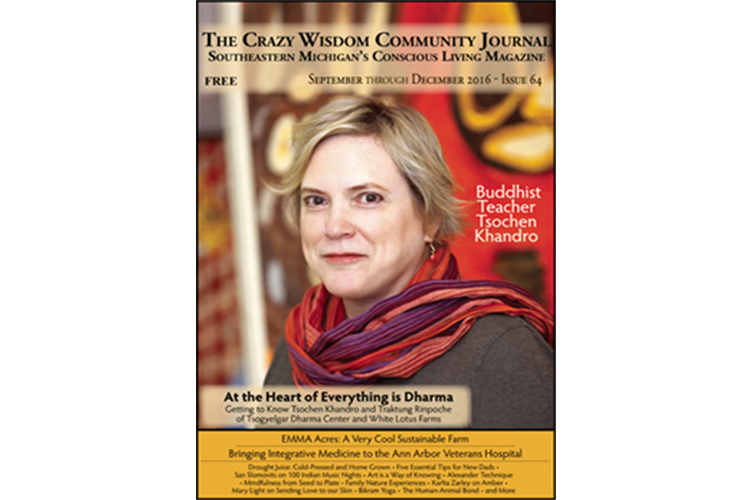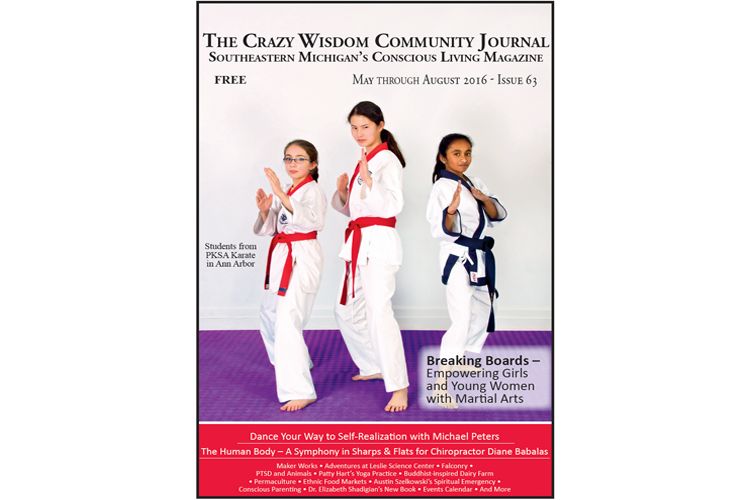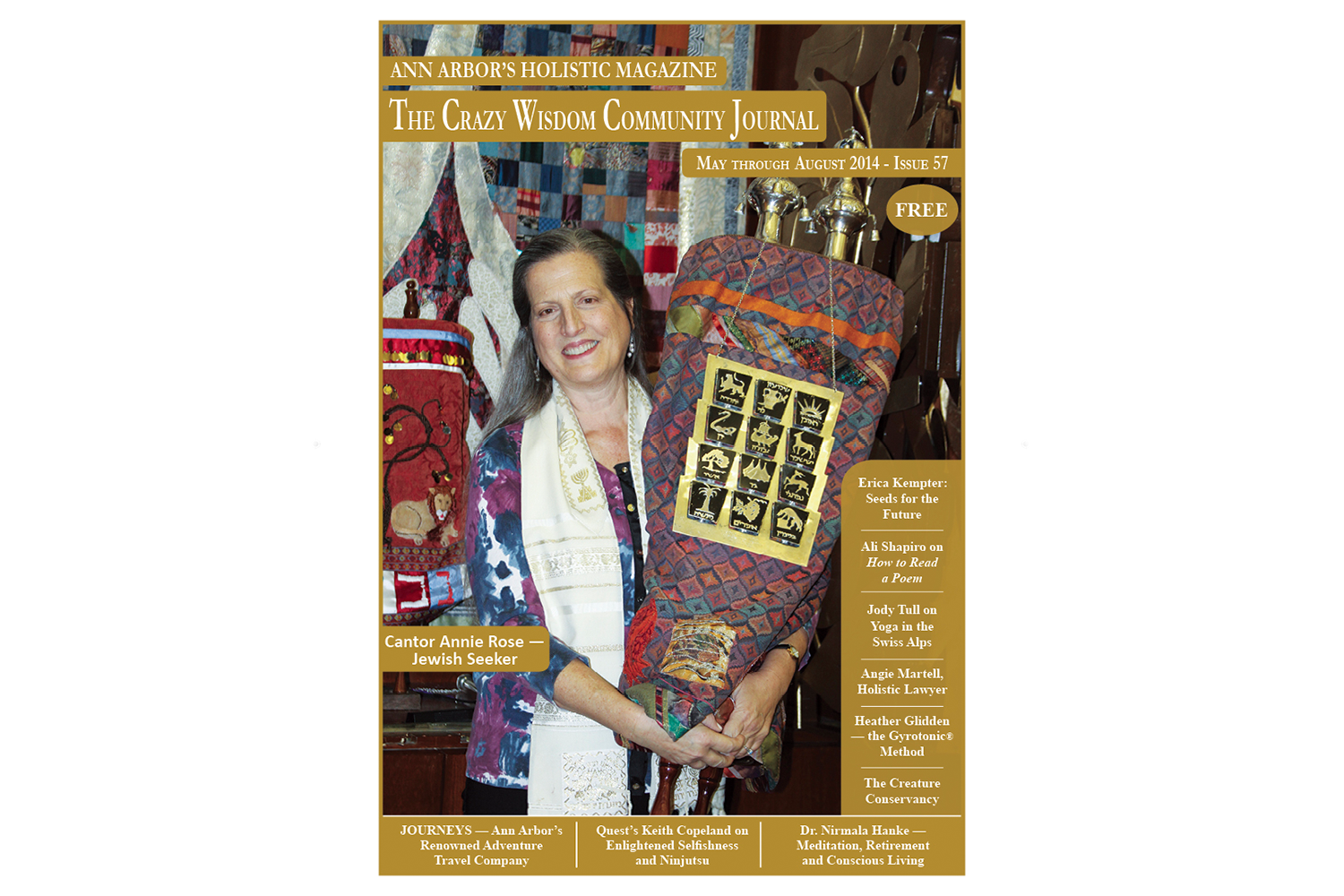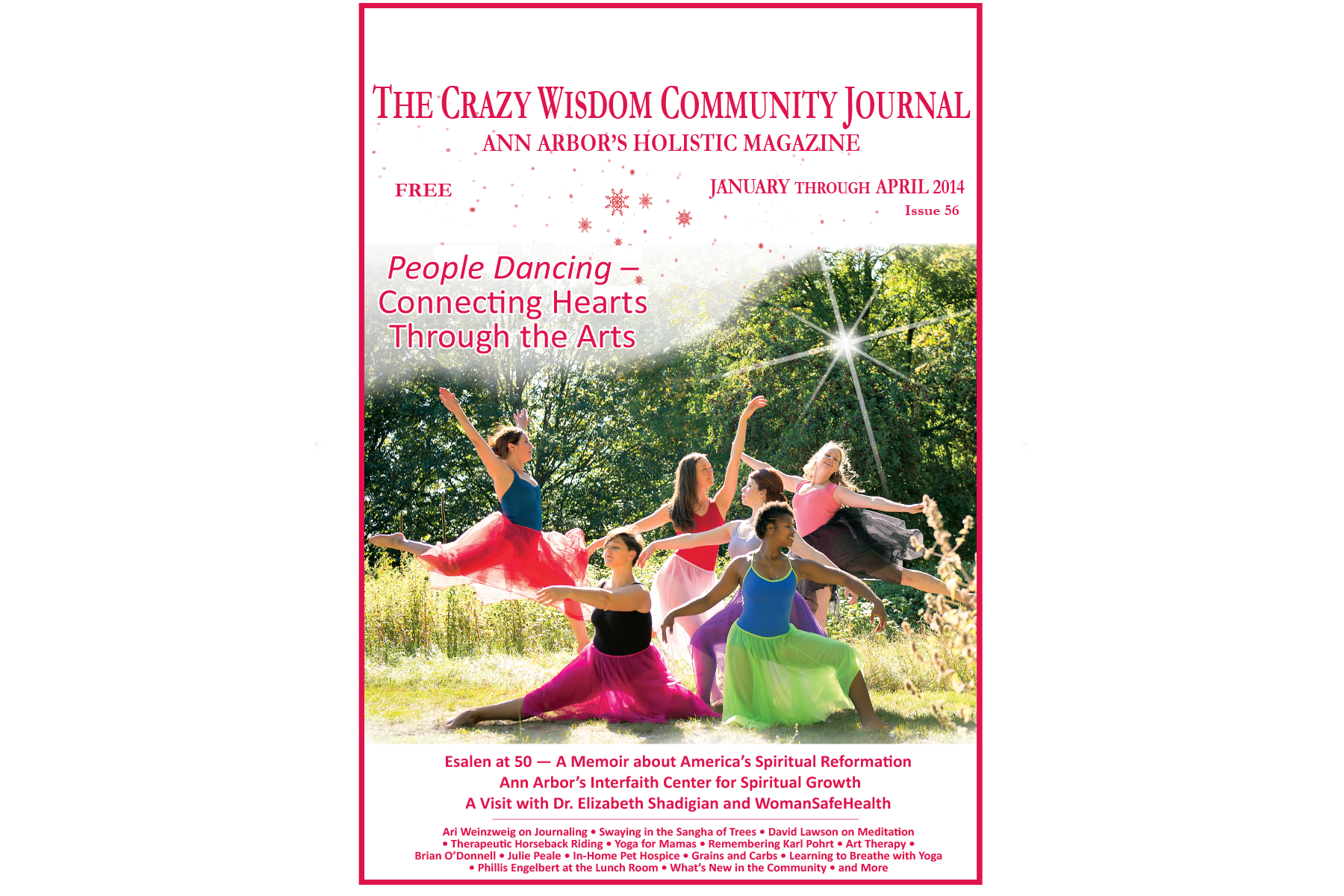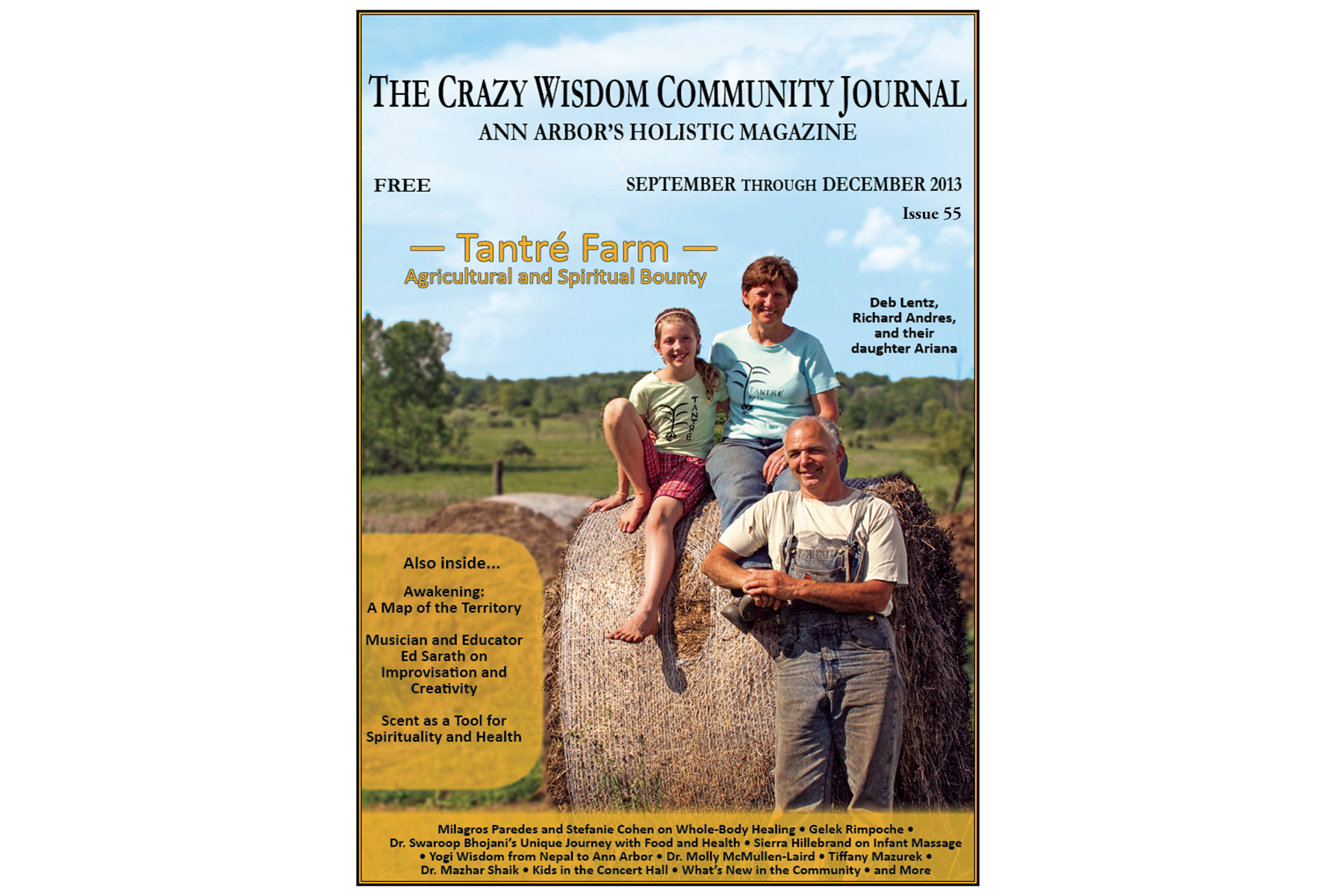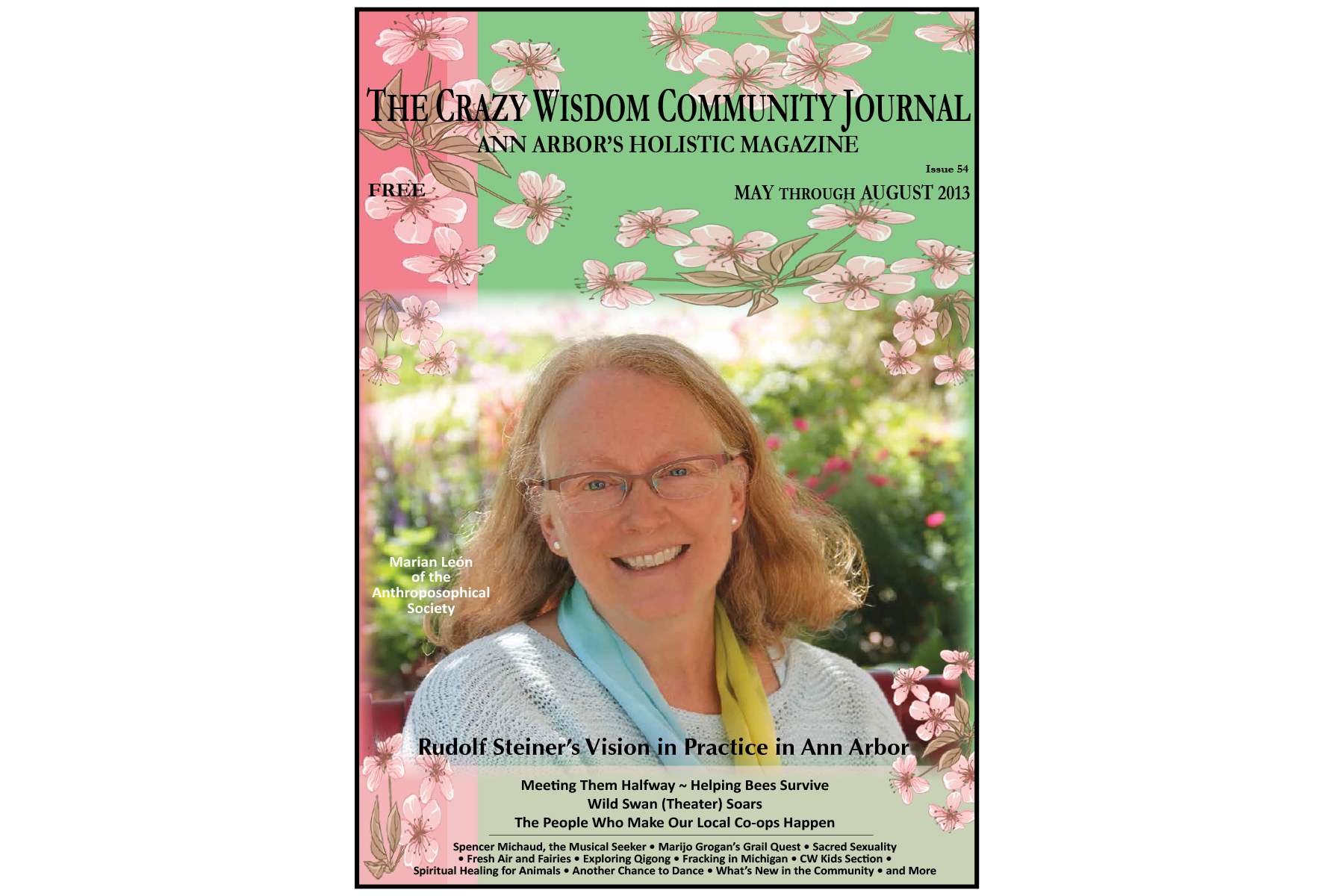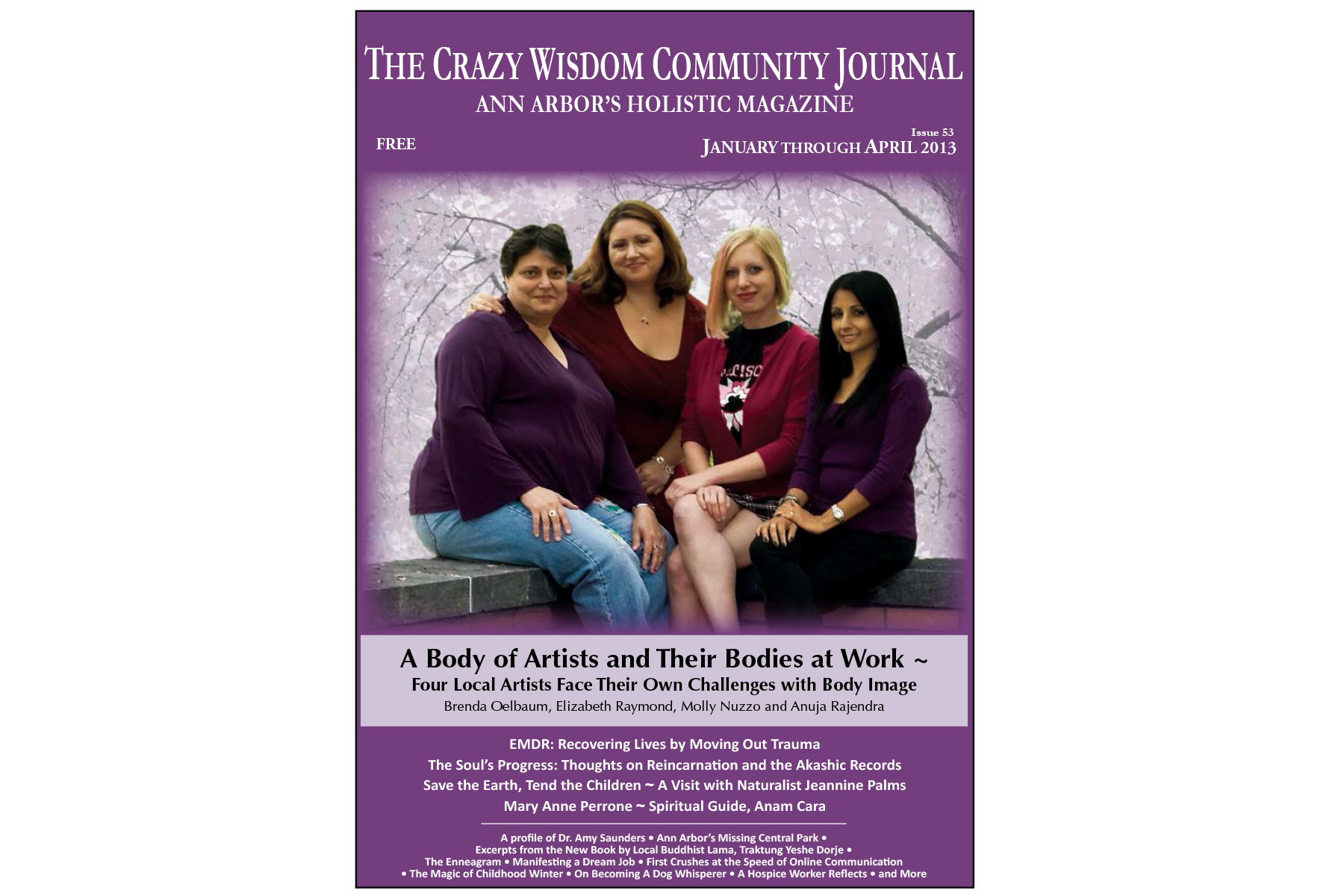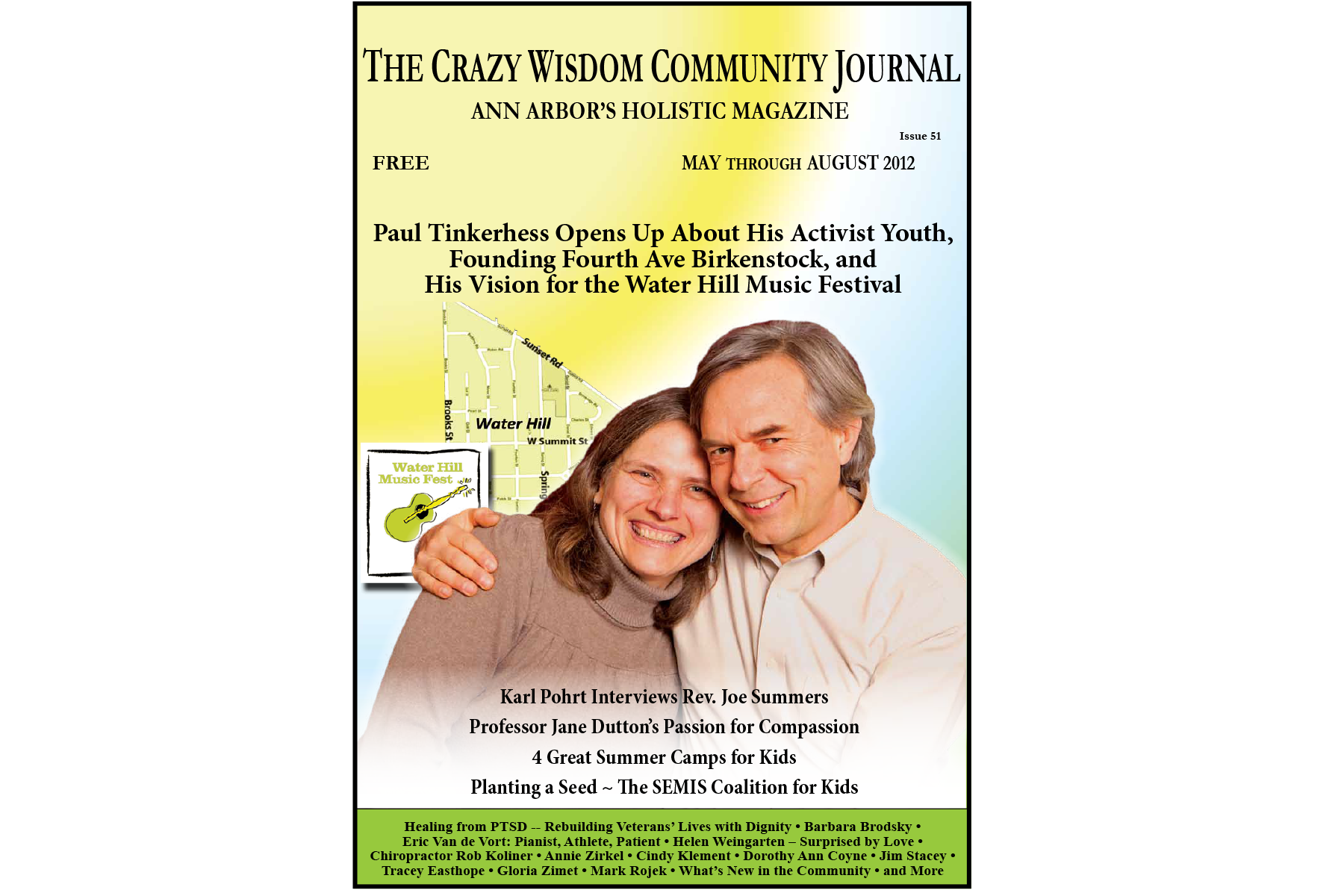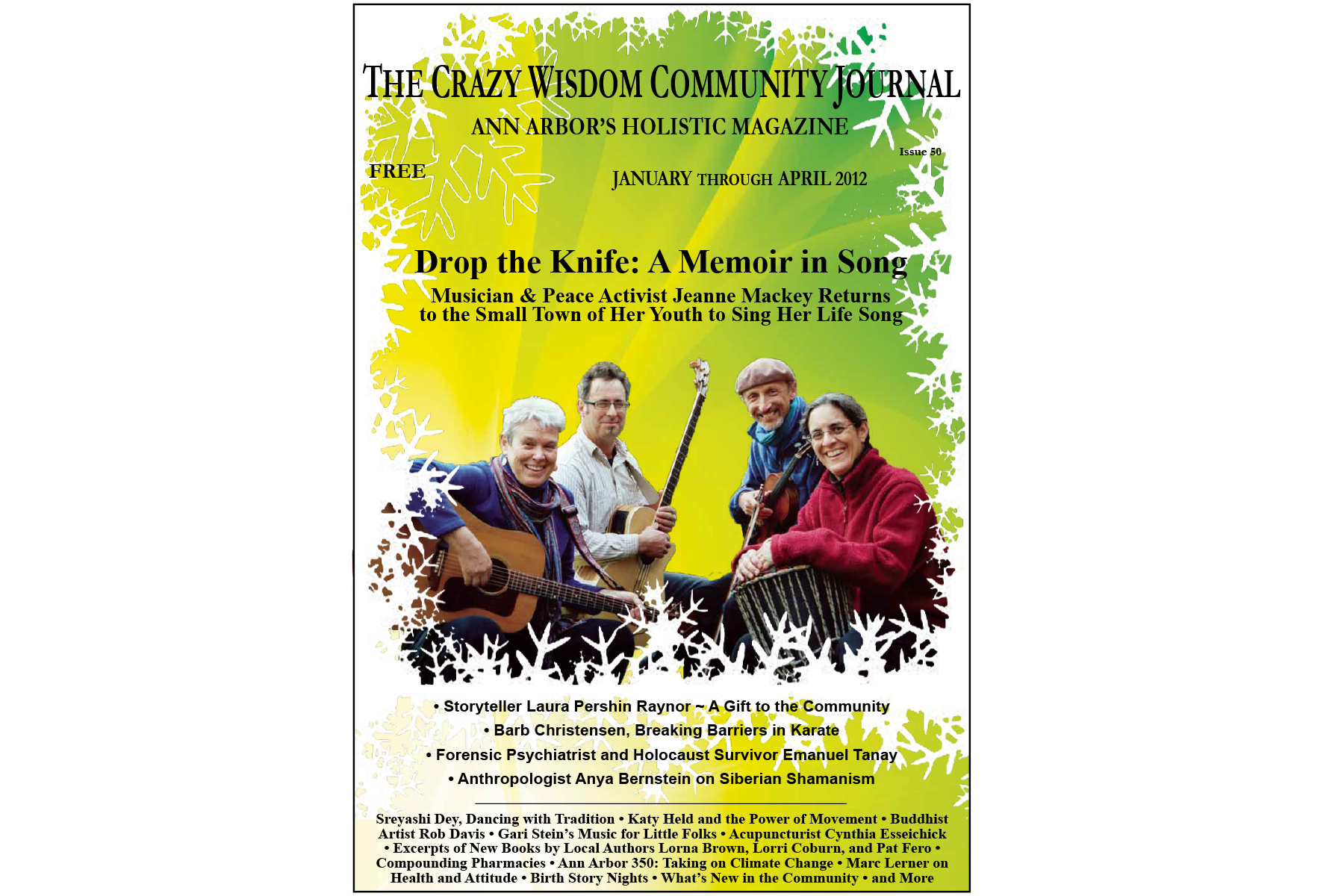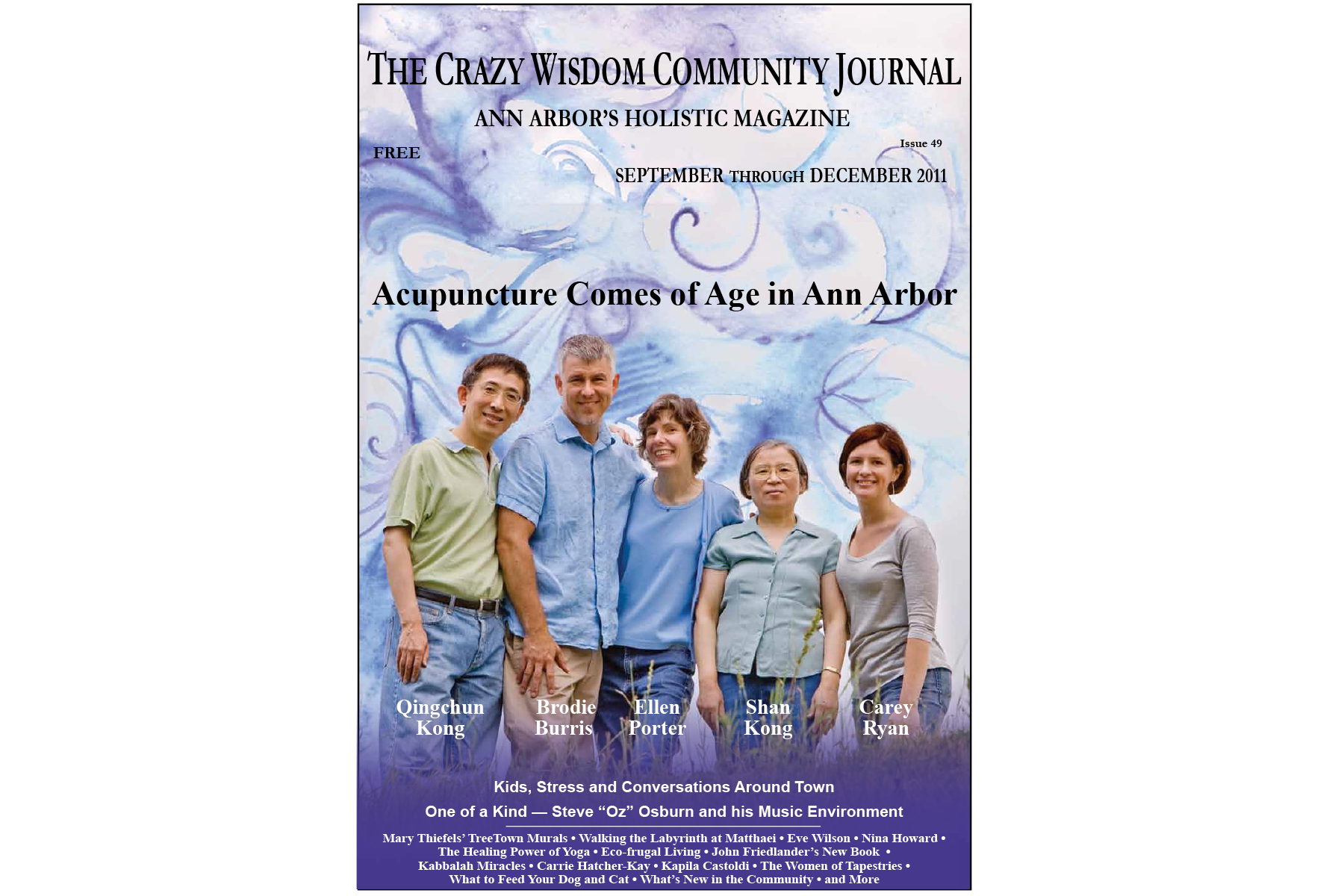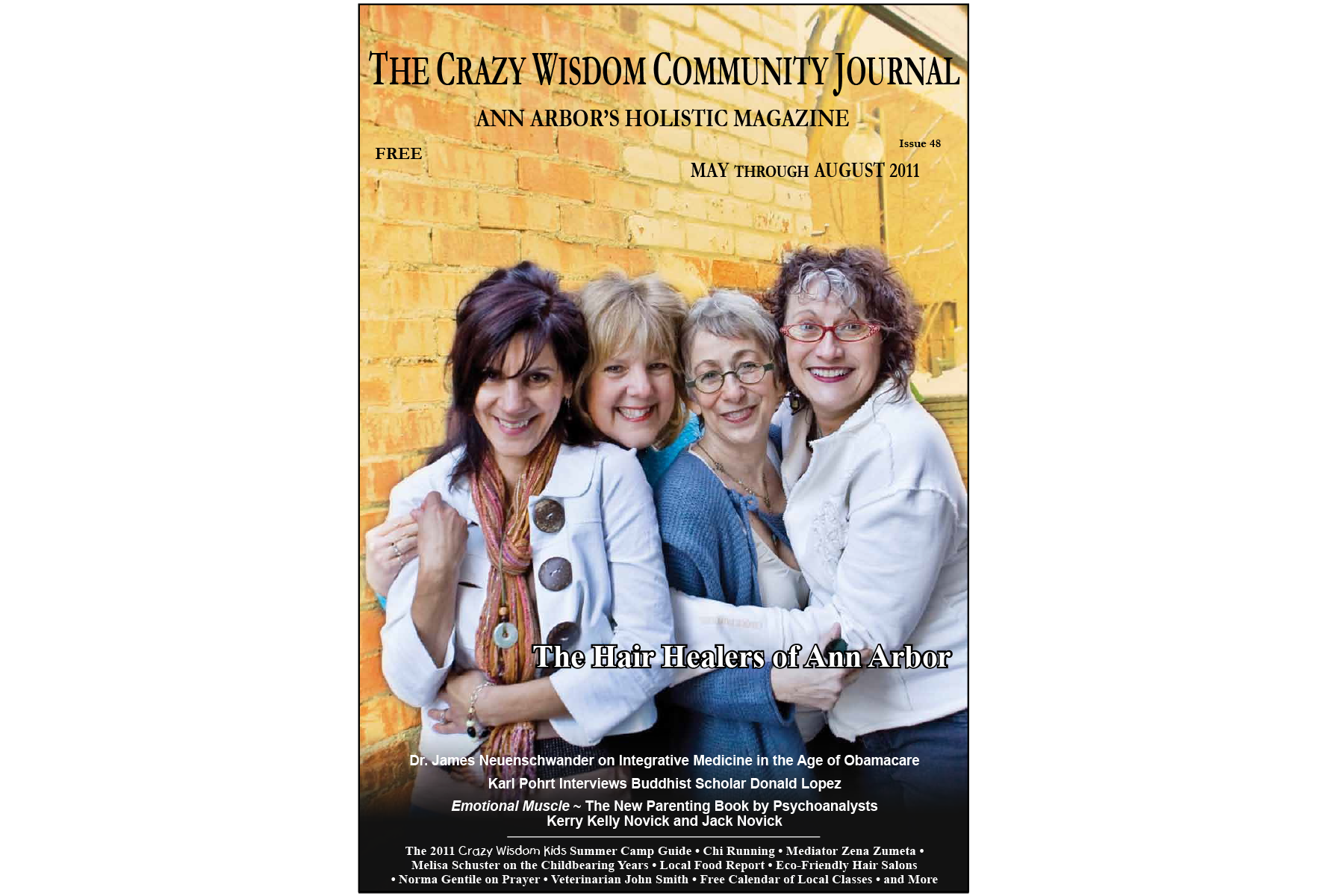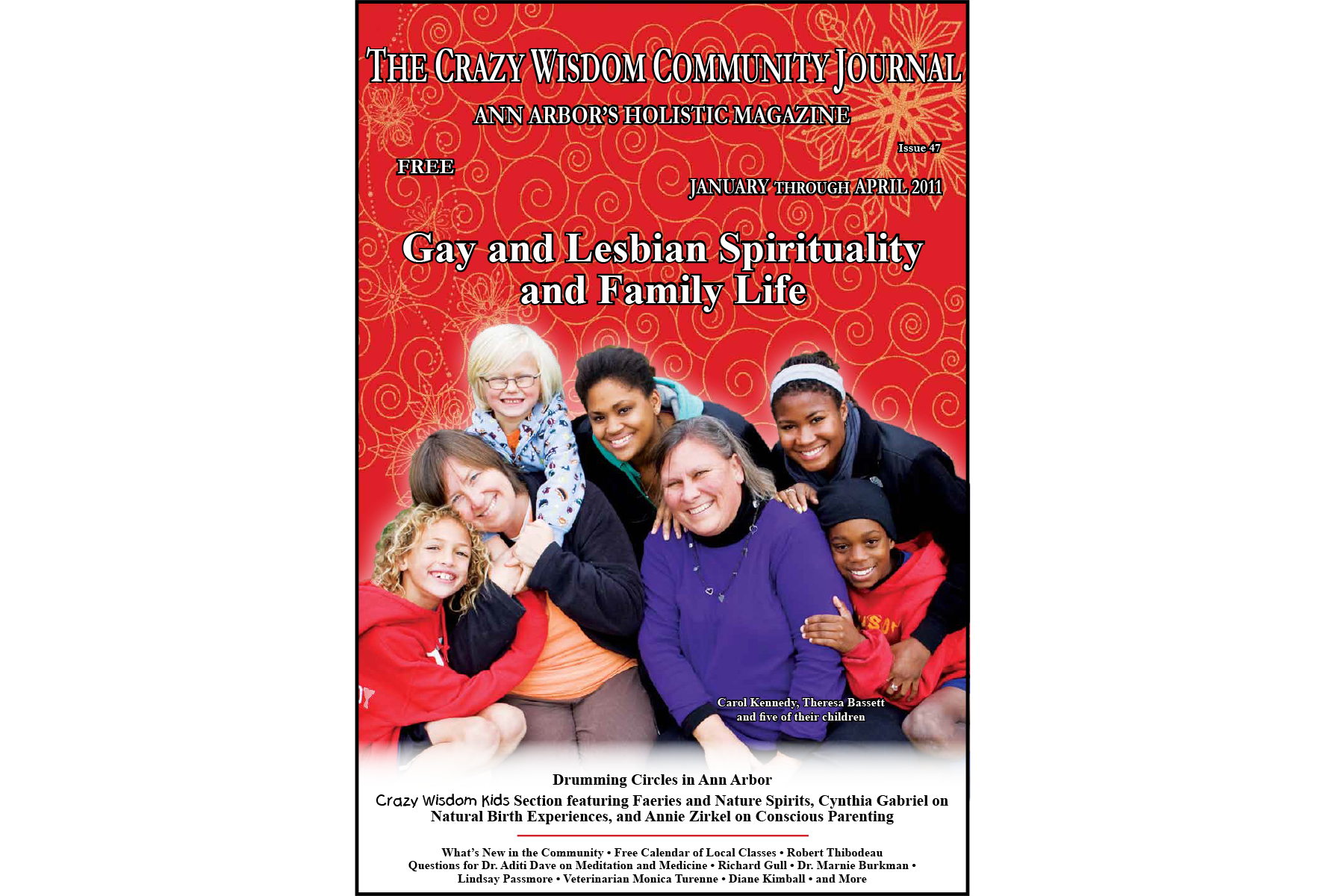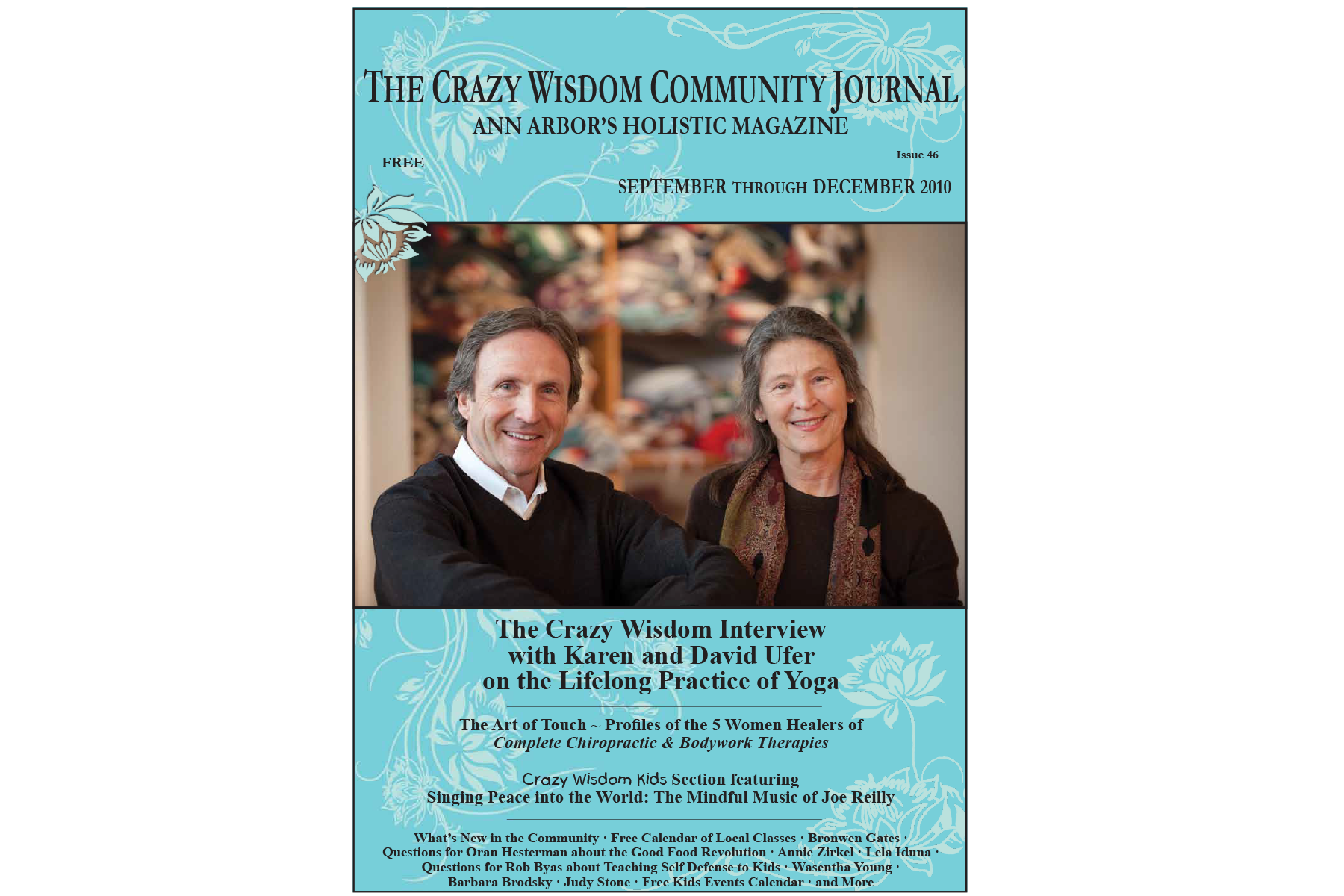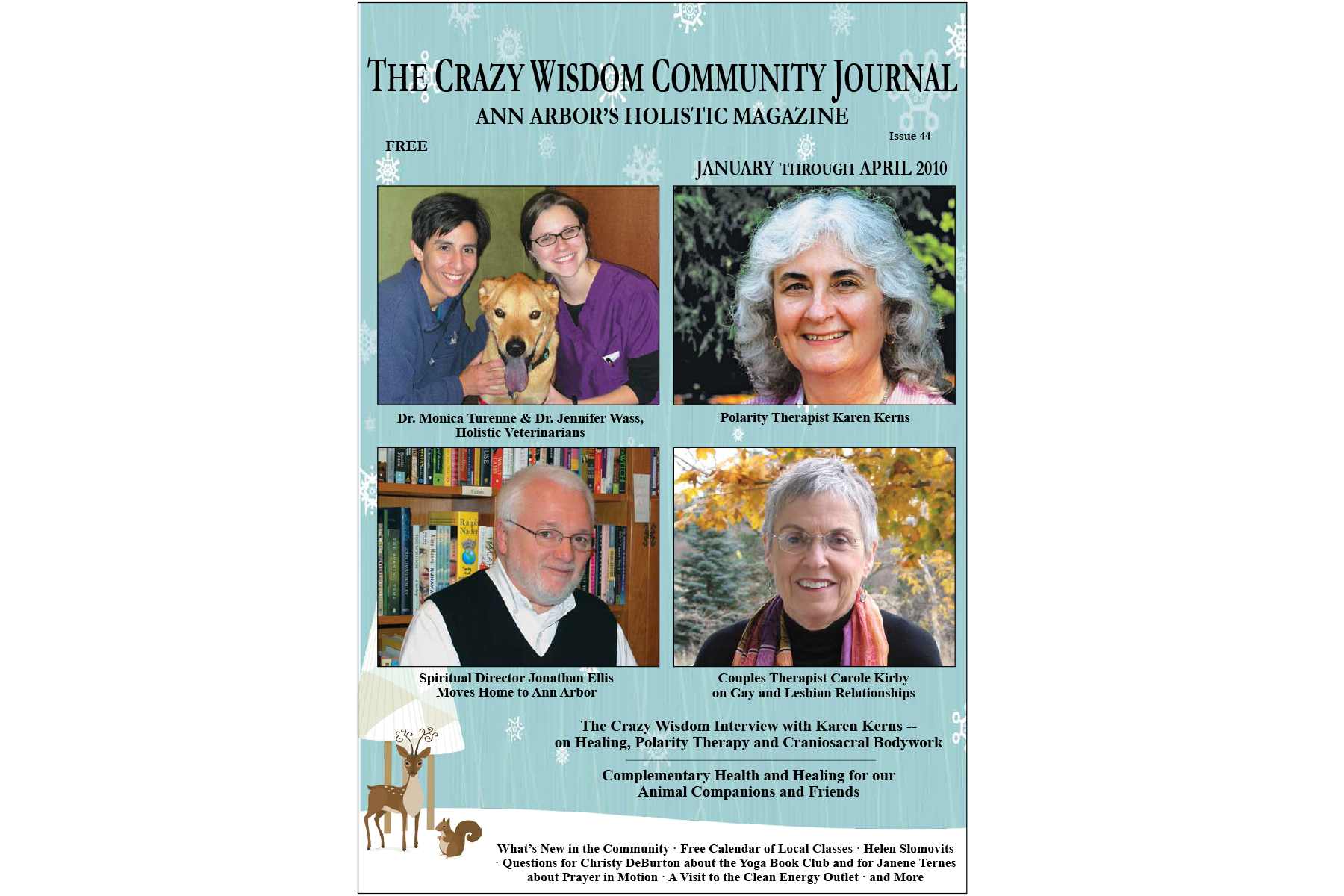In recent years, yoga has grown exponentially in popularity. Instead of being a niche activity it’s part of the mainstream. It’s become normal, even outside of places like Ann Arbor, where yoga has had a strong community for years. We talked to 12 yogis from in and around Ann Arbor to take the temperature of the yoga community right now.
Sitara Bird — Detroit's Instagram Yoga Sensation On Staying Connected
By Chelsea Hohn | Photos by Joni Strickfaden
Sitara and her partner, Tim Shellabarger
A young, mermaid-esque woman walks into a coffee shop in Ferndale, Michigan. Her blonde dreadlocks intertwine with beads laden throughout, floating around her head like a messy halo. Accessories adorn every limb. Jewelry hangs from her nose in several places, bracelets accentuate her wrists, and elaborate tattoos peek out from her clothes.
To many, Sitara Bird’s uncommon beauty might catch their attention, but to her 34,000 followers on Instagram she’s instantly recognizable. Her frequent posts illustrate a life well lived. Her color-saturated photos, videos of yoga sequences, and still-life photos of healthy and beautifully arranged food provide vignettes of her life to the thousands of people who interact with her on a daily basis. Their essence captures her presence, calm yet powerful.
Her Instagram is a source of inspiration to her followers, who interact with her through the main form of communication on Instagram: comments. Thousands take a moment to write sentiments expressing their appreciation and encouragement.
““Everyone always says you find yoga when you’re supposed to find yoga, and it found me right when I needed to find it.””
Similar to her appearance, her Instagram account feels like an extension of herself. She presents something alluring yet seemingly effortless, and has the innate ability to bring out the best in others.
Now 26 years old, Sitara Bird started practicing yoga when she was 19, in Clinton Township, and took her yoga teacher training in 2010. She now teaches yoga in the Detroit Metro Area, especially at the Citizen Yoga studios in Detroit and Royal Oak. When I asked her how yoga found her, she replied, “Everyone always says you find yoga when you're supposed to find yoga, and it found me right when I needed to find it.” I couldn’t help but think her Instagram feed was helping others in search of finding their yoga connection.
Sitara Bird first took a liking to Instagram because she found it was easier to control what she sees on her feed. It occurred to her that this medium was ideal for sharing her story and inspiring others. It was also a match for her interests in yoga and photography. Now she posts about once a day; she has no quota but posts often enough to keep a regular following.
The rise of social media has coincided with a growing subculture of people who go online to have inspiration translate into life away from a screen. Sitara Bird’s elegant tributes to yoga and healthy eating have put her at the forefront of the followers who champion this lifestyle.
It seems her 34,000 followers is evidence she’s doing something right. The conversation she’s generating is at the nexus of yoga teachers, practitioners, clothing brands, and festivals that are integral to the modern yoga community. Yoga brands have begun to work in step with social media stars by creating contests within Instagram. Yoga festivals draw attendees by having similarly well-known names and Instagram personalities teaching at them. And for teachers like Sitara, it’s meant connecting with new students all over the world.
Many of modern yoga’s media stars are women in their 20s and 30s, with a range of yoga experience, but, at its heart, the movement seems to share similar intentions. It’s a positive community, one that for the most part includes members who share encouraging comments and act as catalysts for trying a new yoga pose or getting centered. Hashtags have also made it easy for people to connect around similar ideas, helping to spread inspiration by illustrating variations on a theme.
But to some, taking yoga to social media can seem like a step backward. Taking part in social media often comes from a very ego-ridden place; with users judging themselves and others through the process of likes and views. It’s easy to be deceived by appearances and distracted from real life.
With this in mind, I asked how Sitara Bird could use social media as a tool to spread or gain positivity without getting caught up in praise or rejection. She explained that it’s a challenge, and a building of awareness. “I kind of view my Instagram account as a journal,” she said. “People ask me, ‘How can you post yoga photos and it not come from an egotistical place?’ I know my intention is to share my story, and from the feedback I receive I know that it’s working.”
Using social media as a journal and a place for self expression keeps the intention real for her. Though it is also important to her to remember that social media is not real life.
Putting value on something that isn’t real, such as likes and followers, is a dangerous path that many users of social media go down. Commenting on this, Sitara Bird asked, “If the Internet broke tomorrow, then what would you do, where would you find your happiness?”
But not everyone has the detachment down. Many people use social media as a way to put value on themselves and get sucked into questioning their self-worth. With the positivity emanating from Sitara Bird’s community of followers, their connection is an antidote to this. Sitara Bird keeps the balance by keeping real face time.
“That’s more important and more fruitful and more filling for your soul than posting a picture, and the problem with social media is it creates this broader, more expansive bridge — you don’t see people talking anymore,” she said. “I think keeping real face time is important, and keeping yourself in check.”
Keeping yourself in check can mean questions of authenticity. For Sitara Bird, she tries to keep her page as authentic as possible. Social media is a place that can be easily crafted to convey a certain image, one that often leaves out emotions and experiences like pain, suffering, and loss. She finds there’s often a gap between what people experience everyday and what they choose to share. But she likes to write about her personal experiences, and says that when she is open and expresses her thoughts she gets the most gratitude from followers. It’s what inspires her to keep sharing.
Instagram as a format for connection has a great potential to change lives, if users can also remember to get the face time that is necessary. In the yoga realm on Instagram, this means getting on the mat, and for millions, the formal yoga challenges to do a certain pose or achieve a daily goal, and sharing your progress, have become wildly popular. Joining together to practice can be a wonderful reminder of why yoga appealed to them in the first place as well as a way for people to start a habit they would like to keep.
It’s also a place for businesses and opportunists like Sitara Bird to make connections and further themselves. She uses Instagram in part as a business endeavor and in part as a way to show potential students what her yoga practice is like. Even if it’s been inadvertent, Sitara Bird’s social media presence has become a brand, enabling her to become a participant at festivals, a teacher at large events, and a yoga retreat leader with Citizen Yoga.
The balance between using Instagram as part of her journey as a yogi and using it for business is another challenge she has to manage. Fusing a practice that is focused around letting go of the ego into a medium that celebrates the self is tricky enough. I asked her, “Does adding a layer that is growing a personal brand dilute the original purpose of spreading the gift of yoga?”
“Not necessarily,” she said. Her approach to social media is genuine, and she uses it as a way to spread the gifts she receives from yoga. But it is also how she builds her brand and works as an entrepreneur. She acknowledges how others might see the conflict in that. She also encourages people to evaluate social media’s potential for reinforcing best practices, as the community voices their alarm when authenticity is lacking. Negative feedback can motivate people to change course for the better.
““If the Internet broke tomorrow, then what would you do, where would you find your happiness?” ”
For her next endeavor, Sitara Bird is making videos, available online, so anyone around the world can practice with her. Her vision is to use her success on Instagram to bring people to her website.
It’s a strategy that works. With a captive audience, an account featuring beautiful photos like Sitara Bird’s can grab attention and attract new customers to studios, brands, and events and improve opinions. Like with any other aesthetic-based medium though, the quality and appearance of the photos matter. Attention to detail and an eye for design can go far, as it has for people like her, so if you’re a business owner considering this strategy, get a design-oriented person to lead the job.
So many people take to social media as a means to change their life, looking for a source of inspiration that will catapult them into new habits, but Sitara Bird encourages people to notice the conversation we have with ourselves.
“Notice the conversation you have with yourself in your own head, that’s where it starts,” she said. “You want change — it starts there first, it’s not outside of you, it’s not looking at something through a phone — it starts inside of you.”
For more information about Sitara Bird, learn about her on her website www.sitarabird.com. To see her on Instagram, go to instagram.com/sitarabird/.
Related Content:
Mindfulness in Education Begins to Thrive — An Interview with School Psychologist Mary Spence
The definition of mindfulness provided by its founder, Jon Kabat-Zinn, includes three essential components: 1) Paying attention in the present moment, 2) On purpose and 3) Without judgment. I want mindfulness to survive its popularity because I believe that the practice of being mindful can remind us of who we really are, bring us back to our common humanity, and invite us to remain integrated in mind and body.
Kim Bayer: Proponent of Slow Food, Champion of Farmers and Marketers
By Rachel Urist | Photos by Joni Strickfaden
In her blog, Kim Bayer was the “Farmer’s Marketer.” When MLive invited her to write about restaurants and the local food scene, she brought a following. Her prose is a good reflection of the person: direct and lucid. Consider the following, written in May of 2011, about one of her favorite subjects.
My number one place for food in Ann Arbor is our amazing year-round Farmers’ Market. With over 120 vendors (and a waiting list of 100 more), this historic 90-year-old market takes place weekly on Saturdays between the cobblestone streets of the Kerrytown historic district. From April through December the market also runs on Wednesdays. And this summer it’s testing out a nighttime market on Wednesday evenings starting in June!
In person, Bayer measures her words and avoids the limelight. She hesitated before agreeing to be profiled here. Yet she has become a local force in the “good food” movement. She works to promote sustainable agriculture, healthy eating, and ways to create a safe, caring place for ourselves and those around us. She personifies the adage: “think globally, act locally.” She has championed local farmers, markets, and restaurants.
“Kim is our local food hero,” said Kris Hanna-Hirth, owner of Old Pine Farm in Manchester, which raises sustainable and heritage animals for meat. Hanna-Hirth, who is committed to animal welfare, went on:
I don't think you could find anyone more instrumental in the “farm to table” movement in the state of Michigan than Kim. She literally put our farm on the map. She is passionate about helping anyone and everyone create and discover good, local food. Farming can be a tough occupation with many ups and downs. When the drought of 2012 came and just about closed our doors, Kim was there to encourage me. She wrote about our farm to help generate business. She gave us tips on how to generate business. She gave us moral support. During our second year, Kim asked about having people out for a tour to introduce them to our farm. For the business, it was the attention and interest we needed. I truly believe that the Ann Arbor food movement would be lost without her guidance.
Cathy King, of Frog Holler Farm, added:
In her quiet and humble way, with dedication and passion, Kim has changed the face of the local food environment in Ann Arbor. She is the creator and/or prime mover of many local organizations that raise awareness about locally and sustainably produced food. First and foremost, however, she acknowledges the source: the local growers. She has been a great friend to area farmers, and I'm proud to consider her my friend as well!
Bayer’s current focus is the Washtenaw Food Hub, located on Whitmore Lake Road. Our first meeting took place there. It was a cold day in March. We sat for a long time in the large, unheated main room of the farmhouse, the site of meetings, potlucks, and marketing. I had not anticipated such an indoor chill. Bayer offered me her woolen gloves, which I accepted. When my fingers grew numb from cold, we left. We found a warmer site in town, where we continued our chat. I still did not understand the meaning and nature of the food hub. What is it, exactly? Why is it so important? I had read her blog and her MLive articles. I contacted some of her friends and colleagues. But until I researched the food hub phenomenon, my understanding remained sketchy.
Reading about food hubs taught me that they are centrally located facilities designed to collect, coordinate, process, store, distribute, and/or market locally produced food. A healthy food hub consists of a variety of fully integrated businesses, social services, and safe public spaces. They collaborate in innovative ways to leverage profitability and sustainability. For small and mid-sized farmers, food hubs offer greater equity within the food system, since their access to wholesale markets is often challenged.
The U.S. Department of Agriculture estimates that there are about 240 food hubs in more than 40 states. These food hubs help return profits to the farmers of the region. Without them, farmers lose billions of dollars in prospective revenue, given the ubiquity of supermarkets and the convenience they afford. But the produce offered to consumers in these mass vending sites is typically shipped in from afar. Local farmers are left in the lurch. The food hub has, therefore, become a cornerstone, if not a lifeline, for farmers in many regions.
The Washtenaw Food Hub, now in its fourth year, describes itself on its website as “a limited liability corporation…. a single point of contact for local food purchasing, processing, aggregation, storage and distribution.” The Food Hub has three prime movers: Kim Bayer, Deb Lentz, and Richard Andres. The sixteen-acre property, currently owned by Lentz and Andres, lies three miles northwest of downtown Ann Arbor. It contains a farmhouse, a pond, a former feed store building with a front retail area and 95-person event space, storage areas, large loading docks, nine freestanding agricultural structures, and a (recently expanded) 145-space parking area. The Food Hub’s two 600-square-foot, professionally outfitted kitchens are used by several local businesses, which include Locavorious, a business which preserves local fruits and vegetables, several granola businesses, and bakeries. The other large kitchen is occupied by The Brinery, the artisan fermentation business which is the Food Hub’s “anchor tenant.” David Klingenberger, founder and C.F.O. (Chief Fermenting Officer) of The Brinery, can often be found there. He and Bayer have been friends for many years. “She lives to nurture people,” he said. His nickname for her is “Care Bear.” The two friends call themselves “co-conspirators in the good food movement.”
““I’m excited about CSAs — the antidote to the industrial food system. The CSA model provides a real connection between farmer and eater, food and place. It fosters biodiversity. It improves the environment. It’s a win-win situation.””
After winning a U.S.D.A. grant, Richard Andres and friends installed a 150,000-watt solar array on the roofs of two of the buildings. The Food Hub now produces all its own electrical energy. Andres and his crew also did much of the buildings’ interior renovations. Andres is a skilled carpenter, having spent years earning his living in that trade, before buying Tantré Farm, a half hour’s drive from the Food Hub. He did most of the renovations to his farm’s homestead and outbuildings. The Hub also has its own vermi-composting system, run by Jesse Raudenbush of Starr Valley Farms, which turns all kitchen waste into soil fertilizer. “Vermi” is Latin for “worms.” Worms are the key ingredient of the system. Raudenbush sells worm castings and “castings tea” to generate income, promote his classes, and improve soil fertility. Bayer and her fellow organizers are thrilled that the Food Hub site, whose promise they saw so clearly, has become the nexus of farm, food businesses, and community.
Recently, Bayer and her husband of fifteen years bought 187 acres down the road from the Food Hub. They plan to use this land to create a formal partnership with Richard Andres and Deb Lentz, owners of Tantré Farm (profiled in CW Issue 55). The four are good friends. Andres says the organizers are indebted to Bayer for her “vision and support.” He also appreciates her background in information technology, which comes in handy at the Hub. Her involvement with Slow Food Huron Valley means that she is among the folks “with broadest perspective.” They examine “not just our food network,” but that of “every region of the world.”
Bayer has been a member of the Tantré Farm program for Community Supported Agriculture (CSA) these eleven years. Like many CSA members across the country, she rhapsodizes over the development of this institution.
I’m excited about CSAs — the antidote to the industrial food system. The CSA model provides a real connection between farmer and eater, food and place. It fosters biodiversity. It improves the environment. It’s a win-win situation.
She contrasts this situation with the “lose-lose” conditions of industrial systems, which “torture animals, produce unhealthy processed food, disconnect food from people and place, and contaminate the environment.” The Washtenaw Food Hub provides a network for area farmers, a sustainable base where produce can be collected, processed, and sold, a nexus for meeting citizenry and prospective CSA members, and a place where local citizenry can learn more about sustainability and meet the people who grow their food.
The more I learn about Bayer, the more impressed I am by her array of skills and interests. One of her few non-volunteer services was that of a CSA consultant, for which she tapped her encyclopedic mind to match individual preferences and life-styles with specific area farms. Her technological savvy is also impressive, though she hardly acknowledged it. Her bio for the Washtenaw Food Hub hints at these skills, but the bio’s compression is dizzying. It reads:
KIM BAYER is a project manager, communicator, and strategist as well as a veteran community organizer and coalition-builder with deep knowledge of local food systems. Her background includes a Master’s degree from the University of Michigan in Information and Library Science and 15 years of experience at U-M where she and her staff guided strategic direction in technology for teaching and learning. Kim is currently involved in the development of the Washtenaw Food Hub with the goal of establishing health as the standard for economic, environmental and social well-being. Kim has led the creation and implementation of numerous collaborative food system projects, including conferences (Local Food Summit 2009–2014), festivals (HomeGrown Festival 2008–2012), and she teaches workshops and lectures on food system issues. In addition, Kim is a published author and restaurant critic, and she writes on food-related subjects for regional publications and has written several guides to local food in the Ann Arbor area. Kim is the founder and President of the Great Lakes CSA Coalition, a 501c3 created to promote CSA farms and establish wellness rebates from insurance companies. Kim is Chair of the non-profit Slow Food Huron Valley, a board member on the Executive Committee of the Food System Economic Partnership, and the Slow Food Governor of Michigan.
The picture is clearer if we look at her work history. After earning her master’s degree at the University of Michigan in Information and Library Science, Bayer worked for fifteen years, starting at the U-M’s Office of Instructional Technology. Within that office, her team’s mission was to support teaching and learning by helping faculty to understand and use the increasingly rich technological resources at their disposal. To this end, she worked directly with faculty and with technology specialists. She became the team leader for learning technology. Later, she was in charge of support for online courseware. Eventually, her office was moved to North Campus’ Media Center, now called the Duderstadt Center. Her networking initiatives helped create a climate in which faculty learned to share ideas and resources.
Bayer also did strategic planning for LS&A faculty. This involved incorporating technology into classroom learning. For instance, in a lecture hall, an instructor could, with the aid of a simple PowerPoint presentation, have his students respond in the moment in a way that could be immediately calculated. Each student had a device, a “clicker,” with which to answer survey questions on screen. Responses would then be measured electronically, and the professor could assess what worked and what didn’t. For a while, different venues required different clickers. Since students were expected to purchase one for each course, this was expensive, inefficient, and cumbersome. Bayer helped coordinate the technology, so that, eventually, one clicker served all. Bayer pointed out: “It was great for instructors to get feedback from a large group of students, and ascertain in an instant whether they understood or were confused. These technologies tracked attendance, too.”
Among her many achievements during her stint with the University, the one she recalls with the most pride is the “Teaching and Technology Collaborative,” which was her brainchild. She saw that there was a lack of communication among faculty and staff; separate departments did not coordinate their efforts. “They’d get mixed messages or hear different things about what tools to use, or hear that they’d not find what they wanted.” So she organized staff leaders across the University to create the Collaborative to enhance group communication, centralize resources, coordinate efforts, minimize duplication, and inform faculty members about where they should go for different services.
The biggest coordinated effort of this federation was an annual conference: “Enriching Scholarship.” The initial conference, held in May, grew to bring approximately 500 faculty and staff for a week-long extravaganza at the University. Typically, the program includes a keynote speaker, training sessions, films, and open houses. Each year, the technology available for both the conference and general faculty use gains in sophistication.
Through these work experiences, she honed her organizational and networking skills, both of which benefit her current projects. Those include the Local Food Summit, a Slow Food event that she helped to create (and still guides) with colleagues Shannon Brines and Jason Frenzel. The Local Food Summit is a one-day conference which brings together the region’s food system stakeholders (farmers, CSA members, food entrepreneurs, educators, policy makers, health professionals) to develop relationships, strengthen networks, and help develop “the food system that we need.”
The many venues for Slow Food events further testify to Bayer’s organizational skills. Under her baton, events have taken place at farms, in parks, at the Michigan Theater, Washtenaw Community College, the Dexter Train Depot, Matthaei Botanical Gardens, Zingerman’s Events on Fourth, the Ann Arbor Farmers’ Market, Hathaway’s Hideaway, Brines Farm, Food Gatherers, U-M campus, and the Ypsilanti Ladies Literary Club among others.
The local community’s profile in the larger Slow Food movement is significantly enhanced by the Washtenaw Food Hub. A bit of context: the Slow Food movement was conceived in Italy in 1986 by one Carlo Petrini as an alternative to fast food. The goal was to promote traditional and regional cuisine, encourage sustainable farming methods, benefit the local ecosystem, and promote local, small businesses and foods rather than globalized agricultural products. The movement now has over 100,000 members in 150 countries. Its activities now include efforts to support indigenous cultures and create a fair and just food system for all.
Every other October, in Torino, Italy, there is an international Slow Food gathering of people engaged in creating “good, clean and fair” food around the world: the Terra Madre conference. Kim Bayer has gone twice, in 2010 and 2012. She went as a delegate from the “upper Midwest” region, which includes Michigan, Wisconsin, Ohio, Indiana, and Minnesota. The Terra Madre conference brings together more than 1,000 exhibitors from 130 countries, including over 300 Slow Food chapter leaders, chefs, farmers, fishers, eaters, authors, advocates, academics, artisans, international representatives from wine and gastronomy, and Slow Food’s network of small-scale producers and food communities on six continents. The conference features taste workshops, classes, and sessions of various sorts to reveal the impact of our eating and consumption habits on the planet’s inhabitants and ecosystems. Terra Madre (literally, Earth Mother, or Mother Earth) reflects the purpose of the conference, which addresses such topics as climate change, population growth, animal welfare, food waste, land grabbing, and more. Bayer remains actively involved as a chapter leader of Slow Food Huron Valley. She is also the Slow Food Governor of Michigan and a member of the Midwest region’s delegation selection committee.
As a consciousness-raising enterprise, Slow Food has gradually gained purchase across much of the globe. It hasn’t been easy. Competing with big food corporations is a challenge. Megastores truck in produce from all over, eliminating seasons and contributing to the culture of convenience. Small farmers, on the other hand, are sustained by their CSA members: committed individuals who get their food straight from the source, who shop at farmers’ markets, who are determined not to succumb (just) to convenience. Slow Food urges visits to farms, to see nature’s bounty at the source, and to shop at farmers’ markets. People like Kim Bayer have helped us learn to eat mindfully, to be aware of the dangers of rushed convenience. Oven-to-table meals, once called “TV dinners,” may have filled the belly, but they did not always nourish the body, let alone the soul. The Slow Food movement reminds us that process, not processed, is more soulful.
Slow Food proponents are pioneers in a quiet revolution, one that men and women of the Western world will continue to fight in kitchens laden with conveniences. But those conveniences serve inconvenient truths: that careful, deliberative cooking is healthier and more satisfying than food zapped mindlessly in a microwave. Proponents of good (slow) food combine the best of technology with elements of pioneer days. Bayer is one of our latter day pioneers.
Bayer traces her interest in good food to childhood summers she and her sister spent with their paternal grandmother. Given that the girls’ parents worked, summer stays with grandparents were a serendipitous solution to childcare. The girls loved it. Bayer recalled:
We always had dinner from the garden. We helped our grandmother take care of the garden. We helped with the food things, too: canning, freezing, picking peas and shelling them — an entire bushel! I had two different experiences of food growing up. At our parents’ house, it was Campbell’s soups and macaroni and cheese. At our grandmother’s, we picked corn and raspberries in the mornings — in our nightgowns! It was a treat.
She continued: “Learning to bake pies with Grandma was a rite of passage. She taught us patience, too.”
The sisters were different. Bayer was into books, her sister into volleyball. But, said Bayer, “We were Irish twins — born the same year.” They relished their summers in the country. There was a vegetable garden, berries, fruit trees. “Our grandparents were rooted,” she said. “Our parents were nomadic.”
“My parents were hippies, searching, trying to figure things out for themselves. They moved around a lot when I was a kid,” she added. Bayer’s mother, who worked first as a legal secretary, then as a courtroom clerk, put her husband through school. “Dad wanted to be a minister after college,” Bayer said, “but he was drafted and shipped off to Vietnam. When he returned, he no longer believed in God.”
Bayer was born at the Marine Corps Base Camp Lejeune, in Jacksonville, North Carolina. After her father’s tour of duty, the family moved between California and Michigan several times. When she was ten, her parents divorced. Bayer spent ninth grade in San Diego and the last three years of high school in Hastings, Michigan. Those last three years of high school, she said, “were my first experience of being in one school longer than two years.”
Bayer’s father had been an athletic young man. In high school, he played football. Later, he was a paddleball champion, marathon runner, and cyclist. Vietnam cost him his bearings. He worked most of his career directing operations at a racquet manufacturing company. As he became more involved in meditation, he lived alternately between San Diego and Pune, India. Then, in his last twenty years, he traveled the world doing meditation workshops. In a sense, he returned to his early calling. He became a spiritual leader. About five years ago, in what Bayer called a “sad and unexpected” turn, he died in a car accident in Turkey.
Her mother, now remarried, lives just over an hour from Ann Arbor. Mother and daughter are close. “She changed a lot over the years,” Bayer said. “She started doing a lot of sustainable lifestyle things. She [and her husband] have 10 or 12 acres. They have a flock of sixty chickens. She cans, has a greenhouse, a big garden, and cooks wonderfully.” Recently, mother and daughter took a beekeeping class together. Each now has her own hive.
Bayer’s journey has certain parallels to that of her mother. Both married young, divorced, then remarried. Bayer’s 28-year-old daughter, the product of that early marriage, now lives in New York City. As a graduate student at Columbia University, she focused on Public Health. She now works at her alma mater. She is fluent in both Spanish and Mandarin and lived in Mexico (one year) and in China (two years). Bayer is fiercely proud of her daughter, but speaks of her only when asked.
As Bayer talked about her current involvement with food, she unwittingly revealed a connection to her father. For her, food represents a road to spiritual enlightenment. She searches for ways to make the world a better place. She said: “There are lots of avenues into that better world. For me, food has provided that avenue into caring about a place and about our relationships with the community; trying to create the world as it should be.” This caring, this pursuit of a better world, may be the passion that fuels her activism. She continued:
““There are lots of avenues into that better world. For me, food has provided that avenue into caring about a place and about our relationships with the community; trying to create the world as it should be.” ”
One of the things I appreciate about rebuilding the food system is the fact that there is so much creativity and collaboration and hope and justice in that picture. When President Obama was elected, Michelle Obama said that their goal was to build the world as it should be. To me, creating a food system that reflects what we need is a way of creating the world as it should be.
In July 2007, during Bayer’s nascent involvement with the Slow Food movement, a quirky event caught her attention. It was the “Pie Across America” bus tour, which made about a hundred stops as it crossed the country. Organizers of this bus tour saw pie as a symbol of, or a connection to, place. The tour inspired Bayer to launch a festivity called “Pie Lovers Unite,” which was a stop on the bus tour. The local event, which was held in Ypsilanti, won the tour's "Best Pie Event.” It is now a fixture on the Slow Food Huron Valley calendar. In July 2011, writing in MLive, Bayer quoted from Pascale Le Draoulec’s 2003 book American Pie: Slices of Life (and Pie) from America's Back Roads:
By the turn of the century, it was not unusual for an American to eat a slice of pie daily. In 1902 when an Englishman suggested this was gluttony and that, perhaps two slices a week would be plenty, the New York Times responded thusly: ‘It is utterly insufficient...as anyone who knows the secret of our strength as a nation and the foundation of our industrial supremacy must admit, Pie is the American synonym of prosperity, and its varying contents mark the calendar of the changing seasons. Pie is the food of the heroic. No pie-eating people can ever be vanquished.’
Pie Lovers Unite is an annual celebration of food, community, life, and the skills our grandmothers taught us. There is live music — a pianist (PIE-anist), themed pie walks, a pie contest with prizes, a haiku (PIE-ku) poetry recital, and of course, pie eating. There are also pie quotes and a recipe swap. In 2015, the event entered its ninth year. Over sixty homemade pies were on hand at the extravaganza.
There are many more events on Bayer’s monthly and weekly schedule. She is involved in food-centric book club meetings. She rattled off titles of some of her favorite books: Rebuilding the Foodshed: How to Create Local, Sustainable, and Secure Food Systems (Chelsea Green, 2013) by Philip Ackerman-Leist; The Omnivore’s Dilemma: A Natural History of Four Meals (Penguin, 2007) by Michael Pollan; Animal, Vegetable, Miracle: A Year of Food Life (Harper Perennial, 2008) by Barbara Kingsolver.
“I think everyone should read Leist’s book,” Bayer said. She is working on that.
I’ve contacted the Ann Arbor District Library about the Ann Arbor Reads project. I’m looking for a bookstore to partner with us. Slow Food would buy 100 books to help get people to engage with the subject. We’re just developing the idea for it. We could partner with the library to do an Ann Arbor Reads event. Then, either Slow Food or the library would buy and promote the book. We’d develop events around topics in the books: farm tours, urban farming, and gardens. We would get wider community engagement with ideas from this book, which could lead up to next year’s Local Food Summit. We would get the author as keynote speaker!
She mentions Love Where You Live: Creating Emotionally Engaging Places (Creative Cities Productions, 2015) by Peter Kageyama, who talks about using creativity and ingenuity to take existing social capital and expand on it. Bayer focuses on Kageyama’s injunction to take action. She channels him when she says: “That step of taking action — any action — in a positive direction, is a crucial thing. You have to take one step; it will take you to the next.”
Wendell E. Berry is another one of her role models. Now in his eighties, he remains active as a novelist, poet, farmer, environmental activist, cultural critic, and academic. Berry was born and raised in Kentucky, where he still lives. His many honors include The National Humanities Medal and the 2013 Richard C. Holbrooke Distinguished Achievement Award. In 1989, Berry gave a commencement speech in which he exhorted the graduates to:
Make a home. Make a community. Be loyal to what you have made. Love your neighbors — not the neighbors you pick out, but the ones you have. Love this miraculous world that we did not make, that is a gift to us. Find work, if you can, that does no damage. Beware the justice of Nature. Understand that there can be no successful human economy apart from Nature or in defiance of Nature.
Berry talks about husbanding the world and is often cited for his pithy philosophical ruminations, much as Oscar Wilde is cited for his aphorisms. Choice Berry maxims include:
The care of the Earth is our most ancient and most worthy, and after all our most pleasing responsibility.
To cherish what remains of the Earth and to foster its renewal is our only legitimate hope of survival.
Better than any argument is to rise at dawn and pick dew-wet red berries in a cup.
The past is our definition. We may strive, with good reason, to escape it, or to escape what is bad in it, but we will escape it only by adding something better to it.
Whether we and our politicians know it or not, Nature is party to all our deals and decisions, and she has more votes, a longer memory, and a sterner sense of justice than we do.
Berry is a fellow of Britain's Temenos Academy, a society devoted to the study of all faiths and spiritual pursuits. Such pursuits dovetail with Bayer’s approach to life. She is an active optimist. She focuses on the here and now. She looks for ways to improve the world around her. She is not blind to the world’s cruelty, but she chooses to keep the more terrifying globe events outside her purview. “The news will always be bad,” she said. “The media relies on negatives, fear-mongering, and sensationalism. But there are good things, too.” She explained:
The problems of the world can make us feel hopeless, or paralyzed. But to me, that’s where the power of collaboration and creating a place that we love — even in our own small sphere — is critical. None of us can do anything big alone. But anyone, any ordinary person, can do something significant with other people.
Bayer owes some of her philosophical nature to maturity and native grace. She has also learned from various local heroes. Among them is Grace Lee Boggs, the Chinese-American Detroiter who died at age 100 this past October. Philosopher, writer, and activist, Boggs is said to have done more for civil rights than most black leaders of our era. Bayer echoes Boggs in saying: “We need to grow our souls. Every single person can contribute in some way. We need to create the world anew.”
Ann Arbor’s Jeanine Palms (profiled in CW Issue 53) is another hero. Bayer calls her “one of our national treasures.” Bayer learned from Palms that any ordinary person can touch the lives of hundreds of people. Bayer resembles Palms when she says: “I’m not anything extraordinary. Any ordinary person can do something.” Bayer adds: “Jeanine is an example of someone who lives her values. It’s incredible how one person can greatly influence so many lives.”
““It’s a challenge because it’s not always easy to know how well restaurants match their marketing with their values. Those that do live by good values pay their staff a living wage. The realm of values goes together.””
Bayer delights in such Ann Arbor events as the Urban Farm & Garden tour in July, which involves visiting different gardens in the Old West Side neighborhood. One backyard has a hoop house. Another homestead has native and edible landscaping. Erica Kempter, a board member of Slow Food and owner of Nature and Nurture Seeds, a local seed company, grows and develops regionally adapted seeds. Her home is on the tour, as is that of Eileen Dickinson, who does biodynamic beekeeping. Bayer and Dickinson talk bees. Bayer said she has learned a great deal from Dickinson. In the wake of Colony Collapse Disorder, they are determined to do their bit to help restore the bee population. Bees are among the most important vectors for plant fertilization — along with wind, water, butterflies, birds, insects, bats, and other animals that visit flowers. Since the bees’ disappearance, crops have suffered.
In at least one of her articles, Bayer mentioned Ann Arbor Restaurant Week. I wondered how it earned this mention, so I asked whether these restaurants use only local or organic foods. Bayer said it’s impossible to know. She asks questions. If a restaurant boasts about using locally grown food, she asks: “What farms do you work with? Where are they? What do they specialize in?” She notes that some restaurants will buy a couple of packages of herbs from a local farm and then say they support local farmers. “It’s a challenge,” she said, “because it’s not always easy to know how well restaurants match their marketing with their values. Those that do live by good values pay their staff a living wage. The realm of values goes together.”
““Whether we and our politicians know it or not, Nature is party to all our deals and decisions, and she has more votes, a longer memory, and a sterner sense of justice than we do.””
She delights in community-driven events that have taken root. She cited “Festifools” as an example.
It started out as an April Fool’s parade. Initially, it was a bunch of crazy people, students. They made huge puppets and paraded down Main Street. It turned into this huge event. It spawned Fool Moon. It brings hundreds of people into the process of creating puppets for these events. It brings luminaries. No one wins anything, but it brings people together in a place of creativity.
Such events reflect a love of community, one of the central tenets of environmentalist philosophers such as Berry and Boggs. Bayer herself has become an inspiration, role model, and source of moral support to many in and around Ann Arbor.
Bayer’s close friend, Diana Dyer, testifies to Bayer’s influence.
I consider myself amazingly fortunate to have met Kim, to have had so much time with her, to have had so much of her insight and support. She has had a great impact on my own life. It was Kim who made the comment that, to her, learning about and supporting local food was about forming community. I didn't fully get that right away, but I always remembered her words. I remember exactly where I was, when I realized how enmeshed I was in our area's local food movement. I had acquired a community of supportive new friends with common beliefs and purpose. That moment brought tears to my eyes then and still does today — tears of happiness and purpose and pride.
Dyer is a nationally known dietician, author, and educator. She is also co-owner, with her husband, of the Dyer Family Organic Farm. They grow forty varieties of garlic. They have a CSA. Dyer and Bayer met eight years ago. They began to meet weekly, along with Ruth Blackburn, a mutual friend, at Café Verde on Fourth Street, near the farmers’ market. Blackburn is the Nutrition Services Director at the University of Michigan and has a long history of work in food service, education, and farm to school programs. She called Bayer the most “amazingly creative thinker and the best listener I have ever met.” Recalling lunches, Slow Food events, and interviews Blackburn felt privileged to attend, she noted that Bayer’s “calm, welcoming manner,” sans urgency or judgement, puts others at ease. Blackburn considers Bayer a personal role model, someone whose friendship and example she cherishes. The women have helped one another through personal as well as business challenges. They discuss how to live according to their values, “with purpose and joy,” as Dyer put it.
Dyer composed a list of things she admires in Bayer. That list includes:
Kim's quiet nature and natural kindness; exceptional listening skills; sincere interest in the person speaking; her practice of taking notes about ideas and connections; her wide array of friends and acquaintances; her willingness to call people she does not know; her belief in cooperation versus competition.
“Without Kim's support,” Dyer added, “I don't know if we would have actually had the courage to take the leap in 2009 to become ‘old-new’ farmers.” (Dyer was 59 when she and her husband bought their farm.) “Kim and her husband, Bob, quietly but persistently nudged us to start a CSA for our garlic farm. They were the first to sign up for our CSA back in 2011.”
Knowing that Bayer considers her a close friend is a great honor. Dyer, like others, gushes when talking about this “treasure” of a friend. “Kim has done so much for me. I don't know if I can reciprocate fairly. But I learned long ago that life is not about fair or 50/50, or even reciprocating. It is about sharing and helping where we can.”
It took work to get to know this much about Kim Bayer. With her low-key, soft-spoken, unassuming manner, her private and modest nature, her reticence about her expertise in many areas, she is a curiously endearing presence. When she smiles, the dimples in her cheeks, along with her twinkling blue eyes, light up her face. She is not physically prepossessing, but she casts a spell. People are drawn to her. She is thoughtful and deliberate. She wastes neither words nor energy. Working towards a sustainable future gives value, meaning, and purpose to her days. “It’s all about finding home,” she explained.
It’s about creating home and a future I want to be in and a future for the people who come after me. I didn’t have a home place growing up, and I know how lost I felt without that. And now when I think about how to be the best version of myself, that version of me aspires toward what the inimitable Mr. Berry suggests: ‘Make a home. Help to make a community. Be loyal to what you have made.’ When you love something you fight for it and protect it. If I could do anything it would be to inspire every person to love their home place and their community, to fight for it and protect it. I have observed that we evolve personally as a result of that struggle.
In a paper entitled “Leverage Points: Places to Intervene in a System,” Donella “Dana” Meadows wrote: “I believe the food movement is simply the most powerful place that I can try to intervene in the system of corporate hegemony that creates climate change and the poverty and structural racism that plague our country.” Bayer embraces that ethos heart and soul. Yet, in her predictably self-effacing way, Bayer added: “I haven’t done much of anything on my own.” She credits many others with the advances made in the local food movements. These others include Deb Lentz, Richard Andres, Diana Dyer, Shannon Brines, Jason Frenzel, the late Chris Bedford, and many others. Farmers Ken and Cathy King, along with other farmers, are “masterful community builders.” They produce food that is good for people and planet. Together, the group has worked to establish what Dr. Martin Luther King called the “beloved community.” The collaborative achievements of this group of people are, as Bayer put it, an example of Margaret Meads’ words: “Never doubt that a small group of thoughtful, committed citizens can change the world; indeed, it's the only thing that ever has.” Bayer said that she feels fortunate “to follow in other footsteps, to find my tribe, and to work alongside incredibly creative, caring, and committed people.” She is deeply grateful for the friendships and partnerships she has forged in her pursuit of a better world. She firmly believes in the notion that an alternative universe is possible. It is a universe in which we care for our place and each other. The problems that plague us, said Bayer, “are issues we must solve in our time.”
For more information about the Washtenaw Food Hub, visit washtenawfoodhub.com. For more information about Slow Food Huron Valley, visit slowfoodhuronvalley.com.
Finding Your Heart Play
By Heather Burcham
Play — the word conjures up memories of favorite childhood games and playmates, imagining, competing, creating, and discovering the world around us as we grew up through play. It may remind some of us of board games or video games, or perhaps our favorite sport. For most of us play is just a memory of childhood or something we enjoy watching our own children engage in. But what if someone challenged you to incorporate play into your every day as an adult?
First you might examine what play means to you. Play comes so naturally to children, and yet play takes on such complex meaning after crossing the threshold into adulthood. Certainly you don’t expect me to build a town out of LEGOS at my age! And it’s true, play looks different for adults.
According to psychologist and play researcher Stuart Brown, play is a state of mind more than an activity. It often appears purposeless, yet is automatically reinforcing. When we are truly engaged in play, we lose track of time and achieve a sense of diminished self-consciousness, no longer criticizing ourselves or worrying about how others might perceive us. Play results in joy and leads us into a state of flow, or being “in the zone.”
What constitutes play for one person may not be play for another. Barbara Brannen, author of The Gift of Play: Why Women Stop Playing and How To Start Again (iUniverse, 2002), writes about finding one’s “Heart Play,” which she describes as being “unique to every human being on earth. It allows you to be totally in the moment, involves no unwelcome work, and comes without responsibility. It creates an ecstasy that may not be apparent to anyone but you.” What is your Heart Play?
Junichi Shimaoka, Psy.D., staff psychologist at the University of Michigan’s Counseling and Psychological Services (CAPS), has studied play extensively and started a campaign across campus that urges students to “Do Something and Play,” aiming to change the culture of campus from an all-work-and-no-play achievement-focused value system, to one that values personal development and wellness through play, in addition to academic learning. In a recent interview, Shimaoka explained that he has adapted the play personalities outlined in Stuart Brown’s Play: How it Shapes the Brain, Opens the Imagination, and Invigorates the Soul (Avery, 2009) to urge students to examine what play means for them. “In the book, he started to talk about different personalities, or preferred play activities that people have. So that’s where I borrowed this idea of eight different play personalities, thinking, ‘that would be a fun way for people to think about, what do I like to do?’ We thought it would be fun to have — what kind of play personality are you?”
The eight play personalities Shimaoka outlined, based on Brown’s book, include the Explorer, who enjoys visiting new places, whether they be physical, mental or emotional; the Director, one who plans events or organizes activities; and the Kinesthete, who plays through movement. Shimaoka himself identifies with kinesthetic play, finding joy in practicing flow arts. He shared: “I started getting into flow arts: spinning poi, circus arts… hula hooping, spinning fans…[These are called] flow arts because you can really feel the flow, manipulating objects, really expressing yourself.” Adding, “But also the mindfulness kind of thing, you’re really in the moment, connected with yourself, but also your prop that you’re spinning or manipulating. That positive psychology of the positive and optimal — the idea of flow, being in the zone, being in the moment. That’s a really nice place to be.”
Other play personalities include the Collector, who finds joy in holding onto the objects or experiences that they find most interesting; the Artist, who loves creating things; and the Storyteller, who engages in play through getting lost in a story.
There is also the Competitor, who enjoys the thrill of winning and engaging in competitive games. Josh Sherry, Director of League Operations at the Ann Arbor Sport & Social Club (“where Ann Arbor comes to play”), enjoys team sports as a way of incorporating play into his everyday life. His club offers opportunities for adults in the community to join a recreational sport if they find their “Heart Play” in sports. “When you think about that word — play — that word is kind of juvenile. It reminds me of being a kid in elementary school, and asking someone to come out and play.” He added that at the Ann Arbor Sport & Social Club, “We really focus on elementary school games, so we do kickball, dodge ball, flag football, beach volleyball, indoor volleyball, corn hole. We do bowling. Everything that we do is co-ed, [and] everything is super social.”
The eighth of the play personalities is the Joker, the one who loves to make others laugh. Carolyn Christopher, local Laughter Yoga Leader, fits the bill, leading others in laughter, not by telling jokes, but by sharing laughter as a way to achieve wellness. Laughter yoga is a unique concept that combines yogic breathing with laughter exercises that foster wellness in the body, mind, and spirit, as well as social connections with others. “I find it so marvelous in terms of getting folks to look at the world from a different perspective,” Christopher divulged. Christopher went on to describe the value in setting one’s inner child free to express itself through the playfulness of laughter. “I truly believe life is so stressful now from so many different angles that people just need to let go, and laughter yoga surely does that.”
Many adults don’t readily buy in to the idea of play, however. “The exercises we do are pretty playful — that alone is the playfulness aspect of [laughter yoga]. I don’t stress the playfulness of it. I really focus on the health benefits of it,” Christopher explained. “When you start talking about playfulness people just don’t seem to warm up to it as easily, so I started to focus on the health benefits.” Shimaoka agrees that adults seem to have a hard time wrapping their heads around play. “[Regarding the] differences between kids and adults, I think the essence of the playful activity would be the same. I think adults would have a much harder time, because over time, I think we are molded into thinking everything we do should have a purpose, some sort of outcome or reward,” he suggested. “Play feels like there’s no concrete reward. It’s not going to give you money, it’s not going to give you a reputation, [so adults think] you’re just wasting time… I think people really enjoy it but they just feel bad to take ownership of it. They are doing playful stuff, but there has to be an excuse.”
For adults looking for an excuse to play, look no further. Research shows numerous health benefits of play, not only for children, but for adults as well. Shimaoka said:
There’s plenty of literature [showing] the benefits of play for kids — creativity, socialization, resiliency. More and more there’s literature for the benefits of play for adults. People are noticing the benefit of play. The productivity actually goes up, [and] the work-life satisfaction goes up when people are able to take breaks and encouraged to play. So creativity goes up, they are reenergized, it’s stress-relieving, really connected in the present moment. All the benefits are there for adults.
Work places like Google are recognizing the productivity and creativity implications of play and have incorporated play into the workplace. Still, play rarely crops up in the culture of the average adult workplace, making play a personal choice that must be thoughtful and intentional.
To encourage young professionals to find time for play during the work week, Josh Sherry’s Ann Arbor Sport & Social Club schedules events on weeknights. By being a part of a sport Monday through Thursday, “it breaks up your work week, so you have something to look forward to during the week,” he suggested. “An opportunity to go play some sports and bring back some of your grade school days with some fun.” His club also partners with local bars and restaurants to host post-game social hours with discounted drinks and food for team members. Playing together beforehand breaks the ice to foster new friendships and a sense of community.
In addition to play’s productivity, creativity, and work-life related benefits, play also offers adults increased energy and self-confidence, a renewed sense of vigor for life, exercise through kinesthetic or movement-related play, and stress relief. Researchers have also found that play increases positive mood, and helps us to develop resilience, independence, and resourcefulness. Play can also lead to stronger social bonds and overall positive psychological functioning.
Play can change our lives if we let it, providing a pathway to reconnecting with our younger selves. It can help us rediscover ourselves and our worlds without self-criticism or concern for the judgments of others. It can remind us of all that life has to offer beyond the confines of our careers or adults responsibilities; freeing our minds, bodies, and spirits to experience life fully, with energy and enthusiasm, creativity and connection with others. Finding your Heart Play can open the door to countless other personal discoveries and experiences waiting to enrich your life. So I wonder, how can you incorporate play into your every day?
For more information about Junichi Shimaoka’s “Do Something and Play” campaign, visit Mitalk.umich.edu/play. For more information and to sign up for the Ann Arbor Sport & Social Club, visit aasportsclub.com. To learn more about laughter yoga and opportunities to laugh with Carolyn Christopher, visit thelaughterproject.org
Have Bikes, Will Travel
By Sandor Slomovits
At one point or another, many of us who bicycle casually — whether to work, to shop, to exercise, or simply to go for an occasional leisurely ride along Huron River Drive — have probably daydreamed of a longer trip; perhaps across the state, or even across the country. Last summer, Karin Roszell and Adam Kern, a couple of young Ann Arborites, both recent U-M graduates, turned daydreams like those into reality. Roszell and Kern, riding a pair of cyclocross bikes, bicycled from San Francisco to Ann Arbor, pedaling approximately 3,500 miles in nine weeks, occasionally biking over a hundred miles in one day.
With bulging panniers on either side of their rear tires stuffed with camping gear, clothes, food, and water, the pair were mostly self-contained, self-sufficient travelers. They camped about a third of the trip, stayed in motels for another third, and the rest of the time they overnighted in peoples’ homes. To find people who would host them, they relied on two apps on their phones, Couchsurfing.com and Warmshowers.org. Warmshowers in particular is designed solely for bicyclists like them who are touring across the country. Using the apps they found people in the towns on their route. Roszell explained:
We’d text them and say, ‘Can we stay with you?’ Usually they’d respond pretty quickly, and usually with, ‘Yeah, absolutely.’ On the day of! It was such a mind-boggling thing. I never expected people to be so open, so last minute, but they really were. Many of the people who host other bikers have done a trip like this themselves, so they understand what it feels like to have someone give you a place to stay. Their generosity and trusting were almost uniform.
Kern added, “Sometimes people would respond with, ‘You know, I’m not even home right now, but if you arrive, the key is under the mat, you can make yourselves at home.’”
They tried to stay on small roads, avoiding interstates whenever possible, and managed to ride mostly on minor highways and service roads that turned out to be not busy at all. “Biking was such a good way to take in the country,” said Kern. “Slowly see what’s around you, take in what’s going on around you.” At the same time, while one of their goals in planning the trip had been to have a real change of pace from their structured school and work life in Ann Arbor, they discovered that the road imposed its own structure. “In a sense they were very free, kind of plan-your-own days,” said Kern. “There were no constraints except we had to get from point A to point B. But, even though it was kind of an escape, it also became a 9 to 5 kind of job.”
Roszell, who handled many of the day-to-day logistics throughout their trip, added,
I was surprised by how much time we had to spend doing three things: finding a place to stay at night, biking eight to ten hours, and making sure we had enough food. I’ve never spent so much time in my life just trying to cover those basics. That was our day; there was actually little time outside of that. We were exhausted and we wanted to rest and sleep. The last tiny portion of the day was exploring. But we did a lot of exploring on our bikes each day. In eight hours of biking you see a lot.
We met a lot of people along the way who were also bike touring. We weren’t the only ones by any means. Especially on the western side of the country we would see other bikers with their panniers loaded up, almost every day. Sometimes we met people in the loneliest places; we would become friends and bike together for a bit. We met three men in the middle of nowhere in Nevada who we biked with across the state. They were in their seventies and retired and still biking. You see all different ages, all different kinds of people. We met other groups, a lot younger, some in college, some just graduated, one from Australia. You just meet everyone.
“We met a Frenchman who was on his third straight year touring,” said Kern. “He has been on his bike for three years! Amazing the people you meet, just by happenstance.” And of course everywhere they went they found that people were excited by their venture. “When we’d stop at gas stations we’d always get people asking us, ‘Where are you going, what are you doing, where can I follow you on social media, what’s your website?’”
In planning the trip, Roszell and Kern were not only seeking an adventure. They were also hoping to raise funds to help support two organizations close to their hearts. Roszell had been volunteering at the Joy Southfield Community Development Corporation for the past three years and wanted to give “a big goodbye gift to the clinic.” Kern traveled to Kenya in 2012 and worked at an orphanage called the Grace of God Children Center. He wanted to donate to the Harambee Foundation, which helps Kenyan orphans go to school. Their goal prior to leaving had been to raise $10,000 through donations, and they met that goal almost exactly. Seventy percent of those funds Roszell and Kern have given to those two organizations, and the rest went to defray their trip expenses.
Roszell and Kern had been together for a year when they began planning their trip, and embarked on their jaunt six months later. The two-month-long journey also transformed and strengthened the young couple’s relationship. Kern said:
It’s been a really key experience in getting to know each other. This kind of trip, where you’re together all the time and you’re using each other to accomplish what’s in front of you every day, we kind of expected that there would be some conflict every now and then, and we’d just have to communicate and get over it. And there were times when we’d have small arguments, but I think all in all, in the end, we’re much stronger and able to communicate much better. We learned a lot about each other, and about ourselves.
Roszell continued:
I had crazy worries before we left and one of them was, ‘What if we just argue every day and what if we’re sick of being around each other? What if that happens? That would be horrible.’ But surprisingly, because we were such a team — we were really all we had — we were each other’s greatest asset to make it, like getting up a mountain, or finding food, or a place to stay, that at the end of the day we felt so accomplished that no matter what little petty arguments we’d had, they didn’t matter.
Kern added, “Most of the time, when we’d get on edge, was toward the last two hours of a ten-hour ride, when we were hungry, thirsty, and just ready to be off the saddle. Anger didn’t come from anywhere other than hunger.” Roszell picks up the thread, laughing. “I’d say, ‘Adam, just eat this granola bar and things will be better.’ And twenty minutes later he’d be smiling again.”
Since returning, Roszell and Kern have resumed their pre-trip work and school lives, and, perhaps surprisingly, have even been bicycling. “We took off a week and then have been back up in the saddle,” said Kern. “We have done some nice rides, and we’re preparing for some triathlons.” He’s back at work at the University of Michigan Institute for Social Research as a research study coordinator studying mental health at universities across the nation. He plans to be there for a year and then will attend grad school. Roszell, who just graduated this past spring, said, “I thought I wasn’t going to miss school at all, but, surprisingly enough, I already miss it, so I’ve been studying a bit, refreshing myself on the science material that will be on the MCAT.” She also will renew her E.M.T. license, and is looking for work, either in a hospital E.R. or in a clinic, and plans to go to medical school. Someday they’d like to ride from Ann Arbor to the East Coast to finish their cross-country trip, but “the hardest thing will be to find time, now that we’re in the full swing of things, taking the next steps of our lives,” said Kern.
“One of the big life lessons we learned,” Roszell said, “is something that I realized is two sided — almost in conflict with each other.” Adding:
Before this trip I was really nervous. I didn’t feel prepared, I didn’t think I’d biked enough, trained enough. ‘What if I just don’t make it up the mountains?’ So I was amazed in the beginning that it was way easier than I thought it would be. So I have a new confidence in my abilities. At the same time there were days that were really long, really tiring, really hot, where I was like, ‘Oh man, twenty more miles, I don’t know if I can do it.’ On those days I had to dig really deep. You do that in school too, buckle down for a test; but it’s different in other ways, when it’s a physical limit you haven’t pushed through before.
“It really was a life changing experience,” said Kern.
We found out we were more fit than we thought, so there was never a time that we were ever thinking of quitting, but there definitely were challenging times. And one of the things that got us through those challenging times was the willpower we had, and reflecting on the willpower that people in the charities that we were supporting have. The Kenyan orphans that I’m supporting and the Detroit citizens that Karin’s supporting, it was easy for us to reflect on the struggles that they are going through. Not to compare our struggles to theirs, but that came into our minds a number of times and really helped us push through our daily tasks, having that purpose. This whole trip would not have been possible without all the people and organizations — our parents, sponsors, donors, the U-M’s optiMize, who helped us along the way.
Roszell added, “The biggest thing I take away from this trip, [is recognizing] the immense amounts of kindness, from people we didn’t even know.”
To learn more about Karin Roszell and Adam Kern’s trip and for information on how you can contribute to their causes, please visit www.pedalingforprogress.wix.com/2015.
Forest in the City: A Meditation on Present Deer and Absent Wolves
There is a forest in the city. The ground holds the memory of it. In the night, animals hunt and mate and weave starlight with scent.I wake one morning from a dream of family. In it I am a misfit in my generation, my eyes blinking in sunlight that streams through porch windows. Yet I sense that I am close to distant ancestors. I go outdoors. I am holding the leg bone of a doe. I throw it into a dark wood, and a herd of deer springs forth.
Where Language Can Take You — An Interview with Poet Fiona Chamness
For better or worse, I’m an intense person, and I’m drawn to language I can experience viscerally — language that can conjure smells and tastes and textures, that feels physical in some way. I need and employ that language because it speaks to the intensity with which I experience and interpret, not because I have any particular reverence for the shocking or the destructive. I need to be free to go to unhappy or discomfiting places when that’s where I’m going, and I relish the way language can be evocative, but it’s the evocative rather than the provocative that generally guides me.
